



DIWO (Do-It-With-Others): Origin, Art & Social Context, is an update on Furtherfield’s artistic and cultural practice of DIWO. In light of the emergence of DIWO in other fields of creative practices, and its ever growing popularity. We reconnect to the original reasons of why Furtherfield introduced and shared the concept of DIWO to the world in the first place.
We revisit early historical influences from 60s and 70s Mail Art, Fluxus, Situationism, Activism and D.I.Y culture; early adventures/projects with pirate radio, a mass networked email art, and (snail mail) mail art’, street art project by Furtherfield back in 1999; to what DIWO is now today, part of a more extensive, and networked grass roots movement around the world.
It also draws upon links to P2P (peer to peer) culture, the free and open source movement. Each of these cultural activities are seen as equal, peer relations, and re-hacks an intuitive space away from traditional hegemonies and their established hierarchies.
It re-emphasize it’s core motives, as a critique against mainstream media and the traditional art establishment’s control over our art history and contemporary art imaginations. It challenges the non-critical nature of artists’ complicit desire in conforming to celebrity status and fitting into stereotypical behaviours informed by hegemony, and cultural dominance. Furthefield’s intention for DIWO has always been a about individual and collective emancipation, and this story is about what this means now…
Before we jump into Furtherfield’s first DIWO project it’s worth mentioning an earlier historical reference to Bristol city (UK) and pirate radio. I, and a dedicated group of individuals were interested in finding alternative avenues for community and collective expression. We set up various pirate radio stations in Bristol, the longest running was ‘Electro Magnetic Installation (EMI)’ pirate radio station, which ran for over 18 months, broadcasting to greater Bristol every weekend ending in 1991. We changed our location for each broadcast and disseminated disinformation to confuse the authorities. We used a home built 20 Watt stereo FM transmitter and antenna. All submitted material was provided on audio tape for broadcast, the quality or quantity was not edited and everyone interested had their sound art, cut up mixes, music and words heard by many. We had to close down after a while due to surveillance stress. We did re-emerge with other pirate radio broadcasts briefly, under various different names. An even earlier one, which we took over for a while was called ‘savage but tender’ in 1989.
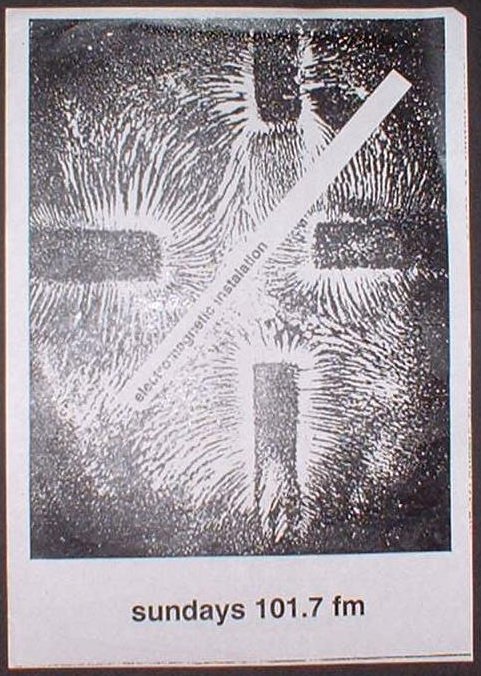
Bristol in the late 80s and early 90s was a dynamic and exciting place to be. Especially if one was creative and also interested in alternative ways of thinking and living. Independent culture was thriving. It was back in the 70s when Bristol’s radical spirit of creative and political autonomy was first forged. Post punk bands such as the Pop Group, Rip Rig & Panic, spread their own influential ethos of being creative and activist as a way of life. Advocating everyday people could be different, be independent thinkers and question the validity of the established norm. This flexible blueprint of being socially conscious in an imaginative way influenced a huge mixture of genres for years to come. Breaking down the borders between the audience and the musicians playing was a legacy handed on down from punk. This includes building your own record label, setting up your own pirate radio station, self publishing and other ventures.
Furtherfield’s first collective (yet unofficial) DIWO experience was at the Watermans Art Centre, London in 1999. We were asked to present a project which reflected the free and liberated spirit of our networked on-line community and its creative culture. The name of the project was called “Pasteups@Watermans Art Centre”, not DIWO. It had all the features of DIWO, such as using email as art, and the traditional postal services (snail mail) as part of its distribtion process. From all over the world people were invited to send images and texts which were then enlarged into a mass of photocopied posters.

On Sunday 10th October 1999 all the hoardings and wall spaces in the streets around the Watermans Art Centre were blitzed with Pasteups. There was no selection of what should be taken out or left in, everything was shown. They were put up by the Furtherfield crew and who ever wished to help out. Some of those whom took part were also local to the area. The people working in the centre reacted as if they were being over taken from a dark external force, and the passing public were expressing a mixture of emotions – enjoyment, surprise, interest, confusion, distaste and annoyance. It challenged the ideal of art having to be a rigid divide and rule of amateur vs professional, using the Internet and the physicalness of the Watermans Art Centre’s building, inside and outside. The streets were used as a shared canvas to fill our collective, imaginative expressions at that time.
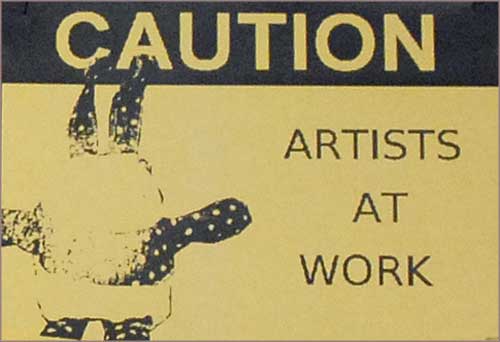
“”… the role of the artist today has to be to push back at existing infrastructures, claim agency and share the tools with others to reclaim, shape and hack these contexts in which culture is created.” [1] (Catlow 2010)
In her study ‘Empire of Dirt: The Aesthetics and Rituals of British Indie Music (Music Culture)’, Dr. Wendy Fonarow [2] investigated the UK’s indie music scene and its culture from the early 1990s to present. Below Fonarow presents the differences between mainstream and independent music culture. Contrasts are mapped out in Lévi-Straussian fashion:
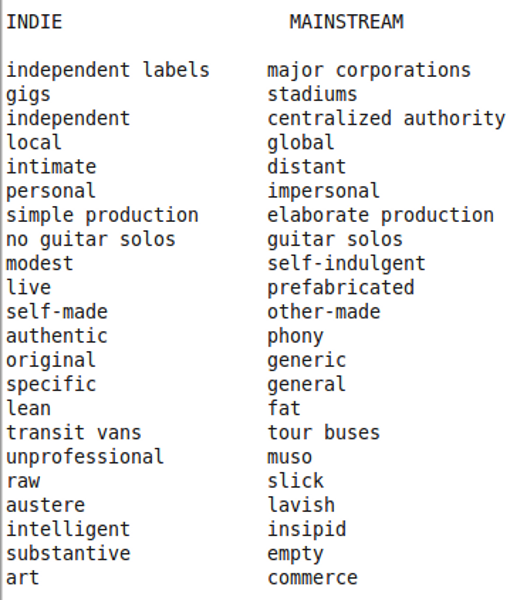
“Indie itself in relation to the mainstream as an opositional force combating the dominant hegemony of modern urban life. Any band that is seen as “chipping away at the facade of of corporate pop homogeny” (Melody Maker, April 1995) is a positive addition to the indie fellowship.”[3] (Fonarow 2006)
There are similar terms above as there is with critical practices in Media Art culture, Free and Open Source culture, activism and hacktivism, and with concepts behind DIWO. Words such as self-made, independent, raw and substantive offer strong relational ties to what we feel ourselves is essential for a thriving, discerning and critically aware process, of an unfettered state of discovering, and how to do things without conforming to top-down protocols, individually or collaboratively.
“To be an artist is to contend with the present, and there are not many other careers that afford the freedom to radically examine life and society. To put it bluntly, if artists are studying and writing more about politics, culture, and education, it’s probably a reflection of the unprecedented dysfunctionality of the societies in which they live.” [4] (Deck 2005)
When considering an art context, critical thinking on the social nuances, social and relational variants introduce possibilities for a deeper understanding of the meaning of a work and its place in the wolrd. Not only in respect of the quality of an artwork in its own right, but it also introduces consideration concerning value. Value comes out of dialogue whilst the work is put into motion, as the process occurs as well as when it reaches its final stage of being seen – it’s birth is always messy, but this process gives us the rich nutriants, the substance.
By recognising resonances that lurk between art and culture and our own connections with these elements; as we make things with others different core values come into play. This is where knowledge of how an artwork and its meaning communicates beyond the artwork itself; to and with others, linking up to the ever changing rhythms dominating society. All this, also depends on the context of how and where a work is seen. An artwork and where it is seen declares the artists’ relationship with other structures, infrastructures and networks, whether this be physical or based on-line. This informs us about the artists’ personal concepts, attitudes and social values. These attributes become part of the work; its story and part of its essence and its reasons for existing in the first place.
Whoever controls our art – controls our connection, relationship and imaginative experience and discourse around it. The frameworks and conditions where art is accessed, seen and discussed is significantly linked to representation and ownership. Socially and culturally, this process of abiding by specific rules and protocols defines who and what is worth consideration and acceptance. For art to be accepted within these ‘traditional’ frameworks a dialogue reflecting its status around a particular type of function kicks into place, it must adhere to certain requirements. Whether it is technological or using traditional art making skills the art itself must in some way conform to specific protocols before it can be allowed into the outer regions of ‘officially’ condoned culture. This process adds merit to the creative venture itself and feeds a systemic demand based around innovation in a competitive marketplace. If an iindividual or an collective does not abide by these dominating rules then they will not be seen in these frameworks. DIWO allows one to venture with many, in playful scenarios of mutual experience and interdependence, freeing up the trappings of ‘officially’ defined protocols and frameworks, governing our behaviours. This does not mean that there are no rules, it merely means that we have a more relationally informed understanding of how to work with others. Structures and aims are decided in different terms mutually.
DIWO is playful re-interpretation and fruition of some of the principles and reasons that Furtherfield was originally founded, back in 96-97. We had experienced as artists in the 80s and well into the 90s, a UK art culture mainly dominated by the marketing strategies of Saatchi and Saatchi. The same company was responsible for the successful promotion of the Conservative Party (and conservative culture) that had led to the election win of the Thatcher government in 1979. We felt that it was time to make a stance against these neoliberalist heavies controlling the art scene and our every day culture. Our aim was to move away from the typically established, sociallly engineered aspects of art culture where false credence was given to a few individuals over many others, based on their personalities alongside their depoliticized artworks.
“Furtherfield’s roots extend back through the resurgence of the national art market in the 1980s, to the angry reactions against Thatcher and Major’s Britain, to the incandescence of France in May 1968, and back again to earlier intercontinental dialogues connecting artists, musicians, writers, and audiences co-creating “intermedial” experiences.” [5] (Da Rimini 2010)
Our move away from this was to create pro-active alternatives, with social hacks, bypassing the marketing myth of the ‘genius’ as a product via the usually distracting diversions, and top-down imposed spectacles based on privilege and hegemony. Recently an article written by John A. Walker on the artdesigncafé web site, disucussed how art culture is still haunted by the power of Charles Saatchi.
“Arguably, as an art collector Charles Saatchi has become a brand in his own right—when he buys art works they and the artists who created them are immediately branded.” [6] (Walker 2010)
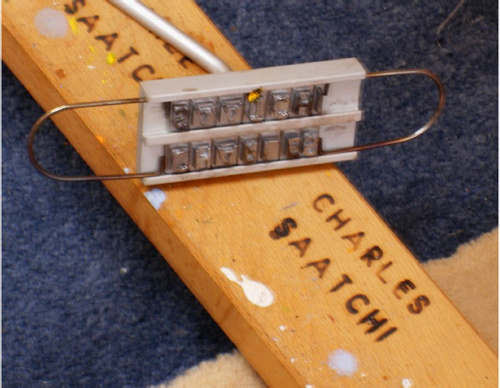
BritArt’s dominance of the late 80s and 90s UK art world dis-empowered the majority of British artists, and Smothered other artistic discourse by fuelling a competitive and divisive attitude for a shrinking public platform for the representation of their own work. Stewart Home proposes that the YBA movement’s evolving presence in art culture fits within the discourse of totalitarian art.
“The cult of the personality is, of course, a central element in all totalitarian art. While both fascism and democracy are variants on the capitalist mode of economic organisation, the former adopts the political orator as its exalted embodiment of the ‘great man,’ while the latter opts for the artist. This distinction is crucial if one is to understand how the yBa is situated within the evolving discourse of totalitarian art.” [7] (Home 1996)
By questioning the myths that dominate our actions we then become more empowered and confident to collaborate with others. We can only rediscover these inner creative kernals by critiquing the infrastructures dominating our behaviours. Many artists have and do conform to mainstream art world rules. This closes down space for a wider dialogue and experience for art practice to expand its possible horizons, beyond a handed down, hermetically sealed set of distant processes. When experimenting with alternative approaches of imaginative engagement a different set of values arrive. Through this we unearth things about ourselves which were already there but were trapped before by the mechanisms and mannerisms of mainstream culture and its dominant values.
DIWO (Do It With Others) is inspired by DIY culture and cultural (or social) hacking. Extending the DIY ethos with a fluid mix of early net art, Fluxus antics, Situationism and tactical media manoeuvres (motivated by curiosity, activism and precision) towards a more collaborative approach. Peers connect, communicate and collaborate, creating controversies, structures and a shared grass roots culture, through both digital online networks and physical environments. Stringly influenced by Mail Art projects of the 60s, 70s and 80s demonstrated by Fluxus artists’ with a common disregard for the distinctions of ‘high’ and ‘low’ art and a disdain for what they saw as the elitist gate-keeping of the ‘high’ art world.
The term DIWO OR D.I.W.O, “Do It With Others” was first used on Furtherfield’s collaborative project ‘Rosalind’ (http://www.furtherfield.org/get-involved/lexicon). An upstart new media art lexicon, born in 2004. DIWO was officially termed here in 2006 (http://www.furtherfield.org/lexicon/diwo)
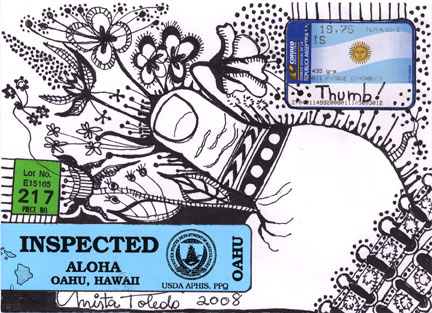
“It is in the use of the postal system, of artists’ stamps and of the rubber stamp that Nouveaux Realisme made the first gestures toward correspondence art and toward mail art.” [8] (Friedman 1995)
Mail Art is a useful way to bypass curatorial restrictions for an imaginative exchange on your own terms. With DIWO projects we’ve used both email and snail mail. Later, we will return to the subject of email art and how it has been used for collective distribution and collaborative art acitivies; but also, how it can act as a remixing tool and an art piece in its own right on-line and in a physical, exhibiting environment.
“[…] many Fluxus works were designed specifically for use in the post and so the true birth of correspondence art can arguably be attributed to Fluxus artists.” [9] (Blah Mail Art Library)
Many consider George Maciunas was to Fluxus, what Guy Debord was to Situationism. Maciunas set up the first Fluxus Festival in Weisbaden in Germany, 1962. In 1963, he wrote the Fluxus Manifesto in 1963 as a fight against traditional and Establishment art movements. In a conversation with Yoko Ono in 1961, they discussed the term and meaning of Fluxus. Showing Ono the word from a large dictionary he pointed to ‘flushing’.
“”Like toilet flushing!”, he said laughing, thinking it was a good name for the movement. “This is the name”, he said. I just shrugged my shoulders in my mind.” [10] (Ono 2008)
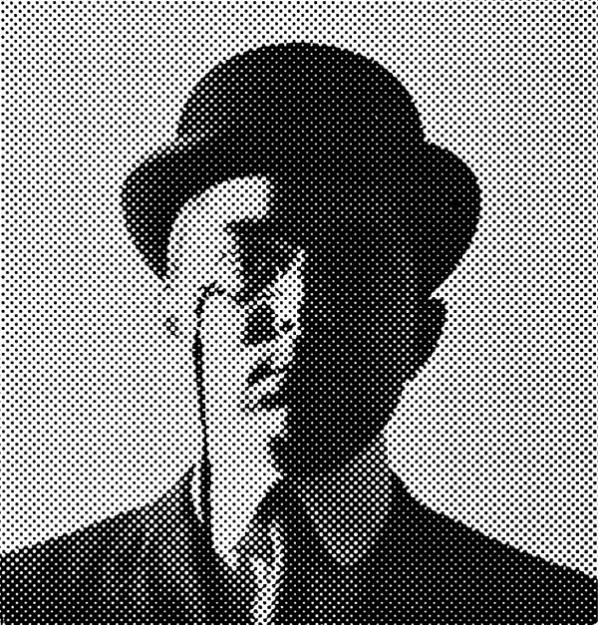
“The purpose of mail art, an activity shared by many artists throughout the world, is to establish an aesthetical communication between artists and common people in every corner of the globe, to divulge their work outside the structures of the art market and outside the traditional venues and institutions: a free communication in which words and signs, texts and colours act like instruments for a direct and immediate interaction.” [11] (Parmesani 1977)
Maciunas’s intentions and ideas are strongly based on creative autonomy. DIWO in the 21st Century explores its own position of (social) grounded reasoning and creative chaos. In contrast to the usual, standardized and bureaucratic implimentations by an increasingly banal, neoliberal elite controlling our art, education, media and economies.
“[…] art has become too narcissistic and self-referential and divorced from social life. I see a new form of participatory art emerging, in which artists engage with communities and their concerns, and explore issues with their added aesthetic concerns” [12] (Bauwens 2010)
“Marshall McLuhan once suggested that ‘art was a distant early warning system that can always tell the old culture what is beginning to happen to it'” [13] (Gere 2002) The infrastructural tendencies that occur when ‘the many’ practice DIWO; informs us we are in a constant process which redefines the role of the individual, and our notions of centralized power and behaviour. This process also presents us with critical questions around the value of art as scarcity. In moving away from our emotional attachment with the socially engineered dependencies based on consumer led forms of scarcity and desire, we then change the defaults. If we change the defaults we change the rules, no longer besieged by top-down defaults and open to more intuitive and relational contexts.
DIWO proposes in its fluid and sensual action of immediacy; situations where anyone can play and initiate collaborative and autonomous art. It is a radical creativity, asking questions through process and peer engagement, loosening infrastructural ties and frameworks as it occurs.
DIWO is a contemporary way of collaborating and exploiting the advantages of living in the Internet age. By drawing on past experiences with pirate radio, historical inspirations from Punk, with its productive move towards independent and grass roots music culture, as well as learning from Fluxus and the Situationists, and peer 2 peer methodologies; we transform our selves into being closer to a more inclusive commons. We transform our relationship with art and with others into a situation of shared legacy and emancipation.

“The network is designed to withstand almost any degree of destruction to individual components without loss of end-to-end communications. Since each computer could be connected to one or more other computers, Baran assumed that any link of the network could fail at any time, and the network therefore had no central control or administration (see the lower scheme).” [14] (Dalakov 2011)
Even though the web and DIWO possess different qualities they are both forms of commons. They both belong to the same digital complexity, and involve us connecting with each other. They are both open systems for human and technological engagement. DIWO rests naturally within these frameworks much like other digital art works or platforms and related behaviours, but possess key differences. If we consider the functions and structures of Facebook, Google, MySpace, itunes and now Delicious, they are all centralized meta-platforms, appropriating as much users as possible to repeatedly return to the same place.
“We see social media further accelerating the McLifestyle, while at the same time presenting itself as a channel to relieve the tension piling up in our comfort prisons.” [15] (Lovink 2012)
These meta-platfroms are closed systems. Not, necessarily closed as in meaning ‘you cannot come in’, but closed to others if you consider their motives and ‘acted out’ values, exploiting human interaction and their uploaded material, and openly ‘given’ data-information. These centralized meta-platforms close choices down through rules of ownership of personal data, as well as introducing more traditional standards of hierarchy, and limits one’s view and potential experience of the Internet.
Richard Barbrook and Andy Cameron saw this curious dichotomy way back in 1995. On one hand we had the dynamic energy of sixties libertarian idealism and then on the other, a powerful hyper-capitalist drive, Barbrook and Cameron termed this contradiction as ‘The Californian Ideology’. “Across the world, the Californian Ideology has been embraced as an optimistic and emancipatory form of technological determinism. Yet, this utopian fantasy of the West Coast depends upon its blindness towards – and dependence on – the social and racial polarisation of the society from which it was born. Despite its radical rhetoric, the Californian Ideology is ultimately pessimistic about real social change.” [16] (Barbrook and Cameron 1995)
Instead of submitting to an imperious process of allowing bland interaction own our behaviours; we propose an engagement where we can be more conscious and in control by exploiting further the real potential of the networks before us.
“We are not going to demand anything. We are not going to ask for anything. We are going to take. We are going to occupy.”[17] (RTS 1997)
Just like Reclaim the Streets which was an anti-car direct action movement seizing roads to prevent cars from being able to access them. Filling up public areas with thousands of bikes and using street parties as part of the political protest. We can loosen the gaze and spectacle of these propriety, meta-platforms and their dominance of our actions with others on the Internet. DIWO, is a way of thinking and acting differently, not an absolutist ‘technologically determined’ factor, but a thing of many things, and leans more towards a kind of social activism going as far back as The Diggers:
“The Diggers [or ‘True Levellers’] were led by William Everard who had served in the New Model Army. As the name implies, the diggers aimed to use the earth to reclaim the freedom that they felt had been lost partly through the Norman Conquest; by seizing the land and owning it ‘in common’ they would challenge what they considered to be the slavery of property. They were opposed to the use of force and believed that they could create a classless society simply through seizing land and holding it in the ‘common good’.” [18] (Fox)
Three elements pull DIWO together as a functioning whole, which can mutute according to a theme, situation or project. These three contemporary forms of (potential) commons mainly include; the ecological – the social – and the networks we use. By appropriating these three ‘possible’ processes of being with others; combined, they introduce and enhance potential for an autonomous and artistic process to thrive, further than the limitations of any single or centralized point of presence. It brings about small societal change, as long as we are conscious of the social nuances needed for a genuine and critically engaged, mutual collaboration.
“Online creation communities could be seen as a sign of reinforcement of the role of civil society and make the space of the public debate more participative. In this regard, the Internet has been seen as a medium capable of fostering new public spheres since it disseminates alternative information and creates alternativ (semi) public spaces for discussion.” [19] (Morell 2009)
In accordance with Mail Art tradition, DIWO began with an open-call to the Netbehaviour email list on 1st February 2007. The exhibition was at our older venue the HTTP Gallery, opening at the beginning of March. Every post to the list until 1st April was considered an artwork – or part of a larger collective artwork for the DIWO project. Participants worked across time zones, geographical and cultural distances with digital images, audio, text, code and software; they worked to create streams of art-data, art-surveillance, instructions and proposals, and in relay to produce threads and mash-ups.
One example of a work which exploited the data-steams of continual flow while over a hundred individuals participated and collaborated in DIWO in 2007, was X-ARN.org (Gregoire Cliquet, Laurent Neyssensas and Yann le Guennec). By using the dynamic exchange of the Netbehaviour email list as reliable exchange of regualr content, the net art group were able to perform their particular and unique processes of interaction, or intervention. It had no specific title, it was literally documenting the list’s networkked behaviour, and there were many of these networked visualizations made. They experimented with the net-specific aspects of DIWO’s mass artistic activity, forming digital mappings of this collected data or data-streams in ‘real-time’, as it all happened.

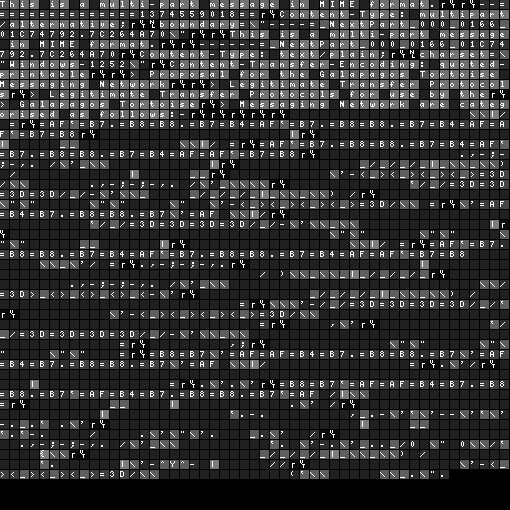
![[ARN / DIWO-Betatests 2007]](http://www.furtherfield.org/wp-content/uploads/2012/05/attachment3.png)
Some also participated in the experimental networked curation of the exhibition, facilitated by web cams, public IRC and VOIP technology. This co-curation event, or Curate With Others (CWO), as it was retroactively named, took place a week before the gallery opening. All subscribers to the NetBehaviour list were invited to contribute to the curation of the exhibition either by viewing the gallery floor plan and posting suggestions to the list or by taking part in the event; attending the gallery or joining the online meeting. Information about how to join the online event was posted to the list. During this event the spirit and philosophy of DIWO E-mail-Art were discussed, the deluge of diverse contributions by about a 100 people were reviewed, plinths, monitors and a drawing machine.
“The ‘Will Work For Food’ happening deals with the desire to find a new definition for labour and the act of working.” [20] (Jeron 2007)
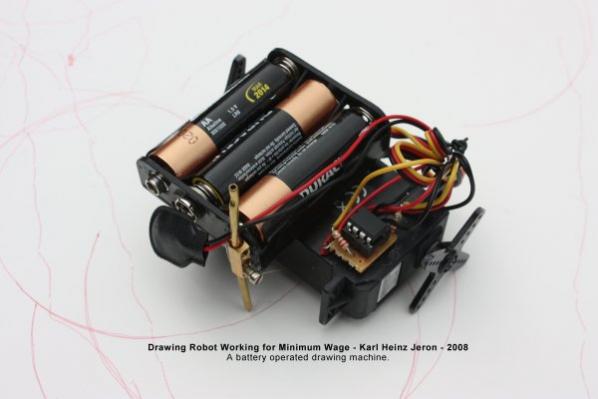
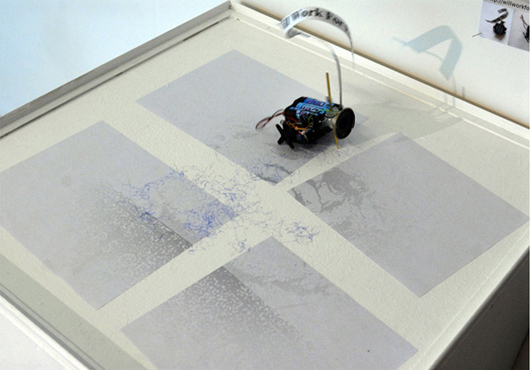
Karl Heinz Jeron’s drawing machine was a vehicle equipped with a ballpen run by rechargable batteries, and when turned on created random drawings. Jeron’s machine was not switched on, unless he received gifts in the post such as chocolates or any other form of economic support. After (thankfully) receiving various contributions in the post the image supplied by Jeron of Karl Marx would gradually be scribbled over.
This section of the Article is an edited version of a collaborative text by Ruth Catlow & Marc Garrett. Originally published on Vague Terrain in 2008. [21]
Present in the flesh were the Furtherfield.org crew and James Morris (regular, esteemed DIWO contributor).
Frederik Lesage manned the Public IRC and, as ‘DIWOchatbod’, who documented the conversation in the gallery for the benefit of those online co-curators who had trouble logging into Skype. Through the afternoon the online event was visited by eight people. The CWO event determined the format of the DIWO exhibition and the Furtherfield.org crew was charged with installing it. So, about approxximately 15 individuals on the day co-curated the setting up of the exhibition. Afterwards we informed everyone on the Netbeahviour list for any last minute details and suggestions and then continued with everything.
(Floorplan of Do It With Others (DIWO) at HTTP-Gallery, London. 2007)
The centerpiece of the exhibition was an e-mailbox containing all submissions; sorted and categorised for visitors to explore and redistribute by clicking ‘Forward Mail’. Streams and Themes displayed images, texts, sounds, code, and movies, primarily by single contributors (human and machine) as well as collections of themed posts or particular kinds of activity). Threads contained series of dialogic emails whose senders were remixing images, movies and code, most often in action and response). Other categories included Proposals and Instructions and Approaches to E-Mail Art.
(DIWO curated emailbox displaying image 3 tampered, posted by Chris Fraser 28/02/07)
Many of the themed folders and subfolders had their corollaries in the physical space of the gallery in the form of wiggly overlapping streams of printed images, pinned to the walls. Threads were represented by scrolls; one post after another in chronological order. A TV ran a video compilation, a sound compilation was played over four speakers, and two installation works were devised especially for the space. Karl Heinz Jeron’s ‘Will Work for Food’ and a print/projection mashup by Thomson and Craighead and Michael Szpakowski.
(Visitor to DIWO E-Mail Art at HTTP Gallery explores the DIWO email box. 2007. Image by Pau Ross)
All categories were liberally interspersed with off-topic discussion, tangents and conversational splurges so one challenge for co-curators was to reveal the currents of meaning, and emerging themes within the torrents of different kinds of data, process and behaviour. Another challenge was find a way to convey the insider’s – that is the sender’s and the recipient’s- experience of the work. These works then were made with a collective recipient in mind; subscribers to the Netbehaviour mailing list. This is a diverse group of people, artists, musicians, poets, thinkers, programmers (ranging from new-comers to old-hands) with varying familiarity with and interest in different aspects of netiquette and the rules of exchange and collaboration. This is reflected in the range of approaches, interactions and content produced. Before DIWO, extensive press releases were posted to different email lists, and online art platforms to join the Netbehaviour list to collaborate on the project.
(Lem Pollocked. By Lem Urtastik 16/2/07 / Created using Jackson Pollock artware by Miletos Manetas)
As with our previous experience of collective media arts ventures such as the first round of NODE.London Season of Media Arts (2006) [21] “we saw that lots of people invested with most enthusiasm in unstructured discourse; meandering and complex. This gave all participants a partial but meaningful view of the diverse contexts in which we worked, allowing us to make decisions about what our contribution could be. These many-to-many deep processes are never efficient but still invaluable to us in a culture where the pressures are always to be newer, faster, better-oiled, less philosophical, less human (ie less messy and complicated), more productive in the service of strategic overview.” (Garrett and Catlow) [ibid]
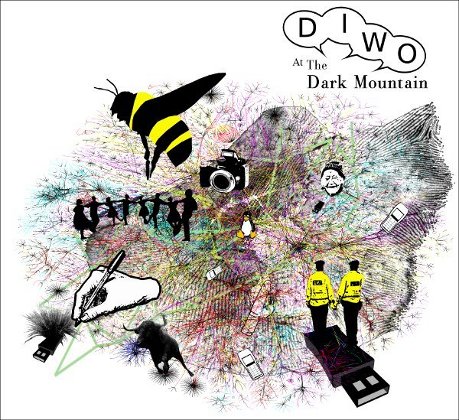
The next DIWO took place in 2009. It was called ‘Do It With Others (DIWO) at the Dark Mountain’. It was a collaboration between the then, newly formed ‘The Dark Mountain Project’, [22] Furtherfield and those participating in DIWO. A Dark Mountain manifesto grew out of a conversation between Paul Kingsnorth and Douglad Hine. It was an invitation to a new cultural response to the converging crises of climate change, resource scarcity and economic instability.
Paul Kingsnorth, in a letter to George Monbiot in the Guardian Newspaper which was also (openly) published by Monbiot said “As for saving the planet – what are we really trying to save, as we scrabble around planting turbines on mountains and shouting at ministers, is not the planet but our attachment to the western material culture, which we cannot imagine living without.” [23] The Dark Mountain Project wrote their Manifesto ‘UNCIVILISATION: the dark mountain manifesto’ “Old gods are rearing their heads, and old answers: revolution, war, ethnic strife. Politics as we have known it totters, like the machine it was built to sustain. In its place could easily arise something more elemental, with a dark heart.” [24] (DMP 2009)
The Dark Mountain Project has been viewed by many as apocalyptic, yet it also has grown in popularity these last few years. When discussing the project Hine says “Rather than treating these as distinct problems in need of technical solutions, we argued that they should be treated as symptoms of a deeper social and cultural crisis, a failure of the stories we have been telling ourselves for generations.” The Dark Mountain Project text was “addressed to other writers, and there is still a vein of Dark Mountain which is about finding new ways of writing, adequate to the times we are living through.” [25] (Hine 2009)
Kingsnorth and Hine both come from a literary background. Asking people to get involved in the project was a big ask.
DIWO E-Mail Art contributors in 2007 included: //indira, [–lo_y-], aabrahams, Alan Sondheim, Alexandra Reill, Allan Revich, Ana Valdes, Andre SC, Andrej Tisma, Ant Scott, arc.xolotl ARN, Aurlea, biodollsmouse, Bjorn Eriksson, Bjorn Magnhildoen, Blackmail, bob catchpole, bobig, brian@netart.org.uy, Camille Baker, Chris Fraser, Christphe Bruno, Clive McCarthy, cont3xt.net, Corrado Morgana, Daniel C. Boyer, dave miller, Denisa Kera, Dion Laurent, Eric Dymond, Edward Picot, Frederick Lesage, Geert Dekkers, Giles Askham, Giselle Beiguelman, Gregorios Pharmakis, Hans Bernhard, Helen Varley Jamieson, Hight, James Morris, janedapain, Jon Thomson, Jonathon Keats, Kanarinka, Kate Southworth, Lance W, Lauren A Wright, lem urtastic, Lewis LaCook, Lisa, Lizzie Hughes, Lorna Collins, Lucille C, Marc Garrett, Marc Cooley, Maria Chatzichristodoulou, mez breeze, Michael Szpakowski, Msdm, Neil Jenkins, patrick lichty, Paul Trevor, Regina Pinto, Riccardo Mantelli, Richard Osborne, rich white, Rosangela Aparecide da conceicao, Ruth Catlow, Sachiko Hayashi, Severn, Sim Gishel, Spread, Susana Mendes Silva, Taylor Nuttall, The Subversive Artist, Turbulence, Wolfgang, xavier cahen, zea.
There’s a splendid exhibition currently on at Manchester’s Cornerhouse. Entitled Subversion, it presents a selection of artworks, a good number of which are moving image pieces, from various artists who are united by a strong connection to the Arabic speaking world. We’re already in loaded territory, for all sorts of obvious reasons. Those reasons could give rise to a long discussion which I’m not going to approach directly here, instead simply quoting a programmatic statement from Glaswegian Egyptian-Turkish writer Omar Kholeif, the show’s curator:
‘Like many of the artists I was looking at, I felt that collectively curators and writers associated with the politically unstable Arab world were being asked to step up and perform to an identity that the world wanted us to play. With Subversion my aim was to do just the opposite. I worked with artists who referenced this very language but who wanted to dissent, poke fun, critique and re-define themselves as artists of the imagination, and not of any specific social or political condition.’
And, in case you’re wondering, he succeeds richly in this aim and, I think, more.
If you can get to Manchester with at least a couple of hours to spare before 5th June your life will be enriched thereby.
I’ve already written a short piece on the show, with a couple of video clips, on DVblog and I’ll be writing a longer review, including consideration of some of the thornier question alluded to above, for MIRAJ 4, out in June 2013.
What I’d like to do here is to look in some detail at one particular piece from the show, a short video by Khaled Hafez. I don’t mean to suggest that it is somehow best in show although I do love it – the show is too diverse for that kind of simple-mindedness. I do think a careful examination of it will yield support for Kholeif’s position. What we have here is a complex work of art, which bears repeated viewing, which doesn’t bend or break but thrives under that hard scrutiny and which, although inevitably stamped with the experiences, background, the moment in time, the physical location of its creator – what isn’t! – is universal (Problematic term! Of course we can’t know what 100 years will make of it but we can assert its current universality and adduce evidence that it is a work which promises to be of some long-term interest too.)
Hafez is probably better known as a painter of striking mash-ups of ancient Egyptian gods, comic book heroes, bodybuilders and models set against richly textured, feverishly beautiful and largely non-perspectival landscapes of the imagination. His paintings are characterised not only by this content (and of course what we lose in a run down of content is the aftermath of the act of painting, facture’s narrative, the play of line, geometry and colour. I’ve seen none of his pieces ‘in the paint’ but I’d bet money they’re good enough to eat.)
Furthermore, series, numbers, line-ups, multiples and queues of those Gods, comic book figures, bodybuilders and hybrids thereof seem to be important to him (and I don’t think I’m wrong in perceiving an echo of hieroglyphs and their implied grid and of pre-Arabic Egyptian art too).
There’s a strong sense of directionality and of motion arising from these lines and groupings and even if one knew none of the background it wouldn’t be surprising to learn of Hafez’s deep interest in moving image.
OK – to the piece itself. Let’s stay zoomed-out for a while and point out first that it was made in 2009, two years prior to the revolution which brought down Hosni Mubarak, exemplifying the ‘storm petrel’ effect whereby artists, who can often be infuriatingly ditzy as politicos, nonetheless, in virtue of their trade – their looking, their seeing, their empathy, empathy often of a strangely disinterested variety except for the can-I-make-art-from-it question, which question perhaps even makes their antennae the sharper, their sensitivity to society’s emotional weather, their readiness to make apparently random or intuitive connections – can be uncannily prescient about impending social change. Artists often ‘get it’ before the key actors begin to have the confidence to move.
So, you need to know that the piece contains so much reference to social conflict that, at first sight, to the outsider at least, it could have been made in the last year.
We start in darkness. Titles: “Anubis productions presents”. A number of soundtracks sewn together in a kind of faux short wave radio polyphony which resolves to a solo piano playing something doomily romantic which I don’t recognise (on subsequent listening it appears to be of a piece with the up-tempo stuff that follows, so I assume it’s especially composed). Over this we hear an extract from the resignation speech given by General Gamal Abdel Nasser in the immediate aftermath of the defeat in the six day war against Israel in June 1967. (He resigned for a day, coming back to office surfing a wave of popular support and grief and then ruling until his death in 1970).
I presume that to quote Nasser is a potent gesture in Egypt. I assume, despite any criticisms anyone might make of him he carries a ‘father of the nation’ type weight and that an allegorical comparison between him and Mubarak would come naturally – here is a flawed but somehow heroic figure, indubitably at the least a genuine anti-imperialist – offering his resignation, but, now, in stark contrast, his pale epigone, his inheritor as dictator but not as hero, clings grimly on by force and brutality and mired in sleaze.
The audio continues and we see more titles:
“The A77A Project (On Presidents and Superheroes)”
Hmm – presidents. In the plural.
Also: you don’t strictly need to know this, but it was gleefully explained to me by the artist that A77A is Egyptian blogger ‘slang’ in that it represents Arabic characters difficult to transliterate directly to Roman for the Arabic word for ‘Fuck’. Of which more soon.
The next thing we see is a detail of the lower centre of a painting by Hafez from the previous year, “Outside Temples”. We focus in on three figures seen in profile. They are almost identical except that whereas the two outer ones have the jackal heads of Anubis the central one wears… a Batman mask. They stand in profile, in body builder pose, right arms raised above and in front of the head forming a sinuous S curve to mirroring left arms behind the lower back.
We zoom into these figures as music changes to a metronomically regular disco drum and cymbal rhythm and the two rightmost figures ‘detach’ themselves from their background and walk forward out of frame to the right.
This detaching happens five times – series in time as well as space.
Three sets only of the figures then parade past us with the arms that had been set in the raised arm pose pumping up and down (crudely animated by pivoting at the shoulder, a similar device setting the legs in motion) in what I surmise is an offensive gesture. It is certainly charged with a raw and vulgar vigour. At this point the figures march against a plain white field – slowing the piece down reveals stray blocks of pixels generated in the animation process. This lack of polish, the retention of rougher edges, feels like a Brechtian distancing. It certainly helped to sharpen my attention as well as endowing the piece with a kind of elephantine grace.
We move to a landscape, I’m guessing a poorer or outlying area of Cairo, with a building site before us. Two of the figures continue their rightwards motion across the frame. They loom large against the background and even allowing for distance, dwarf the human figures behind them. Interestingly the background imagery appears to have been shot from a vehicle moving across the frame to the left, which further cranks up the energy level.
We cut to a 3D software generated mannequin walking in the same direction in a similar landscape. The two painted figures catch up and merge with it – by the somewhat clunky use of a split screen – giving birth to a single Anubis headed mannequin who is our protagonist for the rest of the piece.
The figure continues into a landscape dominated by a still of the Sphinx of Giza, ( Abū al Hūl, in Arabic, translating into English as The Terrifying One) which, in a move straight from Terry Gilliam, picks up the next words of the Nasser speech, ‘mouthing’ with a detached and hinged lower jaw . In the background, the ‘sky’ – in fact simply the background where the image has been cut out in Photoshop – cycles through various colours from a fierce red through multiple greys to black. As you might have surmised realism is not the key term here… except…except …there is a kind of higher realism going on… A pastiche of the stuttering effect so overused in popular music in the early days of sampling is applied to the ends of words in the speech – and here, in Nasser’s Arabic translated as ‘I decided to step down’, the bloggers’ A77A appears, repeated and repeated, a splendidly childish and satisfying equivalent to shouting ‘Fuck! Fuck! Fuck! Fuck! Fuck! Fuck! Fuck! Fuck!’
From now to the end every background image is a still and our Anubis – visitor from another realm, mostly an observer, bemused God in a world gone insane, who intervenes only once and then as a kind of trickster, stepping backwards to change a banner in English reading “Presidential Elections” to “Presidential Erections” ( and then the Arabic banner too – Hafez told me that, strangely, a small change will accomplish precsely the same transformation in both languages) but who pauses politely to allow a photographer to snap five women with cheesy shutter noise and all – processes inexorably rightwards through a number of frames of varying character: some, surreal collage: a man on a bike with a wheelbarrow on his head; some whose strangeness arises from a sophisticated deployment of the warped perspective arising from the lo-fi animation technique – another man-on-bike whose movement at an apparent 70 degrees ‘through’ the frame emphatically underlines the constructed nature of what we are watching followed by a subtle but delicious section where the background image is smaller than full frame size and Anubis steps decorously up into and then down out of it; some, more serious – confrontations between demonstrators and riot police, with the arm-pivot device once again deployed to enable a middle aged women make our putative vulgar gesture repeatedly to the cops.
Anubis finally vanishes into what I take to be a polling booth.
This is such a rich work. It is both enormously local and particular and at the same time hugely general. It is full of ‘content’ but at the same time driven by smart, knowing and dextrously deployed formal devices, which reside not in the background but near to the surface and greatly add to the pleasures of the piece, which presents weighty and serious matters, but does so with great geniality, a geniality and humanity I for one wish to firmly identify with the awakening oppressed as they genially, but definitively and unsentimentally, sweep aside and settle accounts with their former oppressors.
—–
This review is a collaboration between Furtherfield and DVBlog.
Watch the film on the DVBlog website

Sign up: ale[at]furtherfield.org
To accompany Invisible Forces, Furtherfield invites all gallery visitors to take part in a programme of public play, games, making and discussion led by alert and energetic artists, techies, makers and thinkers: Class Wargames, The Hexists, Dave Miller, Olga P Massanet and Thomas Aston.
Saturday 23 June 2012 – 1-5pm
Summer Board Games and Picnic with Class Wargames and Kimathi Donkor
Saturday 30 June 2012 – 1-5pm
Summer Board Games and Picnic with Class Wargames
Wednesday 04 July 2012 – 9-11am
3 Keys – The River Oracle – The Hexists
as part of Moving Forest by AKA The Castle
Wednesday 11 July 2012 – 11-5pm
Technologies of Attunement – Olga P Massanet and Thomas Cade Aston
Saturday 21 July 2012 – 2-5pm
Dave Miller’s Finsbury Park Radiation Walk
Featured image: Artist Suguru Goto discusses his work.
London 2012: there is of course one event which springs to mind when we think about this city and the year we’re in, but there is also another significant event happening in London right now, one which is very important for the digital and media arts world. It is the year that Watermans Arts Centre is holding the International Festival of Digital Art 2012.
As well as showcasing an array of digital art by internationally renowned artists, the programme also offers the opportunity for members of the public to get involved in discussions around themes that the Festival touches on through the seminar series accompanying the shows. These are in collaboration with Goldsmiths, University of London. Nearly three months in, the Festival has launched two exciting shows,Cymatics by Suguru Goto and UNITY by One-Room Shack Collective.
The first show, Cymatics, is a kinetic sound and sculpture installation that expresses Goto’s vision of nature. To enter it, the audience step through a door into a boxed, dark room within which they are presented with a touch screen interface, a shallow metal tank holding water and a screen showing a video feed of the water in the tank. The piece invites the audience to move the water in the tank by manipulating sound waves via an interactive screen. The result of the interaction is a stunning variety of geometric shapes, demonstrating the distortion that sound waves can have on a substance. This occurrence reveals the bridge between technology and nature, which fits into Goto’s re-occurring theme within his work of the relationship between man and machine.
The seminar which coincided with the show, Interactivity and Audience Engagement, was chaired by Régine Debatty and featured on the panel Tine Bech, Graeme Crowley and Tom Keene, all who which explore audience engagement in different ways within their work. Tine Bech is a visual artist and researcher whose installations invite audiences to engage in playful interactions, from chasing a motion reactive spotlight in Catch Me Nowto sound triggering shoes in Mememe. Tom Keene is an artist technologist whose focus intersects participation, communication and technology. His work is multidisciplinary, investigating the way we communicate, mediated by technology. His practice is diverse, from exploring the potential relationships between networked everyday objects in Aristotles Office to inviting a community to comment on their local issues through signs in Sign X Here. Graeme Crowley is a designer and artist who has created installations for prominent public areas, including The Wall of Light, commissioned by Arrowcroft Plc for the centre of Coventry and Spiral/Bloom commissioned for a hospital in Rochford by the NHS.
I found the juxtaposition of these three practitioners very interesting as each of them explore the interaction between audience and technology in varying ways. Bech’s work is very tactile and sculptural, almost making people forget the technology behind it. She likes to look at technology as something we can mould and which can be used to explore the wider issues which art can bring up, rather than just focussing on the tech itself and how ‘shiny’ (to use her own term) it is. In contrast to this, within Keene’s practice technology feels very prominent, visually as well as conceptually. Crowley’s focus is different again as it mostly operates within the commercial sphere. It therefore is produced for greater public consumption and needs to withstand being a permanent exhibit, becoming part of the architecture it is planted on rather than something which is temporary. The talks given by each panel member and discussions which accompanied them were all diverse and brought up interesting points around the idea of audience engagement and interactivity. Members of the audience entered into these discussions with ease, creating an open dialogue which itself was participatory and engaging.
UNITY, by One Room Shack is the current exhibit as part of the International Festival of Digital Art 2012, bringing a piece of work to the gallery which aims to embody the Olympic spirit, visually as well as conceptually.
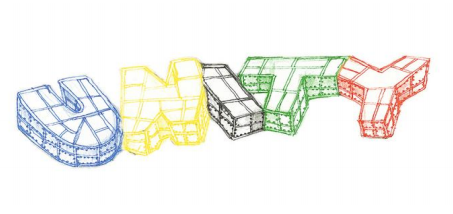
Design for Unity
The installation takes the form of a transparent maze, angular in its structure and illuminated with different coloured LED lights in each section. Each illuminated section of the structure forms a different letter, all together spelling the word ‘unity’. As the audience navigate their way through the installation, their movement is picked up by motion sensors, triggering the LEDs at each point to turn on. These each represent a particular colour of the Olympic rings.
The ideologies of the Olympic Games linked with an immersive space explores the value of ‘being together’, something which the African humanist philosophy Ubuntu also speaks about.
UNITY is effective in exploring the theoretical concepts embedded within it through a playful and simple interactive structure. As an individual you step from section to section with the different groups of LEDs individually illuminating you as you go through the work. When a group of people interact with the piece at the same time however, the piece lights up as a whole, echoing the values of being together that UNITY invites us to explore. It is through enabling this experience, that the work celebrates and explores human connections.
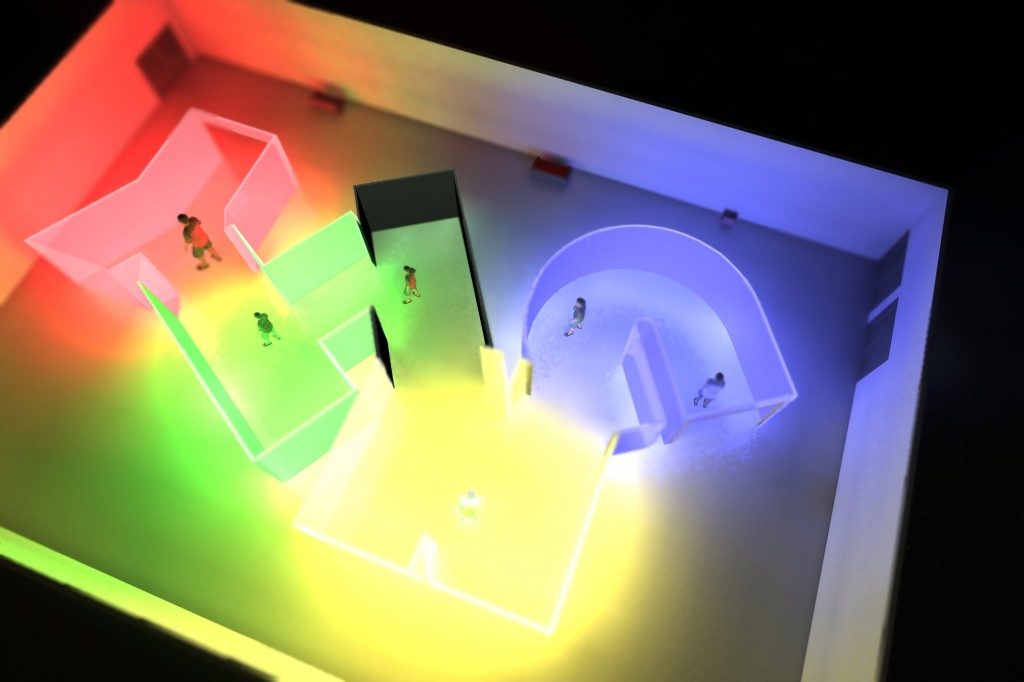
I do find it interesting how the piece has such a strong stance towards the more idealistic ideologies of the Olympics, especially when taking into account the anti Olympics sentiment present in London. The event does bring people together, but unfortunately as we’ve seen in East London and also at previous Olympic locations across the globe, they also have the ability to put local communities at risk through rising rents and eviction [1]. UNITY looks at ‘…understanding the implication of UNITY on humanism in a neo-liberal world where hyper-capitalism and love of excess trump compassion and selflessness.’ [2] but in reality, the Olympics have unfortunately become something which arguably embody these traits. This said, I do think that UNITY is an incredibly beautiful piece in its visual execution and that its interaction compliments the theoretical idea which it is looking to address.
I look forward to the remainder of the International Festival of Digital Art 2012 and the eclectic ideas within media and digital art which the programme explores. I interviewed Irini Papadimitriou, Head of New Media Arts Development at Watermans, about the Festival:
Emilie Giles: First of all, can you tell us what the premise is behind the International Festival of Digital Art 2012?
Irini Papadimitriou: The idea behind the Festival started from a decision to develop a series of shows that could form a discussion rather than being one-off exhibitions and help engage more people in the programme. In the last year we have been focusing more in participatory and/or interactive installations so I thought it’d be interesting to dedicate this project and discussions in exploring more ideas behind media artworks that invite audience engagement as a way of understanding our work in the past year.
Since this was going to take place in 2012 we felt it would be necessary to open this up to international artists so this is how the open call for submissions came up last year. We received so many great proposals it’s been very hard to reach the final selection, but at the same time the opportunity of having a year-long festival meant we could involve as many people as possible and hear many voices not only through the exhibitions (this is just one part of the Festival) but also with other parallel events such as the discussions, presentations of work in progress by younger artists and students, the publication, a Dorkboat (coming up in June with Alan Turing celebrations), as well as collaborations with other organisations or artists’ networks and online.
EG: Touching on your last answer, the Festival has a clear aim then to engage people in discussion rather than just being viewers of a show. Do you think that within media and digital art there is a particular need for this approach?
IP: I think that hearing people’s thoughts and responses and enabling discussion is important for all exhibitions and art events but specifically for the Festival (since the aim is to question & explore audience participation). It was very relevant to hear ideas and views from other artists, technologists, practitioners etc but also audiences, rather than just the participating artists.
Also, and this is my view, I think as media and digital art use technologies that many of us are not particularly familiar with or if we use technologies it will be most probably as consumers, it’s important to talk about and discuss the process (as well as impact of technologies) both for the artists as well as for audiences.
EG: The themes chosen for the programme are diverse and each relevant to media and digital art in their own way. What are the reasons for each focus and why?
IP: The themes explored in the Festival result mainly from the selected proposals and discussions with the artists. There were so many things to talk about so having these themes was a way to start from somewhere and help understand better the installations shown throughout the year. The seminars that we are organising are an opportunity for the artists to talk about their work and share their ideas with both audiences but also with other artists invited to take part in the panels. It is also a way of discussing these themes and presenting other work that raises similar issues. The seminars are shaped around the themes such as perception and magic in digital art, sound and gesture, geographies, virtual spaces as artistic mediums and of course participation and interaction. We are currently working on a publication with Leonardo Electronic Almanac which will be coming out in the next couple of months and will include essays from artists, academics and students as well as interviews with the artists behind the selected proposals. Again the catalogue has the Festival themes as a starting point but we tried to combine different content and ways of communicating these.
EG: How do the pieces featured in the exhibition question audience engagement, participation and accessibility ?
IP: The artists presenting work are exploring participation and audience engagement in different ways and I think we will have also interesting outcomes from the seminars and the publication which will allow us to explore these ideas further.
In the current installation, UNITY, One Room Shack collective are using the playful structure of a maze (in the form of the word UNITY with each letter lighting up in the colours of the Olympic rings) inviting people to walk inside to reflect and draw upon the complex nature of human reality and ‘difficult’ aspects of human existence.
Michele Barker and Anna Munster who will be showing HokusPokus later on are interested in exploring how we perceive actively in relation to our environment, how we see, what we see and how this makes us ‘interact’. HokusPokus inspired from neuroscience examines illusionistic and performative aspects of magic to explore human perception, movement and senses. The tricks shown in HokusPokus have not been digitally manipulated; they will unfold temporally and spatially, amplifying and intensifying aspects of close-up magic such as the flourish and sleight of hand.
The Festival will close with an installation by American artist Joseph Farbrook, Strata-Caster, which was created in Second Life mirroring the physical world, exploring positions of power, ownership, identity and drawing parallels between virtual and physical worlds. An interesting and important part of the installation is the use of a wheelchair by visitors to enter and navigate Strata-Caster.
EG: How have the 2012 Olympic and Paralympic Games inspired the Watermans International Festival of Digital Art?
IP: As we are trying to explore what participation is we thought it would be an interesting link (rather than inspiration) between the Festival and the Games/Cultural Olympiad since they are meant to symbolise, promote and inspire values like creativity, collaboration, participation, engagement etc. The Festival isn’t about the Olympics and participating artists didn’t have to propose work that linked to the Games, but we did receive many proposals that reflected on the Games, what they represent and the meaning of participation, so some of these proposals are being shown as part of the Festival, such as One Room Shack’s UNITY and Gail Pearce’s Going with the Flow.
How can designers and programmers work more harmoniously? How can the tools being created better meet the needs of users? There is a need for designers to have a greater role in the production of the tools that they use, aside from just reporting bugs, requesting features or designing logos for open source projects. This is where the Libre Graphics Research Unit comes in. The Libre Graphics Research Unit (LGRU) is a traveling lab where new ideas for creative tools are developed. The unit has grand aims, looking to bring aspects of open source software development to artistic practices. The programme, sponsored by many organisations in Europe, is split into four interconnected threads:
The first meeting, Networked Graphics, took place in Rotterdam from 7-10 December, 2011 and was Hosted by WORM. This second meeting, Co-Position, for which I was present, took place at venues across Brussels from 22-25 February 2012. Co-Position is described by LGRU as:
[…] an attempt to re-imagine lay-out from scratch. We will analyse the history of lay-out (from moveable type to compositing engines) in order to better understand how relations between workflow, material and media have been coded into our tools. We will look at emerging software for doing lay-out differently, but most importantly we want to sketch ideas for tools that combine elements of canvas editing, dynamic lay-out, networked lay-out, web-to-print and Print on Demand.
The meeting saw the coming together of many international artists, theorists and developers for four days of work around this subject. As some of the sessions of the meeting took place simultaneously I’m unable to give a full synopsis of the event. Instead, what is presented below are some of the key issues raised at the meeting.
The subject of copyright cannot be avoided when discussing digital art and collaborative practices. There is a definite need to foster a safe and welcoming environment for artists and designers to produce, share and remix their work. Licensing of artwork under Copyleft licences – such as Creative Commons – helps to create this environment.
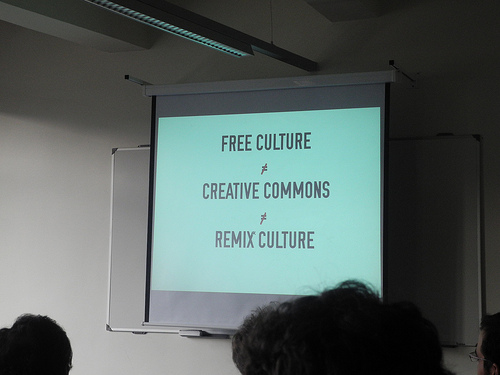
In his presentation, entitled “Libre Workflows – A Tragedy In 3 Acts”, Aymeric Mansoux was quick to point out that Creative Commons licences do not cover the source of the artwork. To put it into context, a JPG is covered by a Creative Commons licence but is the XCF/PSD file? Mansoux also considered what is actually a finished piece of artwork? In a remix culture is an artwork ever finished? Mansoux refers to this quote from Michael Szpakowski for further elaboration:
I’ve found it helpful to think of any artwork, be it literary, visual art or music as a kind of fuzzy four dimensional manifold. So the “complete” artwork is the sum of all its instances in time, and all epiphenomena. The entire artwork, seen this way, is a real and precisely enumerable sum, a concrete, not imaginary, set, which could be knowable in its entirety by something long lived and far seeing enough.
From their home town of Porto, Portugal, Ana Carvalho and Ricardo Lafuente produce Libre Graphics Magazine with ginger coons who is based in Toronto, Canada. For the production of the magazine they use Git, with their repository being hosted on Gitorious. As a tool for sharing files between collaborators Git is very useful. However, they explained that they feel they are not making effective use of all that Git has to offer. Part of this comes from the complexity of using Git. There are more than 140 commands in Git, each with their own unique function. These are usually entered via the command-line, but there are a number of programs with a Graphical User Interface (GUI) available. Programs with a GUI are usually favoured over command-line programs as they remove some of the complexity. Carvalho and Lafuente have found, however, that many of of these GUI programs simply replace commands with buttons, which doesn’t remove any of the complexity in using Git. What is needed is an easy to use specialised tool for the production of art.
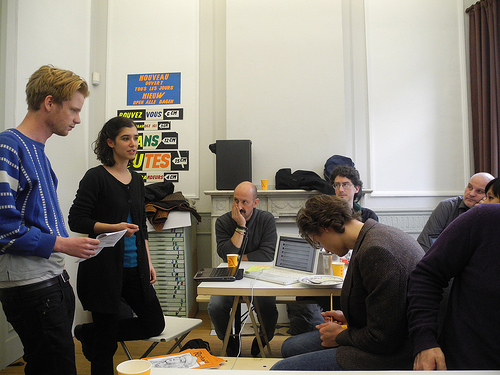
In this work session, presented by Ana Carvalho and Eric Schrijver, the work group imagined how to adapt existing version control tools to meet the needs of artists and designers. The session began by taking a look at how people currently implement version control. A common practice is to manually make backups, renaming files to differentiate between stages. This can be an effective way of making different versions, but it doesn’t address other issues such as making comparisons or merging changes. The ineffectiveness of these manual methods is soon very apparent. The work group was introduced to the Open Source Publishing (OSP) Visual Repository viewer, which begins to respond to some problems with current version control systems by providing thumbnails of files in a repository.
Using this as a basis we began to look at other functions that the OSP Visual Repository viewer should have, such as the ability to compare graphical files in different ways and to revert back to previous versions or merge versions. Although there was no time to produce working code we did seek to address the complex task of merging and comparing not only the ouput file but also the working files (svg/xcf/psd).
Every good work of software starts by scratching a developer’s personal itch.
This quote from The Cathedral and the Bazaar by Eric Steve Raymond could not be more accurate in describing the motivations behind the development of Laidout, developed by Tom Lechner, a comic artist from Portland, Oregon. Perhaps one of the most impressive software demonstrations of LGRU, Laidout is a program for laying out artwork on pages with any number of folds, which don’t even have to be rectangular.
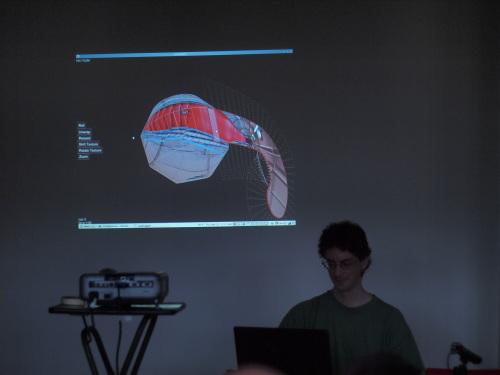
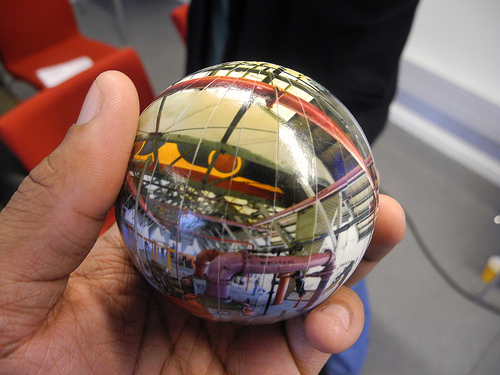
In an attempt to devise new tags that can be added to the SVG specification, Michael Murtaugh and Stephanie Villayphiou presented a work session that looked at the different ways language is interpreted by both humans and computers. To address this the work group took part in a task that saw them act as an interpreter of commands. With nothing more than a list of tags used in SVG files the work group would attempt to construct shapes.


The results varied from person to person and highlighted an important question: How can computers interpret ambiguity
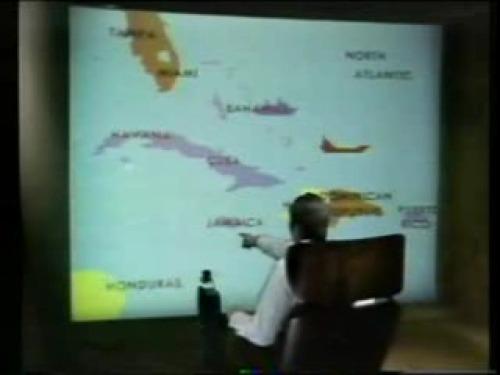
Using the Richard A Bolt “Put that there” demonstration, Murtaugh showed how human-computer interaction is still based around using very clear, unambiguous commands that can be easily interpreted by computers. In SVG only the most basic of shapes – rectangles, circles and lines – are represented. But, as the work group participants asked, could there be tags to represent more complex shapes, such as a horse?
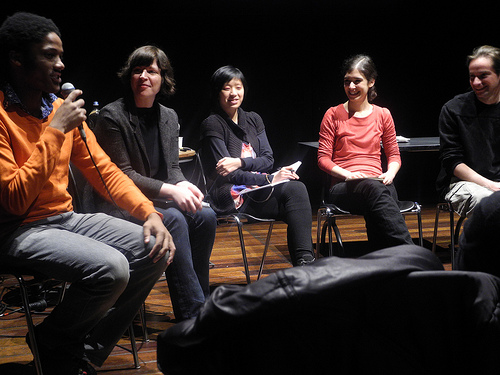
On the final day of the meeting I took part in a roundtable discussion, chaired by Angela Plohman and featuring myself, Stephanie Vilayphiou, Camille Bissuel and Ana Carvalho. The discussion first went over all that we had achieved over the four days at the meeting, and then the discussion focused on how and why we share our artwork. Expanding on the earlier quote from Szpakowski, how can we make sharing all of our artwork – including the early stages and inspirations behind it – an easier and integrated part of making artwork? In addition to sharing our final, “finished” artworks do we want to also share our processes and ideas behind the artwork? More importantly, can software easily aid this?
Other topics debated in the discussion revolved around opening up our artwork and processes to others. By opening up the development process of our artwork do we do so to invite collaborators and contributions or just observers? The Blender Open projects, for example, are highly regarded as an example of the work that can be made using open source software. The files used to make these projects are are released upon completion of the project, but the development process remains closed to the team of artists and developers. Would opening up this process to contributors add any value or could having too many ideas dilute the original vision of the project.
Although no conclusions around these topics were made, it was nonetheless important for everyone at the meeting to think critically about their practice
A concern of mine is that research is not always acted up on and exciting possibilities exist only as theory. However, I feel that the approach of Libre Graphics Research Unit, which combines research and practice, will ensure that the work undertaken at the meetings is implemented. It is actively working with developers and users to try and create solutions.
At the Co-Poistion meeting not one final product was made, but the initial vision for the future of layout was formed.
The next meeting, Piksels and Lines, takes place in Bergen, Norway and is organised by Piksel.
“It is not accidental that at a point in history when hierarchical power and manipulation have reached their most threatening proportions, the very concepts of hierarchy, power and manipulation come into question. The challenge to these concepts comes from a redsicovery of the importance of spontaneity – a rediscovery nourished by ecology, by a heightened conception of self-development, and by a new understanding of the revolutionary process in society.” Murray Bookchin. Post-scarcity and Anarchism (1968).
The rise of neo-liberalism as a hegemonic mode of discourse, infiltrates every aspect of our social lives. Its exponential growth has been helped by gate-keepers of top-down orientated alliances; holding key positions of power and considerable wealth and influence. Educational, collective and social institutions have been dismantled, especially community groups and organisations sharing values associated with social needs in the public realm. [1] Bourdieu.
In this networked society, there are controversies and battles taking place all of the time. Battles between corporations, nation states and those who wish to preserve and expand their individual and collective freedoms. Hacktivist Artists work with technology to explore how to develop their critical and imaginative practice in ways that exist beyond traditional frameworks of art establishment and its traditions. This article highlights a small selection of artists and collaborative groups, whose work is linked by an imaginative use of technology in order to critique and intervene into the opressive effects of political and social borders.
In June 2000, Richard Stallman [2] when visiting Korea, illustrated the meaning of the word ‘Hacker’ in a fun way. When at lunch with some GNU [3] fans a waitress placed 6 chopsticks in front of him. Of course he knew they were meant for three people but he found it amusing to find another way to use them. Stallman managed to use three in his right hand and then successfully pick up a piece of food placing it into in his mouth.
“It didn’t become easy—for practical purposes, using two chopsticks is completely superior. But precisely because using three in one hand is hard and ordinarily never thought of, it has “hack value”, as my lunch companions immediately recognized. Playfully doing something difficult, whether useful or not, that is hacking.” [4] Stallman
The word ‘hacker’ has been loosely appropriated and compressed for the sound-bite language of film, tv and newspapers. These commercial outlets hungry for sensational stories have misrepresented hacker culture creating mythic heroes and anti-heroes in order to amaze and shock an unaware, mediated public. Yet, at the same time hackers or ‘crackers’ have exploited this mythology to get their own agendas across. Before these more confusing times, hacking was considered a less dramatic activity. In the 60s and 70s the hacker realm was dominated by computer nerds, professional programmers and hobbyists.
In contrast to what was considered as negative stereotypes of hackers in the media. Steven Levy [5], in 1984 published Hackers: Heroes of the Computer Revolution [6]. In three parts, he writes about the canonical AI hackers of MIT, the hardware hackers who invented the personal computer industry in Silicon Valley, and the third-generation game hackers in the early 1980s. Yet, in this publication, what has had the most impact on hacker culture and is still used widely as a guideline by many is the ‘hacker ethic’. He identified this Hacker Ethic to be a code of practice consisting of key points such as that “all information is free”, and that this information should be used to “change life for the better”.
1. Access to computers—and anything which might teach you something about the way the world works—should be unlimited and total. Always yield to the Hands-on Imperative!
2. All information should be free.
3. Mistrust authority—promote decentralization.
4. Hackers should be judged by their hacking, not bogus criteria such as degrees, age, race or position.
5. You can create art and beauty on a computer.
6. Computers can change your life for the better.
Levy’s hacker ethic promotes the idea of performing a duty for the common good, an analogy to a modern day ‘Robin Hood'[ibid]. Proposing the concept that hackers are self-reliant whilst embracing a ‘healthy’ anti-authoritarian stance, combined with free and critical thinking. Proposing that hackers should be judged by their ability to hack, and presenting hacking as an art-form. Levy also says that the Free and open source software (FOSS) movement is the descendant of the hacker ethic. However, Levy’s hacker ethic has often been quoted out of context and misunderstood as to refer to hacking as ‘breaking’ into computers. This specifically prescribed role, denies the wider and creative context of what hacking is and could be. It does not have to be just about computer security.
This leads us to ‘crackers’. All crackers hack and all hackers hack. But, crackers are seen as second rate wannabe hackers by the older generation of hackers. The Black Hat Hacker or cracker designs and releases malicious code, gathers dangerous information and brings down sensative systems. The White Hat Hacker hunts down and destroys malicious code, and the casual hacker who hacks in order to learn information for his or her own curiosity; both generally dislike ‘Black Hats’ and ‘Crackers’, and tend to view them as computer criminals and dysfunctional juveniles. Lately, crackers have also been labeled as ‘script kiddies’. As a kind of snobbish insult, it refers to those who are not capable of building or programming their own tools, but tend to use scripts and programs written by others to perform their intrusions. To add to the confusion we also have the term ‘Grey hat’. Which refers to a hacker acting between black hat and white hat. Indeed, this could demonstrate where art hacktivists reside, challenging the trappings of the traditional concept of goody and baddy.
“There is another group of people who loudly call themselves hackers, but aren’t. These are people (mainly adolescent males) who get a kick out of breaking into computers and phreaking the phone system. Real hackers call these people ‘crackers’ and want nothing to do with them.” [7] Raymond.
“The basic difference is this: hackers build things, crackers break them.” [ibid] Raymond.
But before we judge,
let’s view a snippet of the \/\The Conscience of a Hacker/\/ by +++The Mentor+++
Written on January 8, 1986.[8]
“This is our world now… the world of the electron and the switch, the
beauty of the baud. We make use of a service already existing without paying
for what could be dirt-cheap if it wasn’t run by profiteering gluttons, and
you call us criminals. We explore… and you call us criminals. We seek
after knowledge… and you call us criminals. We exist without skin color,
without nationality, without religious bias… and you call us criminals.
You build atomic bombs, you wage wars, you murder, cheat, and lie to us
and try to make us believe it’s for our own good, yet we’re the criminals.”
The term ‘Hacktivism’ was officially coined by techno-culture writer Jason Sack in a piece about media artist Shu Lea Cheang published in InfoNation in 1995. Yet, the Cult of the Dead Cow [9] are also acknowledged as defining the term. The Cult of the Dead Cow are a group of hackers and artists. They say the Hacktivism phrase was originally intended to refer to the development and use of technology to foster human rights and the open exchange of information.
Hacktivism techniques include DoS attacks, website defacement, information theft, and virtual sabotage. Famous examples of hacktivism include the recent knocking out of the PlayStation Network, various assistances to countries participating in the Arab Spring, such as attacks on Tunisian and Egyptian government websites, and attacks on Mastercard and Visa after they ceased to process payments to WikiLeaks.
Hacktivism: a policy of hacking, phreaking or creating technology to achieve a political or social goal.
“Hacktivism is a continually evolving and open process; its tactics and methodology are not static. In this sense no one owns hacktivism – it has no prophet, no gospel and no canonized literature. Hacktivism is a rhizomic, open-source phenomenon.” [10] metac0m.
The practice or behaviour of Hacktivism is at least as old as Oct 89 when DOE, HEPNET and SPAN (NASA) connected to (virtual) networked machines world wide. They were penetrated by the anti-nuclear group WANK worm.
WANK penetrated these machines and had their login screens altered to…
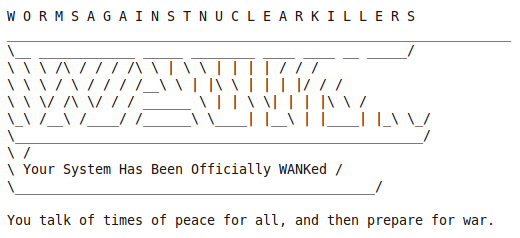
HACKING BORDERS: Examples of Art Hacktivism & Cultural Hacking…
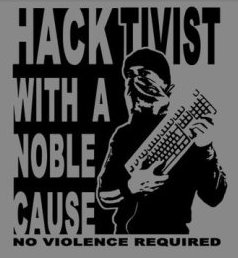
“Radical groups are discovering what hackers have always known: Traditional social institutions are more vulnerable in cyberspace than they are in the physical world. And some members of the famously sophomoric hacker underground are becoming motivated by causes other than ego gratification.” [11] Harmon.
Hacktivism, exploits technology and the Internet, experimenting with the immediacy of distributable networks as a playful medium for independent, creative and free expression. There has been a gradual and natural shift from net art (and net.art) into Hacktivism. Net Art in spirit, has never really been just about art being viewed on a web browser alone. Some of the very same artists whose artwork involved being shown in browsers and making code behind the browser as part of the art, have also expanded their practice outside of the browser. One such artist is Danja Vasiliev, “Fifteen years ago WWW was something very new in Russia and besides the new dial-up aesthetics and world-wide means it brought a complete new layer of existence – “netosphere”, which made my youth.” Vasiliev very soon moved on from playing with browsers into a whole new territory. [12]
Danja co-founded media-lab moddr_ in 2007, a joint project at Piet Zwart Institute alumni and WORM Foundation. Based in Rotterdam moddr_ is a place for artists and hackers, engaging with critical forms of media-art practice. He collaborated with Gordan Savicic and Walter Langelaar from the moddr.net lab on the project Web 2.0 Suicide Machine, which lets you delete your social networking profiles and kill your virtual friends, and it also deletes your own profile leaving your profile image replaced by a noose.”The idea of the “Web 2.0 Suicide Machine” is to abandon your virtual life — so you can get your actual life back, Gordan Savicic tells NPR’s Mary Louise Kelly. Savicic is the CEO — which he says stands for “chief euthanasia officer” — of SuicideMachine.org.” [13]
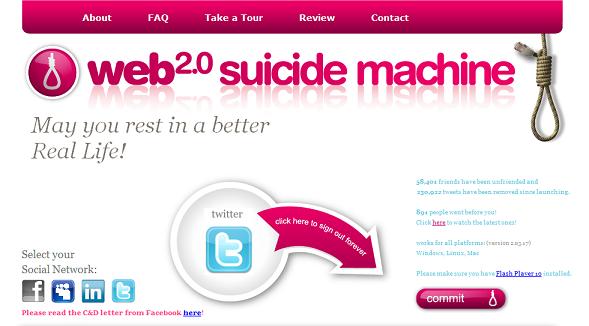
Just like another project called ‘Face to facebook’ that stole 1 million facebook profiles and re-contextualized them on a custom made dating website (lovely-faces.com), set up by Italian artists Paolo Cirio and Alessandro Ludovico, whom also just so happens to be editor in chief of Neural magazine. Web 2.0 Suicide Machine, had to close its connections down regarding its Facebook activities after receiving a cease and decease letter from Facebook. [14]
Julian Oliver and Danja Vasiliev teamed up and formed the mysterious group Men in Grey. The Men In Grey explore our online vulnerabilities by tapping into, intervening into wireless network traffic. Observing, tracing and copying what we do. This hack then redisplays our activities back to us, showing the data of our online interactions.
At first no one (except myself & a few others) knew who they were. When they first arrived on the scene I started an interview with them and then suddenly, I was asked to hold back due to their antics on the Internet and interventions in public environments receiving much coverage. They were not sure how it would pan out for them. Partly due to the anonymous nature of their project, and also because of the sudden impact of the larger hacktivist group Anonymous getting much press in commercial media themselves.
“Men In Grey emerge as a manifestation of Network Anxiety, a fearful apparition in a time of government wiretaps, Facebook spies, Google caches, Internet filters and mandatory ISP logging.” M.I.G
“Spooks are listening into calls, just like they always have,” said Eric King of London’s Privacy International, in an e-mail. “With A5/1 being broken—you can decrypt and listen into 60 calls at once with a box smaller than a laptop.” [15]
Later they won the Golden Nica (1st prize) Interactive Arts category, Prix Ars Electronica in 2011. In a show called Project Space — M.I.G. — Display of unknown, quarantined equipment hosted at the Aksioma Project Space Komenskega, Ljubljana 2011. The statement read:
“The particularly threatening quality of the Men In Grey equipment is its apparently invasive nature; it seems able to penetrate – and even hack into – virtually any electronic device in its reach. While we are all aware of the wire-tapping and data retention done by the government (along with the spying carried out by corporations like Facebook and Google), Men In Grey seem to operate with a range of tools and techniques well beyond those that are currently known to be in use.”
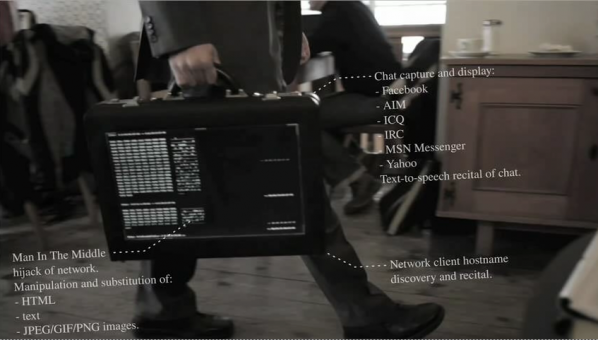
Hacktivism involves many different levels of social intervention and engagement. Whether it is to do with direct action, self-referential geekiness, obscure networked antics, crtical gaming, or peer 2 peer and collective change. Hacktivists challenge defaults put in place by other people, usually the systems imposed upon them and the rest of us by authority. Even though the subjects themselves may be concerning serious matters, humour and playfulness are both essential ingredients.
“A promising tactic for the early Situationists was the unpredictable yet forceful potential of play — what anthropologist Victor Turner termed the “liminoid,” or the freeing and transformational, moments of play when the normal roles and rules of a community or society are relaxed.” [16] Dovey & Kennedy.
One group crossing over from the digital into physical and social realms, is Tiltfactor. [17] Their form of intervention is not necessarily about causing political controversy, but is engaged in reaching people through games of play. Experimenting with social everyday contexts, making games that tackle less traditional topics, such as public health, layoffs, GMO crops. One of the many games creating awareness on these subjects, is POX “Our game actually helps a player understand how a disease can spread from one place to another and how an outbreak might happen” says Mary Flanagan. [18]
A local public health group called Mascoma Valley Health in the New Hampshire region of the US approached Tiltfactor with the problem of the lack of immunization. “At first, a game about getting people immunized seemed like one of the most “un-fun” concepts imaginable. But that sinking feeling of impossibility almost always leads to good ideas later.” [19] Flanagan.
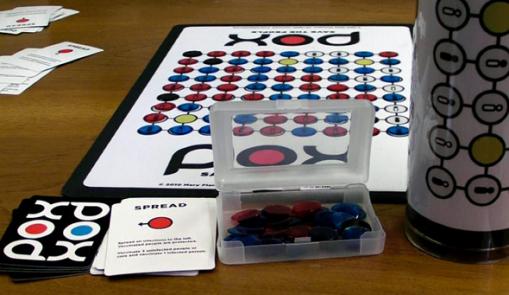
“Geopolitical space has always been a conflicted and fragile topic. Borders and frontiers are changing so fast, that sometimes it seems that our sociopolitical status can change from “citizen” to “immigrant” from one moment to another, or simply live under the “immigrant” status all your life. We’re getting used to words like refugees, enclaves, war, borders, limits –and the list has no end.” Ethel Baraona Pohl & César Reyes
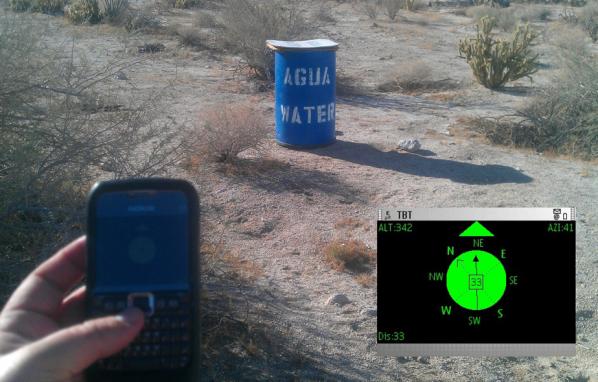
Ricardo Dominguez collaborated with Brett Stalbaum, Micha Cardenas, Amy Sara Carroll & Elle Mehrmand, on (TBT) (and others), on a hand-held mobile phone device that aids crossers of the Mexico-US border. An inexpensive tool to support the finding of water caches left in the Southern California desert by NGO’s for those crossing the border.
“The entire group of artists who are part of Electronic Disturbance Theater 2.0/b.a.n.g. lab working on the Transborder Immigrant Tool (TBT) was being investigated by UCSD and 3 Republican Congressmen starting on January 11, 2010. Then I came under investigation for the virtual sit-in performance (which joined communities statewide against the rising students fees in the UC system and the dismantling of educational support for K–12 across California) against the UC Office of the President (UCOP) on March 4, 2010. This was then followed by an investigation by the FBI Office of Cybercrimes.” [20] Ricardo Dominguez.
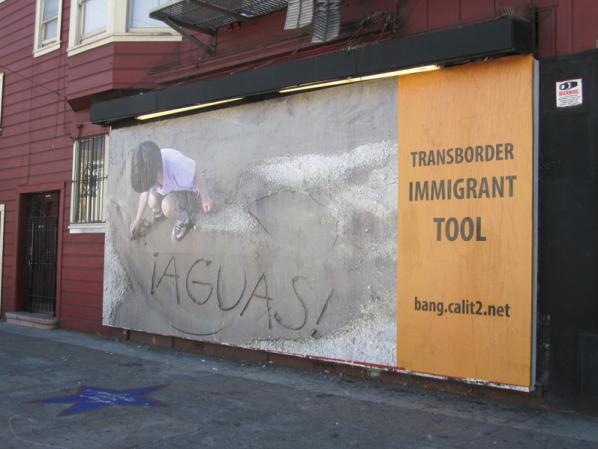
In an interview with Lawrence Bird Dominguez discusses that the TBT is still developing as a gps tool, but infers that it is not just a tool but also ‘border disturbance art’, consisting of different nuances existing as part of a whole with other factors at play. Such as a hybrid mix of things, objects and expressions “artivism, tactical poetries, hacktivism(s), new media theater, border disturbance art/technologies, augmented realities, speculative cartographies, queer technologies, transnational feminisms and code, digital Zapatismo, dislocative gps, intergalactic performances, [add your own______].” [ibid]
“Borders are there to be crossed. Their significance becomes obvious only when they are violated – and it says quite a lot about a society’s political and social climate when one sees what kind of border crossing a government tries to prevent.” [21] Florian Schneider
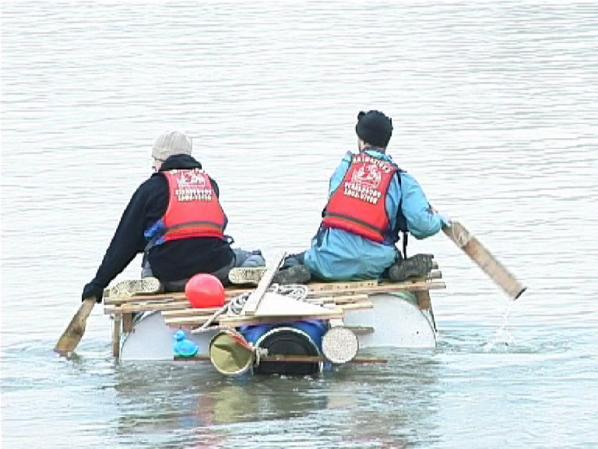
National borders are front-lines of political and social friction. The exerience of asylum-seekers and political migrants reflect some of the most significant issues of our time. Immigration is a toxic issue and unpopular with voters. Bunting’s BorderXing Guide, plays on the fear of invisible alien hordes of people crossing our borders illegally.
The context of this work fits well with issues about borders, whether it is about creating borders online or physical environments. Only those needing to cross a border are allowed access to the site, it is limited to ‘social clients’ who have a static IP (Internet Protocol) address and who, most notably, have gained the artist’s confidence. Such as peer activists and immigrants using libraries, colleges, cultural centres. The site allows those who would other wise end up crossing borders in harmful ways, such as in containers, on the backs of (and underneath) lorries and planes.
Heath Bunting’s BorderXing Guide website primarily consists of documentation of walks that traverse national boundaries, without interruption from customs, immigration, or border police. The work comments on the way in which movement between borders is restricted by governments and associated bureaucracies. It is a manual written not at distance like a google map, but by foot. A physical investigation, involving actually going to these places; trying these discovered routes out and then sharing them with others. A carefully calculated politics of public relations.
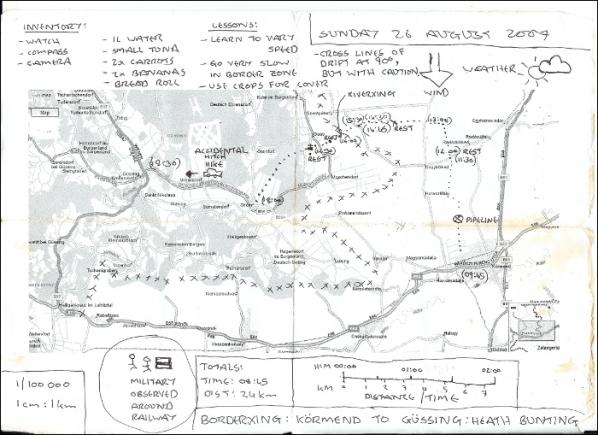
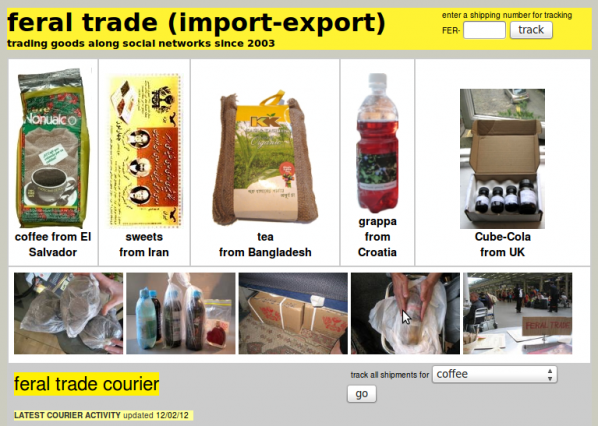
“The Feral Trade Café is more than just an art space that’s a working café, it’s about provoking people to question the way big food corporations operate by looking at the journey of the food we end up scraping into our pampered bins.” [22] Gastrogeek
Feral Trade uses social and cultural hand baggage to transport food based items between cities, often using other artists and curators as mules. Feral Trade products (2003-present), alongside ingredient route maps, bespoke food packaging, video and other artefacts from the Feral Trade network. The goods rangefrom coffee from El Salvador, hot chocolate from Mexico and sweets from Montenegro, as well as locally sourced bread, vegetables and herbs.
Kate Rich uses the word ‘feral’ as a process refering to being deliberately wild, as in pigeon, as opposed to romantic nature wild as the wolf. It is an unruly wild, shitting everywhere, disruption and annoyance in contrast to ‘official’ human structures and connected infrastructures. Feral Trade freight operates largely outside commercial channels, using the surplus potential of social, cultural and data networks for the distribution of goods. Working with co-operatives, small growers and food producers.
The Feral Trade Courier is a live shipping database for a freight network running outside commercial systems. The database offers dedicated tracking of feral trade products in circulation, archives every shipment and generates freight documents on the fly.
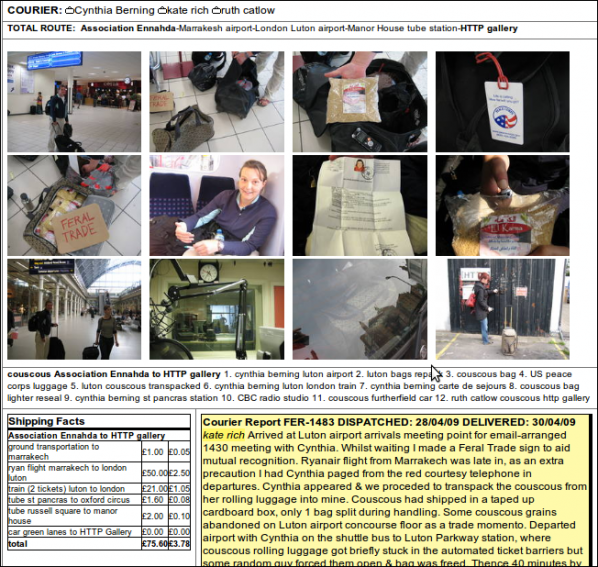
Every shipment is different and has its own story of how and where it was delivered from. Also included is information on who the carriers are with details about producers and their local culture as contextual information. The product packaging itself is also a carrier of information about social, political context and discussions with producers and carriers.
![Feral Trade at Furtherfield's Gallery (2009) [23] Link to exhibition](http://www.furtherfield.org/wp-content/uploads/2012/03/3657297700_42b1c26014_b.jpg)
Since the rise of the Internet individual and collective actions are symbiotically connected to the every day. In a world transformed, common people have access to tools that can change ‘our’ cultures independently; sharing information, motivating actions and changing situations. We know of the Arab Spring, the Occupy movement, Anonymous and Wikileaks and how successful they have been in exploiting technology and social networks. Technology just like any other medium is a flexible material. By tweaking, breaking and remaking ‘something’ you can re-root it’s function, change its purpose.
The links between these mass social movements and the artists here are not just relating to technology’s use but, a shared critique at the same enemy, neo-liberalism.
“”Neo-liberalism” is a set of economic policies that have become widespread during the last 25 years or so. Although the word is rarely heard in the United States, you can clearly see the effects of neo-liberalism here as the rich grow richer and the poor grow poorer.” [24] Martinez & Garcia.
At the same time as highlighting the continual privatization of human society. This form of art practice shows us the cracks of where a social divide of gate-keeping has maintained power within the Western World’s, traditional art structures. We now realize that the art canons we have been taught to rely on as reference are more based around privelage, centralization and market dominance rather than democratic representation or even just pure talent. Hacktivist artists adapt and recontextualize with a critical approach, towards a larger and more inclusive context beyond their own immediate selves. Demonstrating a respect and use of autonomy, and an awareness of social contexts and political nuances, freeing up dialogue for new discussions which include a recognition of social contexts, as a vital ingredient and valued resource in art. Re-aligning, reconfiguring the defaults of what art is today.
Lies, Lawlessness and Disbelief 1. Thinking Art and Capital: Conceptual Capitalism and Risk Management, is the first of five essays by Canadian artist & critical thinker, Katie McCain. McCain discusses how capitalism has become on the one hand all encompassing and on the other utterly unreal. Arguing that we need to be prepared to think the impossible so that resistance is able to grow.
DOWNLOAD the full text (including all 5 parts) here.
An Attempt at Thinking Art and Capital: Conceptual Capitalism and Risk Management
this sentence is a lie[1]
Capitalism is no longer the simple fordist system of production and consumption. It has, in its post-fordist lifetime become a more and more complex and intangible form. Today, it is a conceptual capitalism that has become unmoored, free floating, and all encompassing. As it continues, capital has the amazing ability to subsume everything it encounters, including criticism and resistance.[2] This proliferation seems to leave little room to resist – there is no longer a way to step outside and critique, since the death/failure of really existing socialism,[3] but this means only that critique must come from within, which is no small feat. It is a method riddled with paradox and self-defeat, but this perhaps reflects the nature of capital itself – as a system it offers up many moments of fissure or collapse that can be manipulated. The vastness of capitalism and the complexity of the bureaucracy necessary to hold together a system of “order” that directly contradicts chaos theory inevitably begins to circle and break down. It is these moments of circuity, of fissure, that this essay will focus on.
Contemporary capitalism is conceptual capitalism – it runs on the idea of money in the form of loans, mortgages, hedge funds, junk bonds; it is fictional money and a fictional market based on an elaborate system of risk management, which implies some intrinsic (but impossible) knowledge of the future. It also seems that this fictional market can be bolstered by belief alone. ‘The financial crisis of 2008 showed enormous sums of money spent not on a real, concrete problem, but rather to restore belief in the market. Capital, in all its intangible forms, is the Real of our lives’.[4]
If what Žižek states is true, and capitalism can be equated with Lacanian theory of the Real[5], it again seems to close down access to it further still. It is opposed to reality, which encompasses the Imaginary and the Symbolic and it is located beyond them, out of reach, but exerting influence. It is undifferentiated, without fissure, always in its place.[6] It is impossible to imagine, to verbalize, to integrate in the Symbolic order. But perhaps this impossibility is the moment, the fissure, which can bring about its demise.
The signification of the Real is attempted in the Symbolic order, but is impossible. The Symbolic structures everything, and through repetition is subject to the death drive. That is, in its constant return to enjoyment the Symbolic transcends beyond pleasure in search of death. This could be seen as some radical call to accelerationism, a desire to weaponize capitalism against itself, and in a way it is, but not in the apocalyptic sense that accelerationism implies, pushing it to its extreme.[7] Rather, a radicalism could exist in simply exploiting these impossibilities, finding weak points in rationality, and the supposed rationality of capitalist systems, in its inherent bureaucracy.
This Symbolic capitalism is contingent in regards to the Real; it does not spring from it[8], but is created out of a desire to verbalize the impossible, to understand something that is impossible to understand, to socialize this intangible system. It could be said that it is impossible to speculate on the origins of the Symbolic once it is in place, generated as it is from a primal prohibition, a negation, le-nom-(non)-du-pere[9]; once capitalism is in place, it becomes impossible to see an alternative to the universe it creates.[10] This is mostly due to the all-encompassing nature of conceptual capitalism. Perhaps then, the ability to catch it in a paradox, in a state of bureaucratic failure, could open up a space to trip it up and think other and could offer a passage a l’acte.
other other other say it three times in the mirror
Employing the idea of a contingent conceptual capitalism, that is, one which is not necessary, which is indifferent to existence, one can argue that in fact it is very possible to think of the other to capitalism. It is logic and rationality that trips it up, that prevents any thought of the alternative, just as it is strictly impossible to think infinity, or an ancestral time prior to human existence. Science can prove facts about both ancestral time and descendant time (prior to and after the death of consciousness), but philosophy is paradoxically stuck with the idea of a relation to the world before or after the existence of thought[11]. How can thought think the death of thought?[12] According to Hakim Bey it is impossible to really conceive of death – it appears rather as ‘an unpleasant vagueness’[13] – the death considered is never actual death. Similarly, how can one think anti-capital from within conceptual capitalism? If it is permitted that both the universe and capitalism are contingent, and therefore completely indifferent to human existence and human thought, then the possibility for alternatives opens up.
A speculative and realistic approach to thinking capital can restore our ability to resist.
Once it is granted that the tension between equality and liberty cannot be reconciled and that there can only be contingent hegemonic forms of stabilization of their conflict, it becomes clear that, once the very idea of an alternative to the existing configuration of power disappears, what disappears also is the very possibility of a legitimate form of expression for the resistances against the dominant power relations.[14]
If conceptual capitalism encompasses everything, there is less and less physical space for resistance, unless resistance moves into the conceptual realm as well. The idea, the imaginary, the psychical: these all offer a variety of forms of resistance to a boundless capital. For the concept, in its true dematerialized form, is capable of altering systems, of bolstering illogic, of predicting the future. It is the very boundaries of thought, beyond which lies psychosis (the lack of the Symbolic, or capital) that prove to be integral in terms of non-knowledge and the unknown, a knowledge of the unknown, or a thinking of the impossible. Perhaps lies, fiction and the radical un-real can be the site of production for a capitalist alternative.
Ideas are characterized as both distinct and obscure. They are distinct insofar as they are perfectly differentiated via the reciprocal determination of relations and the complete determination of points – but obscure because they are not yet differenciated – since all Ideas coexist with one another in a state of virtual perplication.[15]
Ideas are simultaneously two things, distinct and obscure. Graham Harman introduces the idea as something not only possible, but actual insofar as an idea is thought as an image. This introduces all things possible to the realm of the actual, even if only in thought.[16]
The contemporary mantra of risk management as a fundamental economic strategy is in itself paradoxical. If, in fact, a risk could be managed, then it would not really be considered a risk. This term depends on the belief in an organized system of capitalism that extends both directions through time – the idea that it is a constant that can be depended upon, is predictable, forever. In fact, the amount of bureaucracy that goes into even the tiniest element of conceptual capitalism manifests itself through many circular moments, many points of fissure. In compatibility with Gödel’s Theorem of incompleteness, no system can be totally defined without incurring some kind of paradox. There will always be statements that are true, but that cannot be proved within the system. If the system is capable of proving certain basic facts, then one particular truth the system cannot prove is the consistency of the system itself.[17]
Risk management is nothing more than a reaffirmation of our collective belief in the predictive qualities of financialization, our collective consent to the idea that an intangible, unmoored, all-encompassing economic system can be predicted. In fact, prediction alone is a falsity that humans fall prey to frequently; the notion of the future as anything other than a continuation of the past is a mental operation at which the mind continues to fail. When thinking of tomorrow, the mind just projects another yesterday.[18] The future, or rather a human relation to the future, is deemed philosophically impossible. After all, how can consciousness think something devoid of consciousness?[19]
It is impossible for thought to think an object or event in-itself – in this sense, thought can only experience a relation between the subject and the object-as-given. Lacan argues in his fifth discourse that we do not derive libidinal enjoyment from object relations, but rather it is capital’s link of subject-to-object that frustrates and isolates the subject. Capitalism is successful in the sense that it produces a continual desire, but no longer satisfies it, which for Lacan – and a world full of neurotics – falls in line with our drives.[20]
Lacan also reorients Marx’s analysis of surplus value. An older, more tangible form of capitalism sold objects for more than it cost to make them. This ‘surplus value’ is what Marx stated that the capitalists stole from the proletariats – it was used by the capitalists for leisure or libidinal enjoyment. Now, capital demands this surplus value to be re-invested at the level of production to create an unrelenting, perpetual motion machine of production and consumption of money by a business in-itself. We are now, according to Lacan, all proletariats, subject to the will of capital that has taken over the role of master from the capitalists themselves.[21]
The debt circulates on its own orbit, with its own trajectory made up of capital, which, from now on, is free of any economic contingency and moves about in a parallel universe (the acceleration of capital has exonerated money of its involvements with the everyday universe of production, value and utility). It is not even an orbital universe: it is rather ex-orbital, ex- centered, ex-centric, with only a very faint probability that, one day, it might rejoin ours.[22]
This faint probability is the only thing tying us to capital.
Adorno, Theodor.W. Negative Dialectics. Translated by E.B. Ashton. New York: Continuum, 2005. First Published 1966 by Suhrkamp Verlag.
Associated Press. “Romanian Witches Curse Latest Government Clampdown,” The Guardian, February 9, 2011, main section, 20.
Bartlett, Monica Y., Aida Cajdric, Nilanjana Dasgupta and David DeSteno, “Prejudice from Thin Air: The Effect of Emotion on Automatic Intergroup Attitudes.” Psychological Science 15, no. 5 (May, 2004): 319-324.
Baudrillard, Jean. Global Debt and Parallel Universe. Translated by Francois Debrix. http://www.egs.edu/faculty/jean-baudrillard/articles/global-debt-and-parallel-universe/ (accessed April 4, 2011).
Baudrillard, Jean. Radical Thought. Translated by Francois Debrix. Edited by Sens & Tonka. Paris: Collection Morsure, 1994.
Bey, Hakim. T.A.Z.: Temporary Autonomous Zone, Ontological Anarchy, Poetic Terrorism. New York: Autonomedia, 2003. First Published 1985.
Bradley, Will. “Guarana Power.” in Self-Organization/Counter-Economic-Strategies, edited by Bradley, Hannula, Ricupero and Superflex, 311 – 333. New York: Steinberg Press, 2006.
Brassier, Ray. “I Am a Nihilist because I Still Believe in Truth” Interview with Marcin Rychter. Kronos: March 4, 2011 http://kronos.org.pl/index.php?23151,896 – accessed: march 23rd, 2011.
Brassier, Ray. Nihil Unbound: Enlightenment and Extinction. Basingstoke: Palgrave McMillan, 2007.
Critical Art Ensemble. Marching Plague: Germ Warfare and Global Public Health. New York: Autonomedia, 2006.
Declercq, Frédéric. Lacan on the Capitalist Discourse: Its Consequences for Libidinal Enjoyment and Social Bonds. Psychoanalysis, Culture & Society 2006, 11, (74-83).
Fisher, Mark. Capitalist Realism: Is There No Alternative? Winchester: Zero Books, 2009.
Foucault, Michel. Power/Knowledge: Selected Interviews & Other Writings: 1972-1977. New York: Pantheon Books, 1980.
Fromm, Erich. The Fear of Freedom. London: Routledge & Kegan Paul Ltd., 1966.
Groys, Boris “Art and Money,” E-Flux 24 (2011), http://www.e-flux.com/journal/view/226.
Harman, Graham. Circus Philosophicus. Winchester: Zero Books, 2010.
Hofstadter, Douglas R. Gödel, Escher, Bach: An Eternal Golden Braid. London: Penguin Books Ltd., 1979.
Holt, Jim. “The Way We Live Now: Against Happiness,” New York Times, June 20, 2004.
Horizon: What is Reality? Documentary. Directed by Helen Shariatmadari. BBC: ep. 9, 2011.
Huberman, Anthony, ed. For the Blind Man in the Dark Room Looking for the Black Cat that Isn’t There. St. Louis: Contemporary Art Museum St. Louis, 2009.
Huxley, Aldous. Brave New World. London: Vintage Books, 2007. First published 1932 by Chatto & Windus.
K-Punk Blog. http://k-punk.abstractdynamics.org/archives/004421.html
Kafka, Franz. The Castle. Middlesex: Penguin Books Ltd., 1964. First published 1926 by Das Schloss.
Kurant, Agnieszka and Nassim Nicholas Taleb. “Unknown Unknowns: A Conversation between Agnieska Kurant & Nassim Nicholas Taleb about the Benefits of Uncertainty.” Frieze, September 2010, 127 -135.
Lacan, Jacques. “Seminar on the Purloined Letter.” Yale French Studies 48 (1972): 39-72.
Lacan, Jacques. The seminars of Jacques Lacan: Book II: The Ego in Freud’s Theory and in the Technique of Psychoanalysis 1954-1955. Ed: Jacques-Alain Miller. New York: W. W. Norton and Co., 1991.
MacKinnon, Catharine A. “Feminism, Marxism, Method and the State.” Chicago Journals 8, no. 4 (1983), 635-658.
Meillassoux, Quentin. After Finitude: An Essay on the Necessity of Contingency. London: Continuum, 2008.
Mouffe, Chantal. The Democratic Paradox. London: Verso, 2000.
Noys, Ben. Persistence of the Negative: A Critique of Contemporary Continental Theory. Edinburgh: Edinburgh University Press, 2010.
Place, Vanessa and Robert Fitterman. Notes on Conceptualisms. New York: The Ugly Duckling Presse, 2009.
Stephen, Kylie. “Sexualized Bodies.” in Real Bodies: A Sociological Introduction, edited by Evans and Lee, 29-45. Basingstoke: Palgrave MacMillan. 2002.
Taleb, Nassim Nicholas. The Black Swan: The Impact of the Highly Improbable. London: Penguin Books Ltd., 2007.
Thacker, Eugene. “Nihil Unbound” review of Nihil Unbound: Enlightenment and Extinction, by Ray Brassier, Leonardo 42: no.5, (2009): 459-460, http://muse.jhu.edu/journals/leonardo/v042/42.5.thacker.html (Accessed April 2, 2011).
The Trap: What Happened to Our Dream of Freedom? Documentary. Directed by Adam Curtis. BBC Two: March 2007.
Trotta, Roberto. “Dark Matter: Probing the Arche Fossil.” Interview with Robin Mackay. Collapse: Philosophical Research and Development 2 (2007): 83-169.
Vidal, John. “Bolivia Enshrines Natural World’s Rights with Equal Status for Mother Earth.” The Guardian. April 11, 2011. Main section, 15.
Weaver, Matthew. “Romanian Witches to Cast Anti-Government Spell.” The Guardian. January 7, 2011. Main section, 23.
Wilson, Eric G. Against Happiness. New York: Sarah Critchton Books, 2008.
Žižek, Slavoj. First as Tragedy, Then as Farce. London: Verso, 2009.
Žižek , Slavoj. The Iraqi Borrowed Kettle. http://www.lacan.com/zizekkettle.htm (accessed April 4, 2011).
Žižek, Slavoj. What Rumsfeld Doesn’t Know that He Knows About Abu Ghraib. (2004) http://www.lacan.com/zizekrumsfeld.htm (accessed April 4, 2011).
Featured image: Martijn de Waal, co-founder of The Mobile City, introduces the conference (image courtesy Virtueel Platform)
On Feb. 17th Amsterdam hosted Social Cities of Tomorrow, a conference on new media and urbanism. Adapting its title from Ebenezer Howard’s Garden Cities of Tomorrow, but taking equal inspiration from the work of Archigram, the conference presented a snapshot of the direction cities are moving today: as conventional means of planning and designing are renegotiated through our engagement with new media technologies:
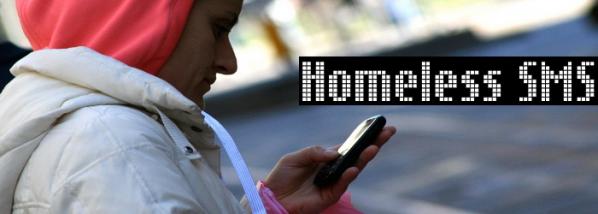
Organized by The Mobile City and Virtueel Platform, the event showcased best-practise examples of the use of media in urban analysis, design, art and activism. These ranged from “Homeless SMS”, a text-messaging system designed to provide information to the 70% of homeless Londoners who own cell phones; “Amsterdam Wastelands”, an on-line mapping of disused sites in Amsterdam and Zaanstad; “Koppelkiek”, a game project in which residents of a troubled area of Utrecht collected “couple snapshots” (in couples of friends, relatives or complete strangers), promoting social interaction through play; and “Urbanflow”, and New York-based project to rethink the contents of urban screens. In all, a dozen such projects were presented at the conference.
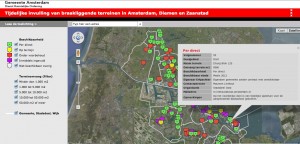

http://www.socialcitiesoftomorrow.nl/showcases
Immediately preceding the conference an intensive three-day workshop took place at ARCAM, the Amsterdam Centre for Architecture. This event brought together two dozen interdisciplinary creatives from around the world to tackle urban issues in four current case-studies: Haagse Havens, Den Haag; Zeeburgereiland; Strijp-S Eindhoven; and the Amsterdam Civic Innovator Network (a proposal to open up Amsterdam’s civic resources to distributed control by citizens). Working with local stakeholder organizations, the participants brainstormed how to leverage new media to solve intractable or new problems in these real-world sites.

http://www.socialcitiesoftomorrow.nl/workshop/the-four-cases
Also at ARCAM, a roundtable discussion on the alternative forms of trust emerging out of new media conditions was held, with panelists (below, left to right) Tim Vermeulen, Henry Mentink, Rietveld Landscape, Scott Burnham, Michiel de Lange (image courtesy Aurelie).

Keynote speakers Usman Haque, Natalie Jeremijenko, and Dan Hill concluded the conference with a panel discussion that placed the presentations in the context of distributed technology, contemporary art, social innovation, and architecture (image courtesy Virtueel Platform).

Since the turn of the millennium, there have been shifts toward new forms of sociopolitical dissent. These include strategies such as cellular forms or resistance including asymmetrical warfare like global insurgencies, the use of social media. Examples would be Twitter and Facebook in their ability to lens dissent for actions in Syria, Egypt and Tunisia, Wikileaks and its ability to mirror, and politics that use anarchistic forms of collective action such as the Occupy Movement. Although my focus is more concerned with the Occupy Movement, what is evident is what I call an amorphous politics of dissent. Amorphous is defined as “without shape”, and can be applied to most of the mise en scenes listed above.
The dissonance of power in regards to conventional politics can be seen in its structure. For example, the nation-state has a tiered, hierarchical structure of power relations. There is a President or Prime Minister, a legislative organ of MPs or Representatives, Parliaments, Houses, and the like, a Judicial organ, and a Military organ that includes any number of militia and police. Although I am referring mostly Western forms of government, we can also argue for the hierarchical form in terms of the Corporation, with its CEO, Board, Shareholders, Managers, and Workers. This can be expanded historically to Feudal lords with their retinue of Vassals, Nobles and Warlords with their coteries of Warriors and support personnel. The point is that conventional power typically operates in a pyramidal command and control hierarchy with a centralized Leader at the “capstone”. One can argue that the pyramid may have different shapes, or angles of distribution of power, but in the end, there is usually a terminal figure of authority. To put it in terms of stereotypical Science Fiction terminology, when the alien comes to Earth, the standard story is that it pops out of the spacecraft and says, “Take me to your leader.” This signifies the hegemonic paradigm of Leadership as the central gestalt of First world power. Leadership, then, is the conventional paradigm of power in Western culture, and dominates the industrialized world.
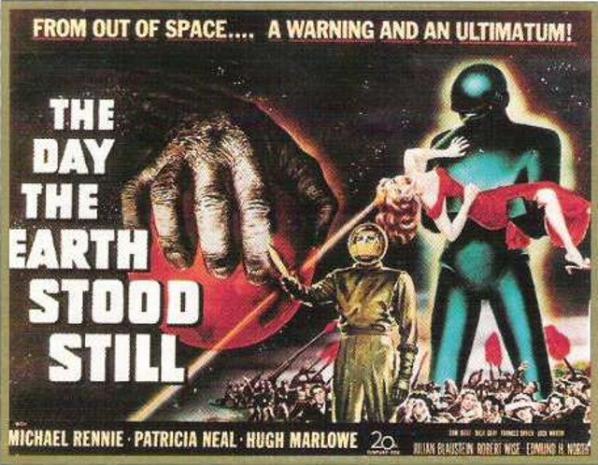
Territorialization refers to the exertion of power along perimeters, or borders. Functionaries expressing the constriction of territory include customs agents, and border patrols; but are terminally expressed by the military wing of the nation state. This military is also generally pyramidally constructed in terms of Generals, Colonels, and other officers leading Battalions, Regiments and Divisions, which are organized as defenders of a nation’s sovereignty. These military organs are conversely best optimized to exert their power against either parallel or subordinate structures. Parallel structures include the armies of other nations, their Officers, et al, and their troops and ordnance that possess a similar organization. Conversely, subordinate structures over which military powers can exert power over are domestic masses that can be overrun with overwhelming power, although these forces are more specialized (such as National Guards or Gendarmeries). In the conventional sense, power is expressed orthogonally, whether it is against equal or subordinate forces.
Another aspect of this conversation relates to the expression of power/force through conflict and violence, but has its inconsistencies The examples I will use from American pop culture I will use in this missive to explain amorphous action may be violent in nature, but the violent nature of these examples do not relate to the paradigmatic jamming of conventional power. Their citation is related more to the fact of conventional power’s orthogony, or parallelism of exertion of power to similar structures or dominance of the subordinate, and the panic state it experiences when confronted with non-conventional difference or passive resistance. We could express the power relationships between amorphous politics and conventional power in terms of a tetrad in terms of examples of violent and peaceful exertion of amorphous dissent as well as orthogonal conflict. We could cite the Occupy movement as a site of passive, and the Tunisian uprising as violent exemplars of amorphous conflict or dissent. Conversely, the Gandhi/King is a non-violent model of as orthogonal/hierarchical/led action, and World War Two as conventional orthogonal conflict. What is important here is the inability of the conventional politics and power to cope with leaderless, non-hierarchical, non-orthogonal discourse that refuses to talk in like terms such as centralization, leadership and conventional negotiations that include concepts such as “demands”. This is where the site of cognitive dissonance erupts, often resulting in a panic state or in the “figureheading” of dispersed networks of power.
The need for the traditional power structure to focus identity on the antagonist in terms of figureheads is evident in the Middle East and Eurasia in the personification of terrorist and insurgent networks, but is more simply illustrated in the films Alien and Aliens, and Star Trek: The Next Generation. Both of these feature their respective antagonists, the “alien” as archetypal Other, and the Borg, symbol of autonomous, collective community. In Alien, the crew of the Nostromo encounters an alien derelict ship that has been mysteriously disabled to find a hive of eggs of alien creatures whose sole role is the creation of egg factories for further reproduction. At the onset of the franchise, pilot Ellen Ripley is positioned as the “everywoman” placed in the center of cataclysmic events. In the Alan Dean Foster book adaptation, and an extended edit of the Scott film, Ripley finds during her escape from the ship that Captain Dallas has been captured and organically transformed into a half-human egg-layer whom she immolates with a flamethrower. However, in the Aliens sequel, the amorphous society of the self-replicating aliens has been replaced by a centralized hive, dominated by a gigantic Queen that threatens to impregnate the daughter-surrogate Newt. This transformation from a faceless to centralized threat creates a figurehead for the threat and establishes a clear protagonist/antagonist relationship, and establishes traditional orthogony.
This simplification of dialectic of asymmetrical politics is also evidenced in Star Trek: The Next Generation by the coming of the Borg, a collective race of cybernetic individuals. Although representations of the Borg vary as to fictional timeline, in televised media they began as a faceless hive-mind, which abducted Captain Jean-Luc Picard as a mouthpiece, not as a leader. It was inferred that if one sliced off or destroyed a percentage of a Borg ship, you did not disable it; you merely had the percentage left coming at you just as fast. However, by the movie First Contact, the Borg now possesses a hierarchical command structure to their network and, more importantly, a queen. With the assimilated and reclaimed android Lieutenant Data, the crew of the Enterprise infiltrates higher level functions of the Borg Collective, effectively shutting down the subordinate elements of the Hive. In addition, the Queen/Leader is defeated, assuring traditional figurehead/hierarchy power relations rather than having to deal with the problems of the amorphous, autonomous mass. There are other “amorphous” metaphors in cinema that address the issue of amorphousness. These include the 1958 movie, The Blob, in which a giant amoeba attacks a small town and grows as it engulfs everything. Another is The Thing, about a parasitic alien that doppelgangs its victims, creating another form of faceless threat. Lastly, we have the classic Invasion of the Body Snatchers where alien plant “pods” would bear fruit of duplicates of living people, giving a metaphor for the Communist threat of the Red Scare originating during the Cold War. Perhaps these are historical references to mediated expressions of anxiety in regard to autonomy’s threats to regimented/striated hegemony, stating that this sort of anxiety and terror are not new.

One of the most asymmetric cultural Western interventions in relation to constructs of traditional power is the involvement of Anonymous as part of the Occupy Movement. Anonymous, which has been called a “hacker group” in the mass media, is a taxonomy created on the online image sharing community 4chan.org, arising from the practice of posting “anonymously” unless one wants to use a name, or handle. Although the idea of Anonymous is at best an ad hoc grouping, the use of the “group” name has been ascribed to various factions. According to The State News, “Anonymous has no leader or controlling party and relies on the collective power of its individual participants acting in such a way that the net effect benefits the group.“ The idea of Anonymous fits with the “faceless collectives” mentioned above, and certainly presents an asymmetric, if not non-orthogonal, exercise of power. Anonymous first rose as a voice of dissent that emerged against the Church of Scientology (see Project Chanology), where flash mobs of individuals in Guy Fawkes masks and suits arrived to protest at sites around the world, with boom boxes playing “The Fresh Prince of BelAir”, a popular agitational or “trolling” anthem. It has engaged in other activities, including hacking credit card infrastructures opposed to handling donations to Wikileaks and creating media around Occupy Wall Street. However, without a clear infrastructure and only transient figureheads, Anonymous functions as an organizing frame for a cloud of individuals interested in various collective actions, and represents an indefinite politics based on networked culture. In an expected exercise of force, during the actions against elements opposed to Wikileaks, conventional power struck back wherever it could against members of Anonymous, by arresting over 21, some violently, in July during the actions against credit providers boycotting Wikileaks. This exercise of power was repeated in September, with admonitions about the arrests appearing on YouTube thereafter. Anonymous has also posted videos in support of the Occupy movement. Such a response is not surprising, but is the exact response to non-orthogonal dissent under our model. The problem is that in arresting any number of Anonymous members, traditional power is confronted with the first, distributed model of the Borg that merely exists minus two or twenty members.
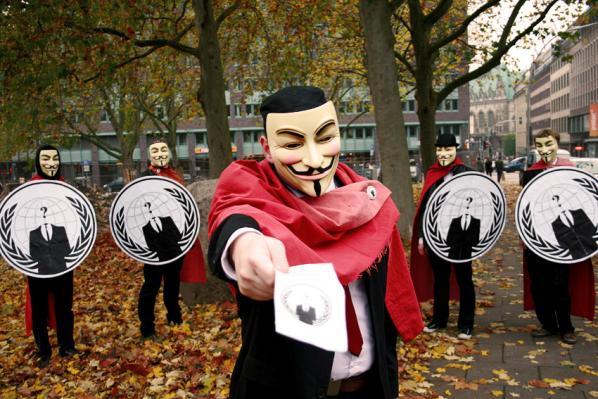
Another dissonance between the Occupy Movement and conventional politics is the perceived lack of agenda. This is due to its dispersion of discourse in giving its constituents collective importance in voice. What is the agenda of the disempowered 99% of Americans, or world citizens marginalized by global concentration of wealth? Simply put, the agenda is for the disempowered to be heard. What does that mean? It means anything from forgiveness of student loans to jobs to redistribution of wealth to affordable health care, and so on. It isn’t a list; it is a call to systemic change of the means of production, distribution of wealth and empowerment in political discourse. It isn’t as simple as “We want a 5% cut in taxes for those making under $30,000.” It’s more akin to “We’re tired that there are so many sick, hungry, poor and uneducated, and we want it to end. Let’s figure it out.” It is the invitation to the beginning of a conversation that has no simple answers other than the very alteration of a paradigm of disparity that has arisen over the past 40 years through American capitalism.
The last challenge to the traditional power discourse is that of passive resistance. This is not a new strategy, especially under the aegis of Gandhi and King’s movements. However, it is traditional power’s mere tolerance of nonviolent resistance that does not result in violence. As we can see from the UC Davis assaults and the dispersions after the second month anniversary, conventional power exerts its force against, as Brian Holmes put it, “anomalies” so that the system can be restored and the commodifiable classes are reintegrated into the system to reproduce its agendas. As long as resistance does not present undue inconvenience for the circulation of power and capital, it is allowed. Once it loses its patience with non-orthogonal forces, or if materially sacralized spaces, like Wall Street are threatened, the hegemonic order is reified. The irony of the technical loophole of Zucotti Park being privately owned and having few rules allowed the Occupy movement also highlights the tenuousness of public discourse in Millennial America. However, even with this oddity, on the two-month anniversary of Occupy Wall Street, force has begun to be used against the occupiers as traditional power’s patience grows thin with amorphous politics. In the streets, the marches are split up, and rules about occupation begin to be enforced with cupidity. As said before, hegemonic patience has worn thin, with assaults/dispersions taking place in Oakland, Davis, Philadelphia, and New York, among others. However, the movement moves forward for the moment.
Amorphous politics is based on plurality, collectivism, dispersion and ideas. The hierarchical nation-state has no idea what to do with the amorphous blob as it grows except to try to contain it, but as with Anonymous, it is a whack-a-mole game. If one smacks down one protest, two pop up across town, or five websites pop up on the Net. Shut down Wikileaks, and a thousand mirror sites show up. People in the streets swarm New York and other cities throughout the US, and the world, and conflict arises. Asymmetry and amorphousness are dissonances to traditional power. Ideas in themselves are not hierarchical.
Desires sometimes have no agendas.
Sometimes people want what is right, and all of it.
Dragana Zarevska and Jasna Dimitrovska are visual and performing artists, cultural workers and activists from Macedonia, who also, often work together under the artistic pseudonym Ephemerki. While at the same time loving and teasing the rigidity of academism, they like decoding magic, making it transparent, go behind Wizard of Oz’s curtain and put his pants down. The name of the duo is a funny derivate of Bapchorki (band of few grannies who used to sing Macedonian traditional songs in a rustic nasal style). It suggests that Ephemerki are their ephemeral version, or at least, the ones doing the ephemeral part of tradition. Their work is driven from and inspired by Donna Haraway, Judith Butler, Deleuze and Guattari, Agamben, and other contemporary thinkers and practitioners within arts, technology, society.
The Lele method is their latest performance (a performative event for a bunch of people, as they like to call it) and so far was performed at AKTO 6, Festival for Contemporary art in Bitola and Kondenz & Locomotion, Performing arts festivals organized in Skopje and Belgrade. Here is the story behind the project.

Darko Aleksovski: ‘Lele’ (Мac: леле) is a word that has profound significance in the Macedonian language. It is a universal word that can be used in different contexts and can imply several different emotional states. Can you describe what was the inspiration for this project dedicated to the word ‘lele’? What is the subjective meaning of this word for you?
Dragana Zarevska/ Jasna Dimitrovska: The particular situations this word implies and the problems it addresses might sound quite confusing for the non-Macedonian readers, but, if any of them have visited, or will visit our country, it’ll be deadly surprising how many “leles” per minute one hears around. The word “lele” is totally devoid of meaning, but it is being used to emphasize certain emotions, wondering, shock, great happiness and similar. It is just a shout out, like…the French “oh-la-la” for instance, the Bulgarian “ma-leeeh” or like the Serbian “yoooooy”. The project is being titled “The Lele Method”, directly and totally driven from the local obsession with lele and its possible application.
For us, this word sometimes depicts the shortly shaken numbness and the apathy of our current socio-political constellations, but only with a shout, and then again – everything goes on as usual.
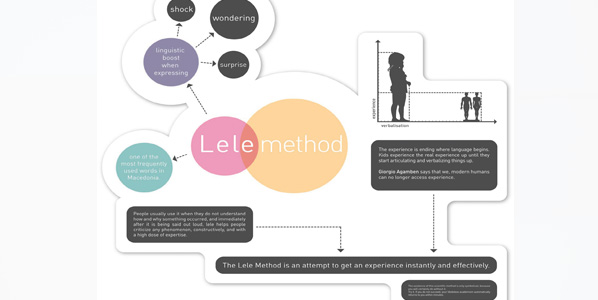
Darko Aleksovski: What is the ‘lele method’? Considering the performative act of the ‘lele’ word, and its everyday use in Macedonian speech, do you think that a method like this can still function as relevant? Can the ‘lele method’ be appropriated by anyone, or it is just a method that you as an artist use?
Dragana Zarevska/ Jasna Dimitrovska: Sure. It can be appropriated by anyone, but it is still a joke. You will certainly do without it as a method. Using it will not bring anything to your life what you’ve not had before. This is how we define it: Lele is one of the most frequently used words in Macedonia… people usually use it when they do not understand how and why something occurred, and immediately after it is being said out loud, Lele helps people criticize any phenomenon, constructively, and with a high dose of expertise. Try it. If you do not succeed, your libidoless academism automatically returns to you within minutes.
These instructions can help a lot in experiencing this useless experience through this useless method. But, stating the obvious with The Lele Method is what we enjoy the most. We give people what they already have, like selling snow to Eskimos.
Recently, in an interview we gave for the Canadian .dpi Magazine we discussed some particular effects we achieved by performing Lele. Nobody is aware of performing it daily here in Macedonia, and while we were preparing the performance out of it/about it, we realized the power of defamiliarization. You perform something which is being performed daily in a constant automatization. By naming a method Lele and putting it on a stamp, we gave the word a particular relevance and a different form. We made it “unfamiliar” and “difficult”, and by that, we prolonged the process of perception of that word. By trying to remove the automatism of perception, we got a new perspective of a word, of a problem. This technique has been used in the literary criticism of Russian formalism to differentiate prose from poetry, but we use it to differentiate and to delay perception. As Russian formalist critic Viktor Borisovich Shklovski has said in his well-known essay “Art as Device,” – the purpose of art is to impart the sensation of things as they are perceived and not as they are known.
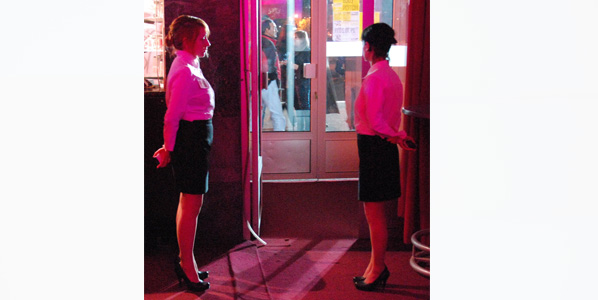
Darko Aleksovski: You have presented this project two times so far – as a performance accompanied by the printed version of the scheme of the ‘lele method’. How much performance is a necessary medium for this project?
Dragana Zarevska/ Jasna Dimitrovska: We’ve shown the performance at this year’s Akto Festival for Contemporary Art during August (Bitola/Macedonia), and at the Kondenz & Locomotion curatorially joint festivals for performing arts organized in Skopje and Belgrade during October. We must admit we entertain ourselves a lot during the performance because people enter the room and they perceive it as some irrelevant and boring employees who put a stamp on everyone’s hand at the venue’s door. Then, they look at the stamped hand/arm and shout “Leeeeeh-leeeeeh!” because that’s being engraved on our stamps.
During the performance we are dressed in our Lele uniforms which are extremely office-like and conservative, our faces are shit-serious, and inside the room there are printed materials (scattered leaflets on the tables, or printed panels on the wall) with diagrams on them explaining the empirical part of the Lele Method. The concept behind the Lele Method is being driven by our love and respect towards Giorgio Agamben’s work and his ideas on experience shown in his work Infancy and History. The experience is ending where language begins. Kids have the real experience until they start articulating and verbalizing things up. Giorgio Agamben says that we, modern humans can no longer access experience. The Lele Method is an attempt to get an experience instantly and effectively. The existence of this scientific method is only symbolic, because it is just mocking the academia and the naive ones simultaneously, as – all of the work we did/do by far.
Much of this performance auto-perpetuated, it is happening by itself. Performance is always a necessity. It is better for us to be aware of it, because we all perform all the time. This performance is all about being aware that we perform something of which we usually forget, but is actually performable – something automatized like the word Lele.
Darko Aleksovski: The project was very well received by the audience, other artists and critics. Does it have another aspect of it, that is directed as a critique towards the whole Macedonian art system?
Dragana Zarevska/ Jasna Dimitrovska: Thank you for this notion. Actually it was fantastic how great it was received. Our work can often be seen as an overlap between theory, movement, process and production. The contextualization of these things shapes the performative events we present that test and deconstruct different versions of reality and its geography, directly related to awareness of the possibilities of language. We criticize language/es through language.
Darko Aleksovski: Do you see ‘lele’ differently, now that you have made a project out of it?
Dragana Zarevska/ Jasna Dimitrovska: Yes we do. We got de-familiarized with it (by getting hiper-familiarized), while, at the same time we started to think of it as of our own word, which is pretty selfish. We totally “adopted” it. Other people who came to our performances also tell us they experience it a bit differently than before, one friend said “Whenever I say Lele I think of you!”. We know this might sound weird and vain, but it seems we assimilated it as our own piece of art, and the truth is – it is so not ours, it is everyone’s. We surely assimilated the illusion of having it as ours though.
more about the artists: zarevska [at] gmail.com, yasna.dimitrovska [at] gmail.com
Darko Aleksovski interviews artist Toni Dimitrov about his work ‘Total surveillance’ featured in the group exhibition SEAFair ’11 ‘Energy, Biopolitics, Resistance strategies and Cultural subversion’. Curated by Melentie Pandilovski, Elena Veljanovska, Zoran Petrovski, ending on the 20th November at the Skopje Museum of Contemporary Art, SEECAN (South East European Contemporary Art Network) and Kontejner, Zagreb. SEAFair 2011 contextualises the artistic and theoretical discourses developing around Bio-politics, aiming at re-evaluating its meaning today, as well as address the possibilities for resisting the dominant international discourses through emancipation and cultural subversion.
Darko Aleksovski: Inspiration is a term which has been differently interpreted throughout the history of art, but generally implies the genealogy of the idea. What was the main inspiration for a project like this? Can you tell us about your references (other similar projects, theory, philosophy, etc)?
Toni Dimitrov: Throughout the twentieth century, art changed its forms of representation. Representation through painting, making objects and visual contemplation, and prior to all – the mimesis – artists changed them with new ways of representation which more and more directly respond and represent the changes in the society, emphasising process, concept, action, interaction, new media, technology, surroundings and of course, the critical discourse… The thing that challenged, and still challenges me to express is the critical discourse and the resignation which is a result of the systematised life and the limitations of the system. It is that primordial anger which one feels at the moment of gaining awareness, when we actually realise where and how we live. Everything that is presented to us as a system that aims to ease our life, is not actually quite so. Take for instance, science and technology, and their goal to “work” for the benefit of humanity. It is not just that they do not seem to make life easier, but on the contrary their usage is harmful for humanity. Exactly from the moment when the greatest hopes were given to technology, science and the great theories, they seem to have failed to fulfill the expectations. Instead of being tools for achieving the ideals of humanity and attaining prosperity, they are becoming the most powerful tools of the system for establishing new forms of power and domination. That same indignation generated from this cognition is my greatest inspiration, from my first critical artwork, through to some other art project, different philosophical essays, and until now.
As inspiration from philosophy, primarily I can mention Baudrillard and Virilio, who precisely vivisect contemporary reality. Then my greatest interest for the utopians and anti-utopians from More and Campanella, who criticise the system at the moment by offering a solution, and all the way to Orwell, Zamyatin and, of course, Huxley, who gives the most precise image of the society we live in – benevolent totalitarianism. I also need to mention the Frankfurt School through From, Horkheimer, Adorno and of course Markuse and other contemporary scholars like Zygmunt Bauman, Ulrich Beck, Frank Furedi, Lars Svendsen…

Darko Aleksovski: To which extent digital media is important for you as an artist? Do you regard the digital artworks to be carriers of more information in a present day digital surplus, or you think that art necessary expresses through digital media because it is the prevalent media in today’s life? How much is the ready-made aspect of this project necessary?
Toni Dimitrov: Digital art affirms all these social changes and at the same time offers a departure from them, leaving different questions from different areas in the center of the discussion. Unambiguously, digital art develops wider contexts and penetrates in other different fields like philosophy, physics, linguistics, semiotics, politics, sociology, even biology. When you visit an exhibition like this, you no more have the feeling that you are at an exhibition where you should experience something beautiful, but you feel like being in a lab where something new is created, something unacceptable even for science itself. Ethic rules and scientific methods have no significance here. Some of those works went too far and by looking at them, you are likely to feel disgust or resignation, feelings that are important for expressing the critical dimension and gaining awareness.
Concerning the ready-made aspect of the digital art, we have to agree with Walter Benjamin, who considers that through making reproductions, the unique experience is replaced by many others and the replication contributes to the loss of the aura of the artwork, with the fact that the artwork through the process of distribution, is not so original, unrepeatable, unique, but can be reproduced and replicated. Simply, the uniqueness of the original is transformed in infiniteness or many others. That is one of the main critical perspectives addressed towards the art that originates after the mechanical reproduction and the development of arts such as film, photography, printmaking, and today we can include a wide variety of digital arts, where practically the original is not present. Here art loses its uniqueness, or aura to be more precise, but receives the “readiness” of the ready-made aspect.
Besides this critique with which I agree, I still think that art/music are created today to be seen/heard today, and not after ten years when they will be a part of the history. This means that art today is created with digital tools and digital media, equally as electronic music is created. In my opinion one should be current and to express through momentary assets, in order to express and present the new social and critical streams more precisely. On the other hand, this does not mean that we should not use classical media in a contemporary way and that I do not draw, or even make a mosaic, but still “officially” I use digital media and conceptual art to express myself and to address a critique.

Darko Aleksovski: Do you consider your project as a critique towards the social apparatus and the instrumentalised life, or towards the inert subject, instructed to accept ready-made social situations?
Toni Dimitrov: Of course the critique is directly addressed to the society and the system. Society is the one who possesses the monopole of power and imposes these aspects of subtle, total control. However, the subject itself is not spared from the critique, precisely because of his inertness, because he does not react against this imposition, but unconditionally accepts it under the vague excuses that all of it is for “his own good”, for his security, protection, etc. Still this imposition is generated by the system, through the upbringing, educating and modeling of the subject itself, so it is more than obvious who is to blame for this condition.
“Total surveillance” addresses the critique towards one of the most explicit “benefits” of contemporary society, which is so much present in our everyday life, that we do not even notice it. The project refers to the anti-utopian dimensions society gets in today’s context. The exposure to constant surveillance is the subject of the anti-utopian works, which precisely anticipate the consequences of irregular use of technology, and the philosophical dimension of which totally corresponds with our present.
It is in these points that we see the postmodern analysis of institutions and discourses of modern art and the ways in which they normalise and discipline the subjects, analyses of the new communication technology, mass-media and their mechanisms of establishing power and domination… We see a critique directly addressed towards today’s modern forms of power which establish new forms of domination. The critique towards information and communication technologies that contribute to the development of human capacities, decomposition of the centralised structure and concentration of power, democratisation of culture… as much as they contribute to the depersonalisation of individuals and manipulation of people.
The realisation of this progress is a vision of the anti-utopia made real, realisation for which time is becoming increasingly shorter. Today we see that, the anti-utopian predictions for the negative consequences of technological and social development are realised with surgeon’s precision, in all of its wide variety, realised through social restrictions, concentration of power, social insecurity, depersonalisation of the individual, destroying of the emotions, control via mass media, mass production, instant entertainment… All these are described and anticipated by the smallest detail, in the works of the anti-utopians years before they became reality.

Darko Aleksovski: Do you see art as the most relevant way for critical actions?
Toni Dimitrov: No. Art is just one, maybe the most banal, but still most receptive way of critical action which will not leave many traces in reality. Art is a paradigm which represents things in a symbolic way. That does not mean that art is insignificant and that there are not examples of art and its critique generating a change or at least raising awareness of some issues, but still it is an accompanying method for addressing direct critique. Theory/ philosophy MUST be inevitable part of the art through which it gets the crucial point for a direct critique and eventually initiating changes. Art without theoretical basis is nearly empty art.

Darko Aleksovski: Your project is a vicious circle copy of the surveillance cameras. To which extent this artistic situation is a replica of the real one, or you consider the real situation to be even worse? How much you think engaged and critical art are perceived nowadays, considering the dispersed art system?
Toni Dimitrov: Unfortunately too true a copy of reality. When you enter the exhibition room, you practically enter a real situation, i.e. you exit in the social reality. This is practically a copy of the social system which we live in. In that case there is no need for gradation of better or worse situation. Go out on the street, pass by the surveillance cameras and feel it. There were mixed reactions when visitors entered the exhibition room, most of them were real, expressed with unpleasant feeling and disgust when they realise they are uncoated and observed from every side. It is the very same thing that happens in every institution and outside on the streets, but we are unaware of who is observing us. That is the feeling I conveyed here; the feeling when you see the results of the observation. It is a precise reflection of the anti-utopian character of our society which develops in this direction mediated by technology.
On the other hand the technological revolution that happened in the last fifty years and the IT revolution created in the digital age, also created fundamental changes in society and the way it functions, even in the physical space. For Virilio, even reality is divided or more accurately it is substituted with another – a virtual one that becomes more powerful mediated by the new technologies. That is why the essay that goes along with the installation begins with a quote by Virilio: One day the virtual world might overwhelm over the real world. This is that same virtual reality in which monitors you look at your existence. It is Virilio that warned us that almost every critique toward the technology disappeared and that we unconsciously accept every innovation without critical view on its consequences, by which we slip in the dogmatism of totalitarian techno-culture. All of this is criticising the way technology changes the contemporary world and human himself, recognising a key factor in technology that determines the modern world.
Finally “Total surveillance” represents a kind of video installation or a network/structure composed of video cameras, video projectors and screens which mutually intersect and constantly record the object/viewer in front of them, from every angle. The viewer, with his/her presence is a participator and part of it at the same time. The cameras record his presence from all four sides, and the viewer is capable of watching the recordings on the screen in front of him i.e. to watch himself. It is about the total surveillance of the viewer, but one in which the viewer is under surveillance by himself from every side and perspectives which are usually invisible for him. In the surveillance, other viewers in the room are also included, by watching themselves, or by watching other viewers. With this, you get a network of crossed cameras and projectors which project images of the viewer from every side, fill the whole room and complement it with the visual noise of the space. This replication and reproduction creates a projection of the viewer in the screens, outside himself, in a sort of virtual world, which continues to infinity, similar to a mirror projected in another mirror, gaining new and new aesthetical forms, a product of the replication and reproduction of themselves.
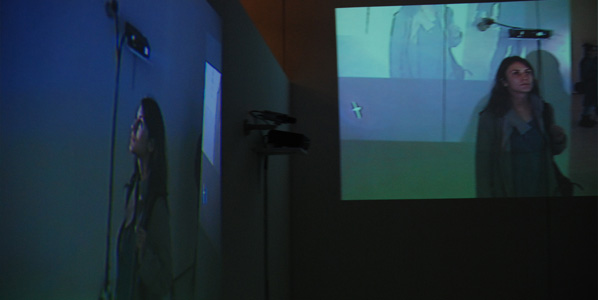
More information about the project and the artist: tonidimitrov [at] gmail.com
All images by Ilija Madzarovski.
The Transborder Immigrant Tool (TBT) is a project created by the University of California at San Diego’s Electronic Disturbance Theater (EDT) 2.0/b.a.n.g. lab, and still evolving today. Here Ricardo Dominguez, co-founder of EDT (with Brett Stalbaum), Principal Investigator of b.a.n.g. lab, and Associate Professor in the Visual Arts Department at UCSD, discusses the project with Lawrence Bird. The interview includes input from other members of the collective: Brett Stalbaum, Micha Cardenas, Amy Sara Carroll and Elle Mehrmand.
Lawrence Bird: Simply put, the Transborder Immigrant Tool is a hand-held device to aid crossers of the Mexico-US border. As far as the cultural and political implications of this device, it’s loaded. But as a starting point, could you tell us a little bit about the technical side of the device?
Ricardo Dominguez: We began with the basic question: what ubiquitous technology would allow us to create an inexpensive tool to support the finding of water caches left in the Southern California desert by NGO’s? Our answer was that the sub-$20 iMotorola phone series could be made useful for emergency navigation. The early generation of the platform we targeted can be made reasonably useful in a better-than-nothing scenario. Meanwhile, later phone generations (that don’t yet cross our price barrier but are getting closer everyday) are already fully useful as practical aids without even a SIM card installed or an available network service. With proper use, the GPS performance of newer phones equals any GPS designed for desert navigation, and their used prices are falling. Moreover, GPS itself does not require service and has free global coverage, courtesy of the United States government. In an emergency scenario, we trust these later mobiles to direct a lost person to a nearby safety site. The TBT’s code is also available on-line to download at walkingtools.net, sans water cache locations, for any individual or community to use for their GPS investigations.

Lawrence Bird: It’s an interesting instance of technology intersecting with geography. You have referred to Donna Haraway’s work in your own comments on the intersection between “border crossing” and other forms of “trans”-being. Would it be accurate to see the TBT as a cyborg component; and if so, what does this mean for the relationship between technology, politics and poetics?
Ricardo Dominguez: Part of the TBT project is to call into question the northern cone’s imaginary about who has priority and control of who can become a cyborg or “trans” human – and immigrants are always presented as less-than-human and certainly not part of a community which is establishing and inventing new forms of life. When in fact these flowing in-between immigrant communities are a deep part of the current condition that Haraway’s research has been pointing towards – for us it is a queer turn in its emergence, both as unexpected and as desire. The investigation of queer technology and what this queering effect has been or might be is an important part of our conversations – especially via Micha Cardenas’ research. This gesture dislocates the techno-political effect with aesthetic affects that become something other than code: a performative matrix that fractalizes and reverses the disorder of things with excessive transbodies acting from the inside-out of those enforced borderless borders. These affects assemble new empirico-tran(s)cendental forms of multi-presence(s) incommensurable with the capitalist socius of the so called “immaterial” Empire. As the Zapatistas say, “we do not move at the speed of technology, but at the speed of dreams” – the heart of the trans-border-borg.
Lawrence Bird: As you say, that –borg is spatial. Do you do any work with professionals of space design – for example, you have mentioned elsewhere the architect Teddy Cruz, who’s done design projects and spatial analyses focused on the Mexico-US border, especially urban borders?
Ricardo Dominguez: We have not worked directly with any urban space designers, such as Teddy Cruz, who teaches here at the Visual Arts Department at UCSD as well – but we have learned a great deal about the nature of the border-as-design and auto-assemblage – especially from the Political Equator gatherings that he has been at the forefront in creating. But recently we were invited to create a gesture for Political Equator 3 that we really enjoyed and offered a poetic materialization of bringing TBT into Mexico: at 12:30 p.m on June 4th, 2011 the Transborder Immigrant Tool was walked into Tijuana, Mexico via an aquaduct from the U.S. side of the border by artist Marlène Ramírez-Cancio (a video of this event is embedded above).
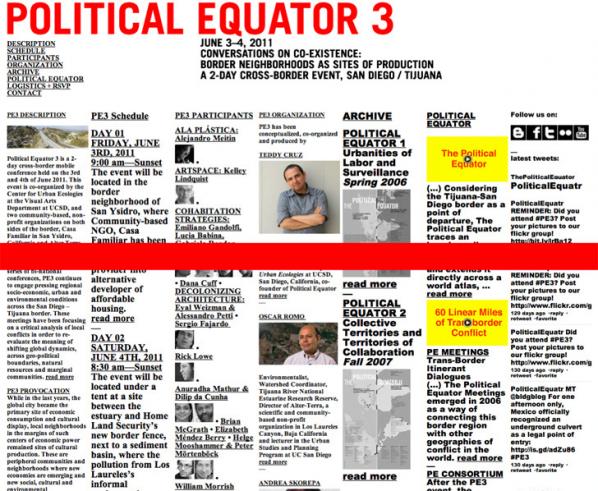
Lawrence Bird: Does any of this work intersect with American fear over border permeability to terrorism? The criticisms of TBT seem to focus on economic migration but the reaction bleeds into fears over security.
Ricardo Dominguez: TBT does crisscross a number of these types of affective conditions that have been floating around the border since 9/11; or one might push it back to early formations of the Mexico/U.S. border. And yes, it intersects with the growing state of fear in the U.S. (and around the world) about immigrants dismantling the U.S. economy – which has always struck me as extremely ironic – since as we have encountered in these past couple of decades, neo-liberal economics on a global scale have done much more to dissolve the romance of the nation via a series of self-made economic bombs than any immigrant “invasion.”
Lawrence Bird: In fact your development of this tool has come at a significant personal cost. You’ve been accused of supporting illegal activity and misuse of public funds. You’ve been called a traitor. Your position at UCSD was threatened. Could you talk about that and where this situation stands today?
Ricardo Dominguez: The entire group of artists who are part of Electronic Disturbance Theater 2.0/b.a.n.g. lab working on the Transborder Immigrant Tool (TBT) was being investigated by UCSD and 3 Republican Congressmen starting on January 11, 2010. Then I came under investigation for the virtual sit-in performance (which joined communities statewide against the rising students fees in the UC system and the dismantling of educational support for K–12 across California) against the UC Office of the President (UCOP) on March 4, 2010. This was then followed by an investigation by the FBI Office of Cybercrimes. So, it was three investigations in total— and they were all seeking to find a way to stop TBT and threaten to de-tenure me for doing the very work I was hired to do and then tenured for. In the end all the investigations were dropped. I did agree not to do another virtual sit-in performance on the UCOP for four years, but the day I signed the agreement, a number of supporters across the nation did a virtual sit-in on UCOP again. One strange element about the agreement that they wanted me to sign without even giving me or my legal team time to look it over was that I would never speak or write about what had happened, create any artwork that might disturb anyone and refrain from an artivist performances. Of course I agreed to none of it.
Lawrence Bird: The vitriol in the attacks on you is remarkable, and disturbing: you received a great deal of hate mail and a number of death threats because of this project. You mention in your play Sustenance (published in Artists & Activists 12) that these messages “constellate into remarkable patterns”, form a chart as it were of the agitated contemporary discourse over immigration, security, and national purity vs. liberty. It’s significant that you’ve built a play around this. Do you see the political and popular response to your project (you refer to it as “viral reportage”) as part of the TBT’s performative aspect?
Ricardo Dominguez: Part of the history of the Electronic Disturbance Theater 1.0/2.0 and b.a.n.g. lab (stands for bits, atoms, neurons and genes) at CALIT2/UCSD has been to develop works that can create a performative matrix that activate and take a measure of the current conditions and intensities of power/s, communities and their anxieties or resistances. So, for us the U.S. Department of Defense launching “info-weapons” at us for a virtual sit-in on September 9th, 1998 or the current confluence of “viral reportage” and the affective contagion of hate about the project that followed are all part of the performance – of course we would much rather the hate-mail never occurred – dominant media is bad enough to deal with. The aesthetics of working in the zones of post-contemporary artivist gestures cannot really escape these types of encounters; it is part and parcel of the patina of our work. But, we also feel that the hate mail or the general fear of losing national purity is co-equal in importance with the poetry that they were attacking. In fact Glenn Beck, an extreme right wing pundit on the Fox News Channel, attacked not only TBT’s use of poetry, but that the poetry itself had the power to “dissolve” the nation. The performative matrix of TBT allows viral reportage, hate-mail, GPS, poetry, the Mexico/U.S. border, immigrants, to encounter one another in a state of frisson – a frisson that seeks to ask what is sustenance under the sign of globalization-is-borderization.

Lawrence Bird: Can you tell us a little more about the poetry that accompanies the guidance system? How was this chosen, what does it concern? How do you envision the poetry developing as the project continues?
Ricardo Dominguez: Electronic Disturbance Theater 1.0/2.0 has always been invested in experimental poetry as part of its gestures – from the found poetry of the “404 file not found” of our ECD performances in 90’s to the border hack actions with the Zapatista Tribal Port Scan in 2000 on U.S. Border Patrol servers, where we would scan and upload Zapatista poems that we had written into their servers. When we started to develop TBT it became important once again to have a core impulse of the gesture. In 2008 I asked my partner, Amy Sara Carroll, who is an experimental poet and scholar, at University of Michigan, Ann Arbor – one of the areas of her research is on art and Mexican/U.S. border. She thought that TBT becoming a geo-poetic-system (gps) could expand the frame of experimental poetry and artivism. She then began to work with us and established two geo-poetic tracks – one conceptual and the other an echoing of desert survival manuals in multiple languages, which speaks to the multiple borders that are crisscrossing the planet and the multiple languages that are crossing Mexican/U.S. border via immigrants. Here is Amy speaking about TBT:
“…my collaboration with Electronic Disturbance Theatre (EDT) on the Transborder Immigrant Tool…(is) imagined as a global project under development, my own involvement in that ongoing process is linked to the question of what constitutes sustenance in the quotidian of the conceptual, on the varied musical scales of the micro- and macro-. For, often—rightly enough—conversations about crossing the Mexico-U.S. border refer to disorientation, sun exposure, lack of water. The Transborder Immigrant Tool attempts to address those vicissitudes, but also to remember that the aesthetic—freighted with the unbearable weight of ‘love’—too, sustains. A poetic gesture from its inception, the Transborder Immigrant Tool functions, via the aspirations of such a dislocative medium, as dislocative media, seeking to realize the possibilities of G.P.S. as both a ‘global positioning system’ and, what, in another context, Laura Borràs Castanyer and Juan B. Gutiérrez have termed, a ‘global poetic system.’ The Transborder Immigrant Tool includes poems for psychic consultation, spoken words of encouragement and welcome, which I am writing and co-designing in the mindset of Audre Lorde’s pronouncement that ‘poetry is not a luxury.’ … speaks to the Transborder Immigrant Tool’s overarching commitment to global citizenship. For, the excerpt, itself infused with the ‘transversal logic’ of the poetic, acts as one of the Transborder Immigrant Tool’s internal compasses, clarifying the ways and means by which I and my collaborators approach this project as ethically inflected, as transcending the local of (bi-)national politics, of borders and their policing.” http://bang.calit2.net/xborderblog/?tag=poetry
Here is a poem that made Glenn Beck extremely angry:
TRANSITION
(song of my cells)
Gloria Anzaldúa writes, “We have a tradition of migration, a tradition of long walks. Today we are witnessing la migración de los pueblos mexicanos, the return odyssey to the historical/mythological Aztlán” (1999 [1987]: 33). The historical? The mythological? Aztlán? It’s difficult to follow the soundings of that song. Today’s borders and circuits speak at “lower frequencies,” are “shot through with chips of Messianic time.” Might (O chondria!): imagine the chips’ transliteralization and you have “arrived” at the engines of a global positioning system—the transitivity of the Transborder Immigrant Tool. Too: when you outgrow that definition, look for the “trans-” of transcendental -isms, imperfect as overwound pocketwatches, “off”-beat as subliminalities (alternate forms of energy which exceed Reason’s predetermined star maps). Pointedly past Walden-pondering, el otro lado de flâneur-floundering—draw a circle, now “irse por la tangente”—neither gray nor grey (nor black-and-white). Arco-iris: flight, a fight. Of fancy. This Bridge Called my Back, my heart, my head, my cock, my cunt, my tunnel. Vision: You. Are. Crossing. Into. Me.
Here is a beautiful video version that Micha Cardenas and Elle Mehrmand did of the poem: http://bang.calit2.net/xborderblog/?p=49
In the strongest possible sense poetic practice has emerged in TBT that is co-equal with Brett Stalbaum’s idea of a “last mile” tool and his development of the code necessary to have it work. In fact we also think of the code-as-poetry as well – an expansion of codeswitching – literally.
Here is one of the desert survival poems:
En última instancia, muchos dirán que
la naturaleza establece el estándar de
la neutralidad. A diferencia de los seres
humanos, la naturaleza no hace lazos
de lealtad con la nación, la familia, los
negocios o la religión. Usted sabe bien
que el mayor peligro que enfrentará en el
desierto puede no ser el clima o el terreno.
Habrá quienes no tengan en consideración
su bienestar. Los rescatistas tienen el
compromiso de ayudar a quien lo necesite;
exíjales cumplir esa promesa. No confíe su
vida a nadie más, a ningún extraño.
All them are available in multiple languages to the user on TBT.

Lawrence Bird: How do you navigate the legal issues? Did you have a strategy in place ahead of time for dealing with these, or have you had to deal with them ad-hoc? Does your strategy/defense link up at any level with that of apprehended border-crossers?
Ricardo Dominguez: We are not attempting to navigate “legal” (national or international) issues – but we are trying to establish a reconfiguration of the border and immigration in terms of what we are calling transborder justice – the question of a “higher law” doctrine that David Henry Thoreau established in On Civil Disobedience. Also, in a more speculative manner as artists we see TBT as still in the process of becoming – it is still shape shifting and performing itself into potential spaces of use and poetics. TBT is border disturbance art that constitutes a visible geo-aesthetic/geo-ethics gesture against the boundaries and borderless borders that are crisscrossing every single body on the planet – we call for a geo-aesthetics that starts at the nanoscale and reaches to the GPS (Global Position System) grid system that floats around the planet, we call for a geo-aesthetics that connects both the human and the inhuman, geography and ethics, we call for a geo-aesthetics that crosses into and dislocates the smooth space of geo-spatial mobility with ethical objects for multiple forms of sustenance. We live in a world where only goods and services have rights to cross borders – a world that is a chaosmosis of markets that demand global exchange and aggressive state social filters. We need a geo-aesthetics that can construct ethical and performative complexities for the new earths to come, that can touch new geographies for new bodies – transbodies with transborder rights – artwork that can function as a geo-philosophy for bodies that are flowing as transborder bodies across all the borders the world – a flowing-trans-nation the planet cannot survive without.
Lawrence Bird: Have you considered applications of the TBT more globally, in Europe for example, or the Canada/US border, which has its own tensions relating to indigenous sovereignty? Or would this take it out of the specific politics you want to focus on?
Ricardo Dominguez: We imagine TBT’s code and gesture as open to use on multiple borders and that it is not bound to just the Mexico/U.S. border. One way that we have attempted to promote this possibility is by making the code available to anyone or any group at walkingtools.net.
Lawrence Bird: How extensively has your system been used on the Mexico/U.S. border? Or is it primarily rhetorical so far (it’s certainly been successful that way). How is it coordinated with others’ humanitarian efforts for border-crossers?
Ricardo Dominguez: On a very practical level our work with NGO’s has been focused on working with groups in Southern California who have established networks of water caches for immigrants crossing that area of the border – specifically Water Stations Inc. and Border Angels. Water Stations Inc., the longest running NGO working on this issue, has been very open to helping us test TBT and has also offered us extremely important insights into what the real conditions on the ground and what problems immigrants are facing. We recommend that if folks have funds to donate to these groups – please do. They were very wary of us at first – but they have now become much more supportive – especially because of the work that Brett Stalbaum and his partner, artist Paula Poole, have done in with them beyond TBT.
On the rhetorical end of the gesture much of the work that we do at b.a.n.g. lab is to start our research as a politics of rehearsal, a rehearsal of politics, as part of our art practice – to create an aesthetic of minor-signals and lower-frequencies…”like physics, aesthetics is a science whose primary object is signals, the physical materiality of signs….”– to quote from a recent tweet by Jussi Parikka. To manifest a type of science of the oppressed or engineering of the oppressed that imagines creating speculations that automatically, conceptually, begin to disturb not only the lines of thinking that criss-cross not only our bodies, but the ecologies of the Americas, and certainly the globe. And, so it becomes necessary to create these speculative disturbances that can allow one to think about another possibility, another impossibility, that these systems both manifest and, at the same time, call for an “anti-anti-utopian” potentiality, so that the engineering of the oppressed, the science of the oppressed, is about rehearsing the fictions that will then become realities. Our work in one sense is simply a gesture of “plagiarism”—a cutting and pasting of what is already an assemblage or a system that exists because immigrants are crossing multiple spaces around the world and GPS is everywhere in our cloudy global Empire. And so TBT itself is an attempt to create the multiple layers that manifest the social frictions, the speculative fictions, the rehearsal of politics, and of a counter-machine aesthetics—a machine of difference that can only really be performed by more than the multitude, if you will, to interrupt what Mary Pat Brady calls the U.S/Mexico border, “a state-sponsored aesthetic project.” We can see how these speculative gestures do create social responses on a global scale.
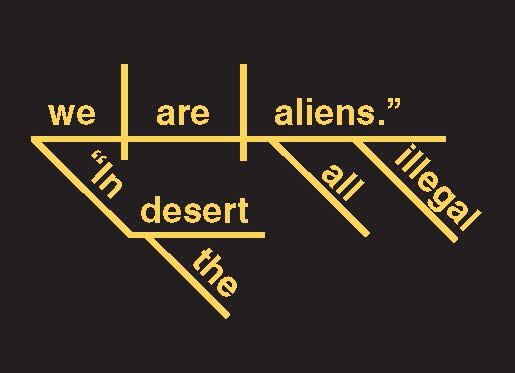
Lawrence Bird: TBT doesn’t just provide a map and way of locating oneself, it offers directions to various support services – where to find water, medical help. How are such safe sites managed and their position made public without making them vulnerable to border patrols? Are there any ethical issues involved here?
Ricardo Dominguez: The water cache sites are already well known by the U.S. Border Patrol, Homeland Security and anyone else who cares to take a trip along the Anza-Borrego desert in Southern California – in fact they have large flags signaling their locations. So TBT at this point is only doing one thing – offering the location of these known and established water caches – as a last-mile safety tool and nothing more. The cell phones we are using are not robust enough for anything else – now as more cheap high-end phones come on the market TBT will be able to offer more on multiple levels. So the ethical questions about TBT on the U.S. side of the border are not as complicated as those on the Mexico side of the border: these are questions about how TBT would interact with the coyote networks, would it be just one more material burden to those crossing, how does the extreme violence of the narco-war shut down the abilities of NGO’s etc., to work on distributing TBT with us – these questions seem much more important in terms of the ethics of the project – would it do more harm than good? Or is it a gesture that would offer a way out for some immigrants from the violence of these dangerous networks that they have to deal with in order to cross? At this point due to all last year’s issues we have not been able to formally present TBT to the immigrant communities preparing to cross to have a dialogue about these questions – but we are hoping to move forward with these encounters – sans any further investigations.
Lawrence Bird: And how has TBT been taken on the Mexican side – what is it’s perception on the part of Mexican citizens, politicians, media? I’m curious how their reaction compares to the response on the American side, which approached violence.
Ricardo Dominguez: It is difficult for us to access Mexico’s response to TBT in relation to coyote economies or the narco-war on the border – these are zones that we have not attempted to have conversations with or have correspondences with. But EDT 2.0 is concerned about how TBT might function within or alongside these violent enclosures that immigrants have to deal with on multiple levels. We do not want TBT to become an attractor for immigrants who are already targets for these groups. But what we can say is that Mexico’s dominant media and alter-media networks, from Tijuana to Chiapas, have been very responsive and supportive of TBT. One of the first awards TBT received was in 2007 from the new media arts festival Transito_MX, who awarded TBT the “trans-communities award,” and the award was handed to us by a representative of the U.S. Embassy in Mexico. So at this time the response to TBT is both unknown and known. Another concern that we have and that we hope to be able to have a better sense of by the end of the year is how the design works for immigrants, and to what degree do they consider it useful as an art work and “last mile” safety tool – this will be done via workshops with potential immigrants in Tijuana, Mexico. Also one of the core questions we will have, based on all the materials that immigrants leave in the desert while crossing – the heat and difficulty of crossing call for dropping as much away from the body as possible, from money, to telephone numbers, to pictures of loved ones, etc. – is one more thing to weigh one down really necessary? These are EDT 2.0’s concerns at this time in relation to the border on the Mexican side.
Lawrence Bird: You mention that what drives border crossers is a hope that amounts to a “hope for the unknown”? Could you elaborate on this? At any level do you see a contradiction between this and the technologies of transparency, like GPS?
Ricardo Dominguez: The radical gesture of transparency was extremely important to EDT 1.0 in relation to Electronic Civil Disobedience as theory and practice and it still is in relation to the general distribution of TBT – who were are, where we are, and why we are doing it. But we are also very interested in the notion of translucency as an aesthetic possibility for TBT that functions to dislocate the readability of GPS (Global Positioning System) and gps (a geo-poetic system) – a minor form of the technology that is no longer bound to the total vision of GPS that is now embedded in almost everything. This translucency functions as a single-bounce GPS that initiates the database of TBT and then shuts off – thus making triangulation impossible – unless the user decided to turn the function on during the crossing. TBT’s gps creates an aesthetic disturbance that dislocates GPS as a transparent device and instead offers a navigational translucency of the “last mile” with hope-as-sustenance as its guiding wave-point.
Lawrence Bird: In Sustenance you refer in passing to Baudrillard’s “desert of the Real”. It’s a compelling way of looking at the border desert where migrants are abandoned in their pursuit of the American fantasy. But adopting a perhaps more humanist attitude, would it be remiss to recall Saint-Exupéry’s words that “Ce qui embellit le desert…c’est qu’il cache un puits quelque part.” / “What makes a desert beautiful is that, somewhere, it hides a well.” Perhaps based on that juxtaposition, how would you place your project in relation to the tension between poetry, activist politics, and humanitarianism?
Ricardo Dominguez: TBT is still in a (gps) process of becoming – it is still shape-shifting and performing itself into potential spaces of use for activists and expanding the frame of dislocative poetics. TBT is border disturbance art that constitutes a waterwitching tool that indeed crosses the desert of the Real, the hard simulations of the border which seek to target and kill. It offers another possibility – with the anti-anti-utopian offer of the desert’s “beauty” that you are keying into the conversation. We imagine that this gesture echoes practices that fractalize the desert’s geo-aesthetics as: artivism, tactical poetries, hacktivism(s), new media theater, border disturbance art/technologies, augmented realities, speculative cartographies, queer technologies, transnational feminisms and code, digital Zapatismo, dislocative gps, intergalactic performances, [add your own______].

Face to facebook is the final project in a three part series named “Tha Hacking Monopolism Triology” by the two Italian artists Paolo Cirio and Alessandro Ludovico. It was launched on the 2nd February 2011, with a mixed media installation at the Transmediale festival in Berlin, and a press release announcing a new dating website called lovely-faces.com.
The set-up for the ‘Face to facebook’ project was to steal 1 million facebook profiles and re-contextualize them on a custom made dating website (lovely-faces.com). The data collected from the profiles was only information available publicly on the internet, like the users name and profile picture. No facebook account was needed to access it. The 1 million facebook profile pictures were then checked for images that were usable in a dating webstie context. The remaining 250,000 profile pictures were then fed through various face recognition filters to assign an assumed personality to the subjects and a new profile was created ready for the dating website. Once published on lovely-faces.com, interested pursuers could get in contact with the people behind the original facebook profiles through facebook messages.

On the 10th February, 8 days after its launch, the dating website lovely-faces.com was shut down. This was following a cease and decease letter from Facebook[1]. Back in 1999, the net artist Heath Bunting was also subject to a cease and decease letter, that time from American Express. The letter sent to Paolo Cirio and Alessandro Ludovico in 2011 (as PDF) can be seen here, and the letter sent to Heath Bunting in 1999 is published here.
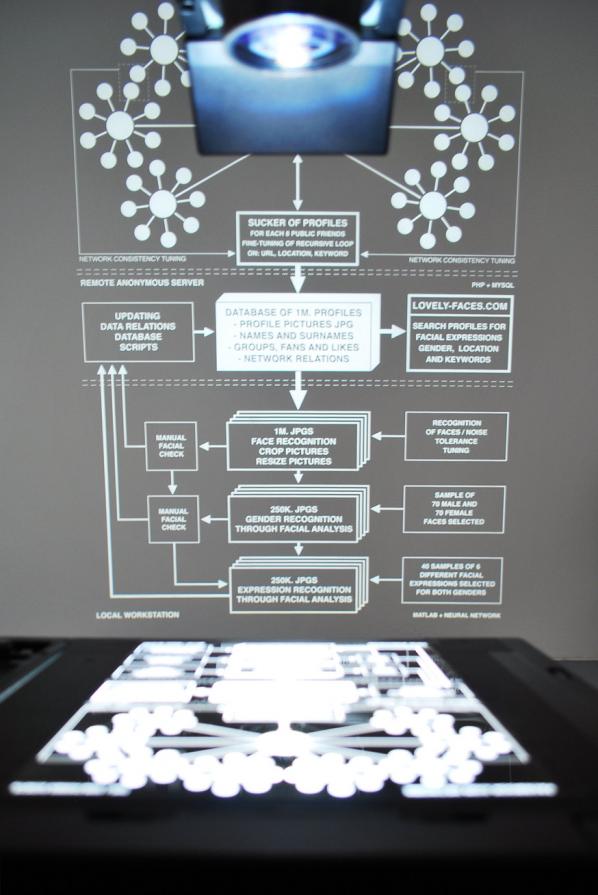
This project, and the ripples it left on the media water, highlights an ambiguous relationship many have with facebook. Many people sign up, upload a smiling profile picture of themselves and declare personal details to the large corporation that is Facebook without concern. Not until these identities and personal images were scavenged and then reused, the ownership and potential audience of this personal data is questioned. As the artists state themselves: “The final step is to be aware that almost everything posted online can have a different life if simply recontextualized. “
“The process is always illustrated in a diagram that shows the main directions and processes under which the software has been developed. We found a significant conceptual hole in all of these corporate systems and we used it to expose the fragility of their omnipotent commercial and marketing strategies. In fact all these corporations established a monopoly in their respective sectors (Google, search engine; Amazon, book selling; Facebook, social media), but despite that their self-protective strategies are not infallible. And we have been successful in demonstrating this.”
Web 2.0 Suicide machine (http://suicidemachine.org/) is another project which deals with your online identity. It allows you to automatically delete all your social network profiles and it simplifies the process – according to their website 8.5h quick then a manual deletion. Incidentially, the facebook is not one of the profiles subject to deletion in the suicide machine anymore, following another cease and decease letter: http://suicidemachine.org/download/Web_2.0_Suicide_Machine.pdf.
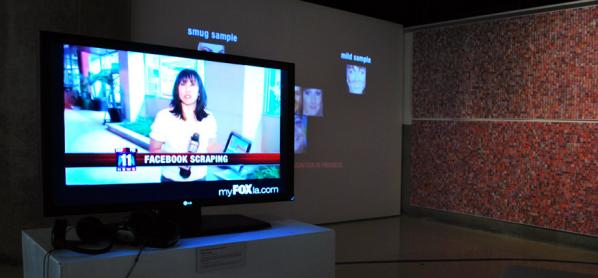
Since the lovely-faces.com dating website is still closed down, the project now (September 2011) consists of: documentation of the process used to acquire the facebook profiles; documentation of the global mass media hack performance, in the form of news broadcasts, magazine articles and blog post referring to the project; legal correspondence between the lawyers of the artists and Facebook; a mixed media installation; a touring lecture given by the authors. The latter two being re-performed and installed in various venues around Europe and beyond. The former are all available on the website face-to-facebook.net
The ever changing nature of this project therefore makes it a great example of a piece of contemporary art of variable nature, one which is in constant flux and is formed by the cultural, networked and physical landscape surrounding it. It does not only challenge the ownership of your online identity, it is also a nuisance for a mainstream contemporary art market based on institutional preservation and commercial commodification. These disruptions may also be linked. On the one hand there is an action to copy a system collecting and commodfying people and then use them as assets in one’s art expression and experience. “In all the three projects, the theft is not used to generate money at all, or for personal economic advantage, but only to twist the stolen data or knowledge against the respective corporations.” And then on the other hand, it is an art project which is not straightforward to see what the remaining artefacts actually are, whilst defying the process of being added to traditional art collections.
Other Info:
The Hacking Monopolism Trilogy. Face to Facebook is the third work in a series that began with Google Will Eat Itself and Amazon Noir. http://www.face-to-facebook.net/hacking-monopolism-trilogy.php
Elin Ahlberg is studying Art and Visual culture at the University of the West of England in Bristol. She has been living in the UK, and Bristol, since her move from Sweden in 2006. As an artist, she works in a variety of mediums and produces work which aims to both amuse and provoke. Her practice and research is informed by quasi-anthropological observations and an interest in technology. “One year ago I gave up Facebook for lent. It was quite an interesting experiment and I realised how integrated my life was with the social networking website as I actually felt that I missed out on things.” Ahlberg’s essay Meanings constructed around Facebook can be found here http://elinahlberg.wordpress.com/2011/07/18/essay-meanings-constructed-around-facebook-2011/
Emilie Giles interviews artist Mary Flanagan about Tiltfactor’s latest social game, Pox: Save the People. http://www.tiltfactor.org/pox
Emilie Giles: Can you give an introduction to POX: Save the People, and why Tiltfactor was keen to produce a game which explored issues around immunisation?
Mary Flanagan: POX: Save the People is a 1-4 player board game that takes on the public health issue of disease spread. We developed the game after wishing to pursue some public health issues and having prototypes games on cholera and HIV awareness at the lab. A local, and quite open, public health group called Mascoma Valley Health Initiative up in the New Hampshire region of the US approached us with the problem of the lack of immunization. At first, a game about getting people immunized seemed like one of the most “un-fun” concepts imaginable. But that sinking feeling of impossibility almost always leads to good ideas later, so I agreed to take the project on. We decided we could make something fun from the topic, and ruled out nothing, from crazed needles to taking the point of view of the disease whose main purpose in life is to spread around.
In our final version of the game, the board is modeled after a community, with the spaces representing people. The game begins with two people being infected with an unnamed disease, and the illness speads. Players try to contain the disease and save lives. There are vulnerable people among the population noted in yellow, and these people — pregnant women, young babies, and those in frail health — cannot be vaccinated.
EG: Schools have the option to download a sample lesson plan which incorporates the game into a science class. Please explain how you feel play can encourage learning in an educational environment.
MF: Play is one of the best ways to learn something — certainly tried and true classrooms such as Montessori method schools use play as a part of the curriculum. In the best scenario, play provides experiment space, where failure is ok. In games related to pedagogy, players can test the rules of the system at hand. POX players, for example, can try to cure all of the people on the board to test if this is a good strategy. They can test out best ways to avoid the spread of a disease. Ultimately, they get to make the meaningful choices from within the game rules. Playing POX while learning about real world diseases makes the phenomena more concrete, and gives the learner agency to think about what he or she might do to solve the problem.
The lesson plan for schools was edited by both trained teachers in US middle schools as well as doctors at Dartmouth’s medical school. Truly, then, the game is produced by a community. We could not have created the game to this level of quality without our partners, friends, and supporters.
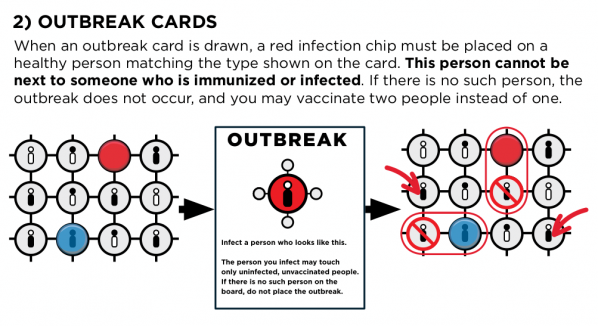
EG: In most games, a competitive element is introduced to result in a ‘winner’ and ‘loser’. POX deliberately avoids this convention, encouraging players to work together in order to stop the virus. Why was the game designed for this mode of play?
MF: One of the ethos of Tiltfactor games is cooperative play. We like to make games in which players can use collaborative strategy. We define collaborative strategy games as those in which:
1. Games (or in some situations, components of games) where if one player reaches the lose state, everyone playing also loses;
2. The extent to which players win is positively correlated to the success of other players.
Often the most interesting games do not fit comfortably into stereotypical models of play. And because we make games about less traditional topics — public health, layoffs, GMO crops, and other political and social challenges –it is important that the game model itself reflect that. In educational scenarios or in community development, games mirror more closely the ways in which people work together to solve problems. So, the reason that POX is a cooperative game are deeply set in the lab ethos towards problem solving — we can only solve problems together.
EG: You are working on a digital version of the game for the iPad. What was your rational for approaching the topic through both a digital and physical platform and do you think these result in a different type of engagement?
MF: Yes — we’re also creating an iPad version and have an online version to launch as well. It is fascinating to make multiplatform games like this– we are a small lab so we’re doing most everything ourselves, including packaging, promotion, and research.
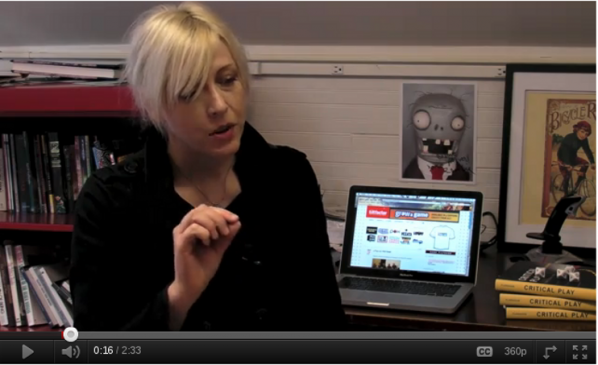
The differences between the platforms for the game are so dramatic, we’ve decided to conduct a study with the same game and different platforms, because watching people play the same game, the same rules, on a different platform clearly results in an different play experience. It is clear to me that very different things are going on, and I want to back up claims with data. For example, players play much faster if the game is computer based via an online game or the iPad. Players seem to like pressing buttons fast. In the board game, for example, observation shows us that players pick up pieces and discuss the moves with the other players, considering this option and that. The game piece actually becomes a kind of thinking object, I don’t know for sure, but it is very different. The speed up in time with a computer-based game appears to cut down conversation and meaningful dialogue that we’ve recorded in our last study on the board game. So, this is something that as games makers we’d really like to understand better, and share with others.
As an artist, I’m known to make media art and works that engage with play and game culture. In the laboratory context, I love developing and researching games with my team. I have amazing people to work with: Sukdith Punjasthitkul is my project manager who has a background in underground Asian culture, public health, and tennis; Zara Downs is a graphic designer and rural hipster who loves biology; Max Seidman is my accomplished undergraduate engineering student who has racked up several games in his time at the lab, and he loves wearing vests. Matt Cloyd is working with me, a recent graduate who is involved in sustainability issues in communities. Erika Murillo is a new student team member obsessed with social issues and animation. The list goes on. Part of the mission of what we do is to help the next generation who care about social issues have the tools to push what we do now, further.
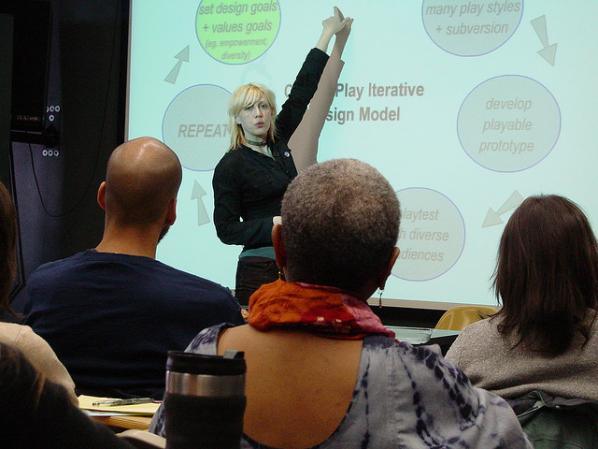
EG: Your point about how you’ve found players to engage more in dialogue when involved in a board game is very interesting. Non digital games such as board games and pervasive urban games have become more popular over the past few years; do you think players are desiring a more socially interactive experience?
MF: Board games are enjoying a renaissance, it is true. First, because I think people really like playing together in a physical space. Perhaps the new technologies — Wii and Kinect — remind people of that. Perhaps they played recently at a family gathering and remembered how much fun they are. It is impossible to say. Second, there are some really well-designed games out there right now, and available in many countries (in part, due to online purchase power), that are certainly worth playing. People do really like playing with each other in physical space, and they still enjoy watching sports in person. Technology can help facilitate this as with mobile games and pervasive games, but it is not a requirement for a good game. I think different kinds of conversations may happen over board games as compared to digital games, but this is something that needs some data behind it. So, we’ll be doing a study on these nuances in my lab very soon.
EG: Looking at Huizinga’s idea of ‘the magic circle’, there is a clear boundary between play and non-play. What were the challenges in designing a game which straddles this boundary, on one hand trying to entice participants through play and interaction, and on the other attempting to create real life social change?
MF: Emilie, this is the riding question for all of game design engaged with social issues, and behind all of the debates on how gamification can incite real behavioural and social change. You’ve hit the nail on the head! There are many forms of play, some which stay within the game in a nice neat package, like our board game, and some that bleed over into real life, such as ARGs. But one should not be fooled into thinking that this means that the former is useless for education and social change, and the latter is obviously better at it. We are about to release our pilot study on the learning in the game, and the results are surprising, showing that learning transfers out of the game as players can apply concepts in the game to new topics. We’re careful researchers. As artists, and as people critical of flippant comments about games and change, we don’t take research lightly. We don’t, for example, cite major gains on attitudinal change and make assumptions on long term behavioural change from a 40-minute game play session. That would be bad science. So we scale our questions accordingly, and in fact, are still surprised and pleased by the effect the game has. I’ll update you on the specifics when the paper is published this autumn!
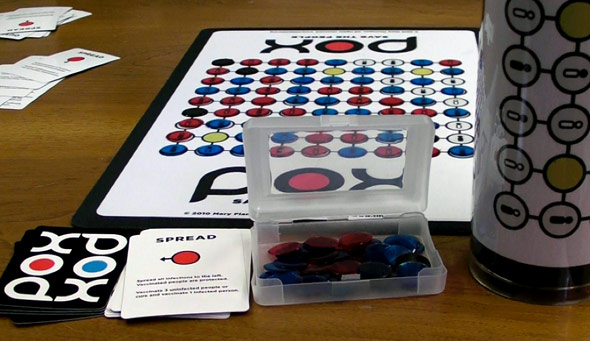
The deeper issues on the limits of how games can incentivise real behavioural and social change can get rather dark. How Pavlovian do we want to be in influencing people? Even those in social change arenas have to pause and think. Education and influence for good is what we strive for. Designers and companies can only go so far before we have something much more sinister at hand. This is why our team’s work on the Values at Play project (http://www.valuesatplay.org) remains relevant.
The first interview with Jake Harries, took place on one of Furtherfield’s Radio broadcasts on Resonance FM, earlier this March 2011. Fascinated by the historical context that came out of the radio discussion, we asked Jake for a second interview, this time it took place via email.
Jake Harries has been making music in Sheffield since the 1980s and is a sound artist, musician/producer, composer and field recordist with a strong interest in media art and the practical use of Open Source audio-visual software. He was a member of electronic funk band Chakk which is best known for building Sheffield’s first large recording studio, FON Studios, in the mid 1980s. He is currently one of “freestyle techno” trio Heights of Abraham and The Apt Gets, a band which uses guitars and only Open Source software on recycled computers to create songs from spam emails. He is Digital Arts Programme Manager at open access media lab, Access Space, and the current curator of the LOSS Linux Open Source Sound a website dedicated to music made with FLOSS.
Marc Garrett: Lets talk a bit about your own history first. You were in a band in the 80s called Chakk, could you tell us a bit about that?
Jake Harries: Chakk was based in Sheffield during the mid 80s and we are best known for building a heavily used facility, FON Studio, Sheffield’s first large commercial recording studio. Chakk made “industrial funk” music, a mix of funk base lines and drums with influences ranging from punk to soul to free jazz and electronica. Our music was aimed squarely at the dance floor. We believed that technology, in this case the recording studio, was the most important instrument a band could have both creatively and financially.
MG: So, you are part of the electro music history of Sheffield with bands like Cabaret Voltaire & The Human League in the late 70s – 80s?
JH: Yes, but the band itself didn’t have too much commercial success, a couple of indie chart top 10s and a couple of low 50s in the main UK chart, so few people remember us now. People are more likely to remember FON Studio.
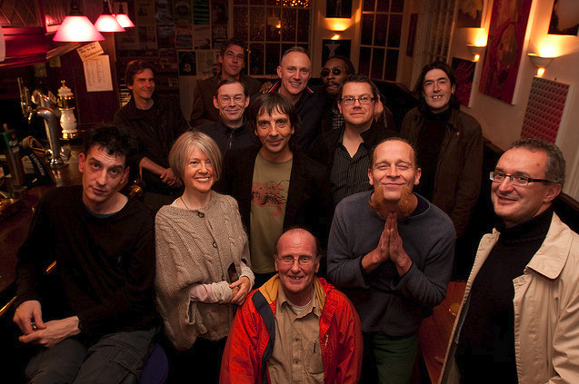
Recently a documentary has been made, called The Beat Is Law, about Sheffield music at that time, so perhaps there will be a bit more interest in the band.

MG: Open Source software is freely downloadable from the Internet for free and Linux is the most widely used Open Source operating system. How long have you been using Linux operating systems and Open Source?
JH: I had heard of Linux before, of course, but I came across music applications which were developed only for Linux in 2002-3 while searching for new software tools. These intrigued me sufficiently to install the operating system on a pc which I had fixed where I was working at the time.
MG: Do you feel that artists, techies and others are choosing Free and Open Source resources for reasons which connect with ethical and environmental issues and concerns?
JH: Well, I’d like to integrate into this answer the general themes of openness and transparency. FLOSS is akin to an encyclopedia of how to make things in the software realm because all the code is available for anyone to download and develop; closed, proprietary software is like a “sealed box” which it is illegal to prise open.
But it goes a bit deeper than that: in the world we are living in now the “sealed box” is increasingly becoming the mode of choice for all kinds of products, most of which, because they are designed to be superseded, have built in obsolescence. When something goes wrong with a product, you are unable to fix it yourself because you can’t get inside it, and even if you could you can’t find out how to fix it. If it is out of warranty, either you pay a lot of money to get it fixed or you throw it away; then you buy a new one! (Which is what the market wants you to do…)
So, it feels very much as if we are surrounded by technology we are not encouraged to understand and products with a limited life span: the obvious environmental concern is, “what happens to my ‘sealed box’ when I throw it away?”
Using a Linux operating system can increase the useful life of a computer by several years, and perhaps, if you can hack into them, other products too. So it is great if both hardware and software are open.
We also know that sharing knowledge is generally considered to be a good thing as it allows people to build on what has already been discovered. Being able to give the people in workshops the software they have been learning to use because it is FLOSS, rather than them having to pay several hundred pounds because it is only available on a commercial license, is great and often the idea of this kind of freedom takes a while for people to get used to if they’ve not come across it before.
MG: Why is it important as a creative practitioner to be using Open Source?
JH: Well, personally, I have realised that what I’m interested in is freedom, not just as a hypothetical, but the practical reality, finding out how to achieve some of it and if it is possible to sustain it. Free & Open Source operating systems and software are one way of stepping out side of the constant pressures of the commercial market places which dominate our culture.
We tried this in Chakk in the 80s with FON Studio, attempting not only to personally own the means of producing our music, the studio (allowing us to be outside the corporate system of production), but also to be able to explore our creativity in the way we wanted to. In the case of Chakk it didn’t work out. We had, rather cheekily, persuaded a giant corporate (MCA Records, owned by Universal) to bank roll it all and they found ways of scuppering our plan by making our product conform to their idea of the market place: transforming it into something “radio friendly” and bland, taking the energy and urgency out of the music. We were quite a politicised band and that energy was essential to our musical integrity.

However, when MCA dropped us we had a recording studio which could help nurture new music without too much external pressure, and this led to records produced there by local acts fulfilling their potential and going into the charts.
I think it is important for artists to have certain freedoms, to have ownership over the means with which they create their work. The fact that FLOSS allows you the user the potential of customising the tools you use and to distribute them freely via the web or other means is quite profound. And one of the real benefits of using FLOSS as a creative practitioner are the use of open standards and formats.
MG: OK, let’s move onto your own band: The Apt Gets. Now, since The Human League & Cabaret Voltaire, a whole generation has experienced the arrival of the Internet. Your group seems to reflect this aspect of contemporary, networked culture – a kind of Open Source rock band. Could you tell us about this band The Apt Gets, how you all got started and why?
JH: It began with workshops I was leading for musicians on FLOSS audio tools in 2007. The idea of an “open source rock band” came up – at the time we didn’t think there was one so a couple of the workshoppers and myself formed one. The Internet was the main source of inspiration really: we used recycled computers with Linux we’d downloaded, as well as guitars and vocals. I’m interested in re-purposing junk as raw material for creative processes and decided to re-use some of my spam emails as lyrics. We all hate spam, but re-contextualising it like this is fun, as is introducing a song by saying, “Here’s a classic Nigerian email asking for your bank details”. The themes of spam emails are generally things like greed & money, status & sex appeal as well as “meds”, so there’s more to them than you might think.
MG: Now, I personally know why, but others who are not as familiar with Linux and Open Source Operating systems, will not immediately know this. The naming of your band’s name – it’s specific to installing software. Could you tell us more about that?
JH: On a Debian Linux based operating system one can install software from the internet using an application called apt. One could type apt-get install the-name-of-the-software into the command line and apt will get the software from what is called a repository on the Internet, where the software is stored for download. We thought that if you called someone an Apt Get it could be interpreted as an insult meaning something like, clever bastard. So, that’s why we named the band The Apt Gets.

MG: How long has your research project with FLOSS been going?
JH: The research project started in 2007. Ever since I began to use FLOSS I’ve been interested in the practical realities of using it, particularly as an every day set of tools, as an ordinary computer user would use it: for instance, when I do work on the arts programme at Access Space I don’t use anything else. So, it made sense to discover how a number of non-Linux using musicians would find using FLOSS audio tools – if I was being an advocate for FLOSS I ought to look at it from the new user’s angle and discover how far they could go and what kind of time scale they need.
MG: And the web site address is?
JH: http://audiotools.lowtech.org
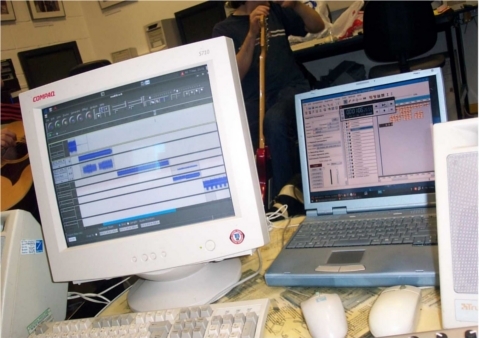
MG: How easy is it for someone with little or no experience of Open Source software and Linux based operating systems to install it?
JH: It is quite easy nowadays. A Linux distribution like Ubuntu has an easy to follow installer which allows you to create a dual boot if you want it, that is, keeping your Windows system as well so you have the choice of both.
MG: At Access Space in Sheffield, you are curator and researcher of LOSS (Linux Open Source Sound) a website dedicated to music made with FLOSS – which is basically LOSS with the letter ‘F’ added, meaning ‘Free Linux Open Source Sound’ – FLOSS!
JH: Yeah! Free is the word! It is a repository for music made with FLOSS tools and released under a Creative Commons license. You can freely download and upload tracks. Initially it was based around two projects, a physical CD issued in 2006 curated by Ed Carter, and LOSS Livecode, a mini conference and gig curated by Alex McLean and Jim Prevett based around the international livecoding community. The website is at http://loss.access-space.org.
MG: What is Access Space and what is different about them as a group?
JH: Access Space is an open access media lab, based in central Sheffield. It uses reused and donated computer technology to provide Internet access and Open Source creative tools, free of charge, five days a week. It started in 2000 and has become the longest running free Internet project in the UK.
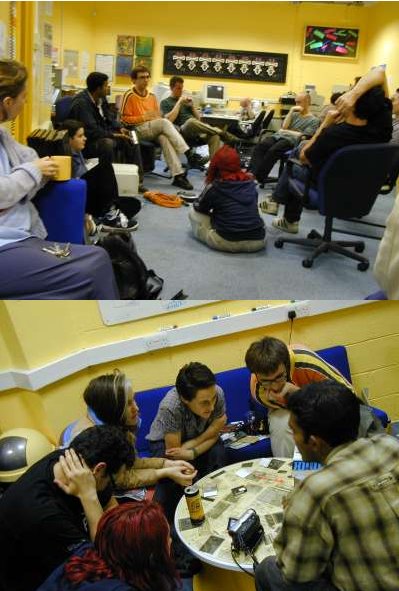
We recycle computers, put on art exhibitions, creative workshops and sonic art events. We’re currently developing a DIY Lab, modelled on MIT’s FabLab or fabrication laboratory. This will be an interface between the physical and digital domains where new kinds of creative activity can be developed.
MG: What operating systems would you suggest to newbies coming to Linux for the first time?
JH: Ubuntu or its derivative, Linux Mint, are both very user friendly for everyday use. For audio try Ubuntu Studio, 64 Studio or Pure:dyne.
MG: And regarding yourself, what are you using?
JH: I have set up eight Ubuntu Studio pcs for use in audio and video workshops at Access Space; and I use Pure:dyne live DVDs if I’m out and demonstrating on other people’s pcs. For everyday use, again Ubuntu Studio with a few additional applications like OpenOffice.
MG: Thank you for a fascinating conversation.
JH: It was a pleasure…
Open Access All Areas: an Interview with James Wallbank about Access Space by Charlotte Frost
http://www.metamute.org/en/Open-Access-All-Areas
Ubuntu Studio 11.04 release.
http://ubuntustudio.org/
64 Studio Ltd. produces bespoke GNU/Linux distributions which are compatible with official Debian and Ubuntu releases. http://www.64studio.com/
Puredyne is the USB-bootable GNU/Linux operating system for creative multimedia.
http://puredyne.org/
Pure:dyne Discussion, interview by Marc Garrett & Netbehaviour list Community 2008.
http://www.furtherfield.org/interviews/puredyne-discussion-netbehaviour
Featured image: Walled out and hammered by Marc Garrett
A young guy in his early Twenties becomes curious about the world of the arts. He decides to do what others would do in these circumstances: he picks up a few arts magazines from a local newsstand and browses their content looking for the latest trends. However, he increasingly becomes frustrated with the amount of advertisements that fill these magazines, that appear to prevail over any sustained discussion on the arts. He dislikes the way art looks more like a big commercial circus than the honest display of creative talent. He grows disaffected with the patronizing tones of editors and so-called authorities in the field.
He decides to denounce this publicly by creating an online fake of Flash Art online, the current leading contemporary art magazine in Italy, choosing the telling URL of ashartonline.com (as opposed to flashartonline.com), and filling it with his own content. Following the magazine’s distribution (for a fee) of a publication that claims to contain the contacts of over 30000 galleries and curators (the Arts Diary), he decides to compile his own list of 3300 artists and art dealers contacts searchable online and to make it available for download (for free) to anyone. Noticing the patronizing tone and the rude replies that Flashart director, Giancarlo Politi, dispenses to whomever objects to his artistic and editorial choices, he creates a forum (letters to the Director, part 2) that encourages disgruntled artists and critics to voice their discontents. The website grows and receives a considerable number of hits. Not enough for being properly considered mainstream, but still a pesky doppelgänger and a welcome critique of Flash Art. The success that this modest détournement enjoyed during the six months of its existence showed that Luca Lo Coco, the young creator of ashartonline definitely had a point.
At this point the story sounds a lot like many other stories of netartists and netactivists who have directed their criticism towards institutions and corporations, or towards other fellow artists and arts databases, by cloning, hacking, spoofing, and mocking websites to short-circuit the usually lethargic and cynical flow of information that characterizes institutionalized outlets. Countless groups and collectives like the Yes Men, 0100101110101101.org, and later Ubermorgen, Paolo Cirio and Alessandro Ludovico, to different degrees, have practiced and supported this and similar tactics for years. Posing as WTO representatives or Spokespeople of major corporations, The Yes Men have made the fake as their main tactic since the mid-nineties to draw attention to the shady practices that organizations such as the GATT and WTO were conducting under the nose of unaware and apathetic individuals; operating within the independent art world and often turning their attacks towards this very domain, the 0100101110101101.org have perfected the practice of forgery of logos, artists and artworks to unveil the laziness of an art establishment more interested in the popularity of the artist signing the artwork than in the quality of the artwork itself, more focused on ways to sell art rather than honestly evaluating it, more preoccupied with establishing powerful networks with other equally powerful art critics and dealers rather than actually doing some genuine research. Inspired by Andy Warhol, Dadaism and the avant-garde and empowered by the technical potentials of digital media, the pranks and actions of these artists and media practitioners have become well-known among anyone interested in media activism and artivism, or among anyone who finds at least some cursory interest in media creativity.
Given the precedents, Luca Lo Coco’s take on Flashartonline is not an exception. Ashartonline was a website that exploited the spoof against the formulaic and uninspired direction of the arts publishing in Italy and the condescending attitude of a bunch of self-elected gate-keepers of the arts. In a typical situation however, maybe this site would have been remembered as one among many actions, a grain of sand in a desert. Maybe, the website would have enjoyed some short-lived popularity among a relatively limited supporters, but as it often happens in these circumstances, it would have likely been ignored by the director and the magazine it was criticizing, or just forced to shut down. In the end, Ashartonline was a clever website, but it was also fairly innocuous, barely scratching the surface of the colossal enterprise it was targeting.
Disregard, or pretending nothing has happened, has always been the most effective reaction of a targeted institution against spoofs, parodies and fakes. Unsurprisingly, when the Yes Men appeared on BBC posing as Union Carbide reps announcing that the company was ready to take responsibility for the Bhopal disaster on its twentieth anniversary, the real reps retracted the announcement but then didn’t bother going after the pranksters, behaving as if the episode hadn’t even occurred. They knew that starting a legal action would have drawn too much negative attention to the company and given free publicity to the Yes Men [1]. When the 0100101.org recently revealed that an installation of a cat in a cage [2] had not been executed by art star Maurizio Cattellan but had been created by the duo themselves, no fuss was made and no legal charges were issued. Instead, a simple disclaimer was issued [3]. The piece, as the artists themselves explained, went “back to the Internet,” from which the idea (and the picture of the cat) had originally emerged.
However, for reasons that we all fail to understand, the story of ashartonline took quite a different direction. Luca Lo Coco found himself at the center of a vicious attack initiated by the director of Flash Art Giancarlo Politi himself: not only was the website shut down, a surprising, but not totally unexpected outcome, but a judicial case which lasted for over three years ensued. Politi, it turned out, sued Lo Coco for infringement of intellectual property and other counts of damage for a total amount of 200,000 Euros. Even the judge didn’t find Ashartonline damaging enough to justify the absurd indemnity. However, he admitted, the website could have been the cause of a certain confusion (meaning that it had achieved his goal, a small consolation for Lo Coco). Thus, Lo Coco was given a deadline to pay a much smaller, yet still unaffordable fee of around Euro 7,000, a mix of legal fees and other bureaucratic expenses. When he did not produce the money, officers showed up at his door to confiscate his furniture.
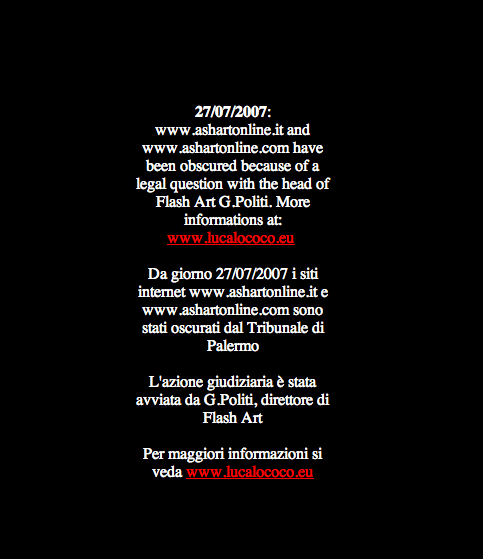
Now, some might contend that Politi, might not responsible for the cruel epilogue of this story, an extraordinary and strangely efficient move by the justice system, especially considering that the whole story takes place in Italy. Apparently, it was Politi who insisted that the confiscation went ahead as quickly as possible. This last bit adds even more outrage to this already absurd story, whose unfolding has already catalyzed a number of incendiary discussions on various Italian-based listservs and arts magazines [4]. In fact, to add insult to injury, the value of the furniture confiscated from Lo Coco falls short the amount he owes Politi. One wonders whether this is the end of the story or we should expect more surprises.
What makes this ordeal especially controversial and absurd is not the style Lo Coco used to splash his criticism on a website. It is the exaggerated reaction of the director of a respectable arts magazine who should have known better, but went all the way against an individual who was no particular threat to the publishing giant and who had no way to seek protection against his ire. At least a couple of reasons should have prevented Politi from keeping going at Lo Coco: first, if the precedents set by the egregious examples of 01001.org and the Yes Men may teach us anything, no counterattack has ever turned out to be the best reaction against spoofs and satires; second, as most of these examples have been recognized as forms of creative activism or as arts interventions, they should have been known to an arts publisher who claims to be knowledgeable on the emerging and most recent contemporary arts. Why this ridiculously ruthless reaction? Did Politi really fear (mistakenly) that Lo Coco website could constitute a threat to his magazine and its readership? Why didn’t he stop once he had obtained to have the website obfuscated? Did he think that letting a lone challenger have his way would have unleashed a whole horde of jackals just waiting for the right opportunity to disrupt his undisturbed realm? Was this an exemplar punishment?
Lo Coco, with his young age and, at the time Politi pressed charges, with a limited experience of the arts world as well as a almost non-existent network of allies to consult for mentorship and advice, was a really easy, too easy target. Thus, this action appears to be a rather gratuitous show off of power (both symbolic and material) towards someone who was virtually defenseless. Even more disturbing is the ludicrous amount of money that was asked from Lo Coco for the so-called damages caused to Flash Art. Politi’s move to silence (and of course defeat) Lo Coco using financial superiority is a trend that actually reveals the director’s personal view of where power resides, confirming exactly what Lo Coco wished to demonstrate with his website: power in the arts business is not measured on the basis of some cultural, or intellectual value and skills, but on money.
Second, Politi’s exaggerated reaction appeared to become gradually an act of intimidation directed to the whole independent arts community rather than a personal affair between him and Lo Coco. The latter, on the other hand, was the perfect scapegoat, the sacrificial lamb that would serve to re-affirm loudly and ostensively the power of BIG ART, authority, hierarchy, and institutions against the younger, subversive, independent emerging arts. The message sounds loud and clear: see what happens when you dare criticizing the powerful and dare not playing by the rules established by the Artsworld? This sounded like a warning to all young and independent artists, just in case they have the temptation in the future to challenge the existing power dynamics hierarchies. Had art star Maurizio Cattellan created something similar to Lo Coco’s, asks journalist Helga Marsala in an article dedicated to the episode, “…what would have happened? Clearly, no accusation, no lawsuit. On the contrary, Politi would have even dedicated a magazine cover to this work [5]”
Ultimately, what happened might have been a source of great (financial) discomfort to Lo Coco. He probably would have never thought that such dispute would be taken this far. However, the circumstances of this episode unleashed a great deal of solidarity and sympathy towards Lo Coco-David fighting against the taxidermized and conventional Politi-Goliath. Many individuals offered to get the voice out or to write notes and articles about this outrageous episode. This means that there exists a –somehow—unified network out there ready to take action when such crises ensue. In the long run then, this unexpected cohesion might cause more discomfort to Politi. He thought he would just get away with annihilating his enemy. However, if Lo Coco really bothered him, suing him might have just been the wrong move. In fact, If he had done his homework he would have probably known what happens when you try to defeat your adversary in this way: you might inadvertently create more publicity for him. This story has already given Lo Coco much more visibility and respect than he would have gotten, had he not being sued and humiliated in this way. In other words, this story has already put his name among those subversive artists who have no problem challenging the system. In addition, the same sudden emergency that cost Lo Coco his furniture and that initiated the just mentioned encouraging wave of support, also caused a great deal of thinking and brainstorming on how to react (creatively, of course) against Politi and other’s bold attack. Thus, we should all thank Politi for having given us an idea for future critical (and humorous) actions against his magazine and his arrogant attitude, as well as for having reinvigorated and definitely strengthened our network.
“At the dawn of the new millennium, Net users are developing a much more efficient and enjoyable way of working together: cyber-communism.” Richard Barbrook.
Dmytri Kleiner, author of The Telekommunist Manifesto, is a software developer who has been working on projects “that investigate the political economy of the Internet, and the ideal of workers’ self-organization of production as a form of class struggle.” Born in the USSR, Dmytri grew up in Toronto and now lives in Berlin. He is a founder of the Telekommunisten Collective, which provides Internet and telephone services, as well as undertakes artistic projects that explore the way communication technologies have social relations embedded within them, such as deadSwap (2009) and Thimbl (2010).
“Furtherfield recently received a hard copy of The Telekommunist Manifesto in the post. After reading the manifesto, it was obvious that it was pushing the debate further regarding networked, commons-based and collaborative endeavours. It is a call to action, challenging our social behaviours and how we work with property and the means of its production. Proposing alternative routes beyond the creative commons, and top-down forms of capitalism (networked and physical), with a Copyfarleft attitude and the Telekommunist’s own collective form of Venture Communism. Many digital art collectives are trying to find ways to maintain their ethical intentions in a world where so many are easily diverted by the powers that be, perhaps this conversation will offer some glimpse of how we can proceed with some sense of shared honour, in the maelstrom we call life…”
Marc Garrett: Why did you decide to create a hard copy of the Manifesto, and have it republished and distributed through the Institute of Networked Cultures, based in Amsterdam?
Dmytri Kleiner: Geert Lovink contacted me and offered to publish it, I accepted the offer. I find it quite convenient to read longer texts as physical copies.
MG: Who is the Manifesto written for?
DK: I consider my peers to be politically minded hackers and artists, especially artists whose work is engaged with technology and network cultures. Much of the themes and ideas in the Manifesto are derived from ongoing conversations in this community, and the Manifesto is a contribution to this dialogue.
MG: Since the Internet we have witnessed the rise of various networked communities who have explored individual and shared expressions. Many are linked, in opposition to the controlling mass systems put in place by corporations such as Facebook and MySpace. It is obvious that your shared venture critiques the hegemonies influencing our behaviours through the networked construct, via neoliberal appropriation, and its ever expansive surveillance strategies. In the Manifesto you say “In order to change society we must actively expand the scope of our commons, so that our independent communities of peers can be materially sustained and can resist the encroachments of capitalism.” What kind of alternatives do you see as ‘materially sustainable’?
DK: Currently none. Precisely because we only have immaterial wealth in common, and therefore the surplus value created as a result of the new platforms and relationships will always be captured by those who own scarce resources, either because they are physically scarce, or because they have been made scarce by laws such as those protecting patents and trademarks. To become sustainable, networked communities must possess a commons that includes the assets required for the material upkeep of themselves and their networks. Thus we must expand the scope of the commons to include such assets.
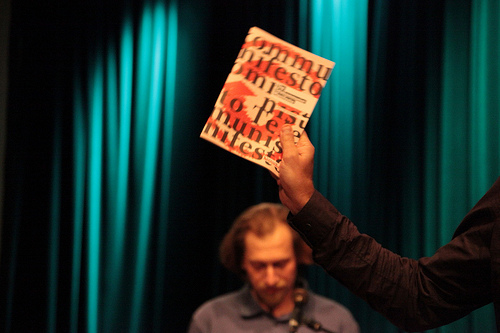
MG: The Manifesto re-opens the debate around the importance of class, and says “The condition of the working class in society is largely one of powerlessness and poverty; the condition of the working class on the Internet is no different.” Could you offer some examples of who this working class is using the Internet?
DK: I have a very classic notion of working class: Anyone whose livelihood depends on their continuing to work. Class is a relationship. Workers are a class who lack the independent means of production required for their own subsistence, and thus require wage, patronage or charity to survive.
MG: For personal and social reasons, I wish for the working class not to be simply presumed as marginalised or economically disadvantaged, but also engaged in situations of empowerment individually and collectively.
DK: Sure, the working class is a broad range of people. What they hold in common is a lack of significant ownership of productive assets. As a class, they are not able to accumulate surplus value. As you can see, there is little novelty in my notion of class.
MG: Engels reminded scholars of Marx after his death that, “All history must be studied afresh”[1]. Which working class individuals or groups do you see out there escaping from such classifications, in contemporary and networked culture?
DK: Individuals can always rise above their class. Many a dotCom founder have cashed-in with a multi-million-dollar “exit,” as have propertyless individuals in other fields. Broad class mobility has only gotten less likely. If you where born poor today you are less likely than ever to avoid dying poor, or avoid leaving your own children in poverty. That is the global condition.
I do not believe that class conditions can be escaped unless class is abolished. Even though it is possible to convince people that class conditions do not apply anymore by means of equivocation, and this is a common tactic of right wing political groups to degrade class consciousness. However, class conditions are a relationship. The power of classes varies over time, under differing historical conditions.
The condition of a class is the balance of its struggle against other classes. This balance is determined by its capacity for struggle. The commons is a component of our capacity, especially when it replaces assets we would otherwise have to pay Capitalist-owners for. If we can shift production from propriety productive assets to commons-based ones, we will also shift the balance of power among the classes, and thus will not escape, but rather change, our class conditions. But this shift is proportional to the economic value of the assets, thus this shift requires expanding the commons to include assets that have economic value, in other words, scarce assets that can capture rent.
MG: The Telekommunist Manifesto, proposes ‘Venture Communism’ as a new working model for peer production, saying that it “provides a structure for independent producers to share a common stock of productive assets, allowing forms of production formerly associated exclusively with the creation of immaterial value, such as free software, to be extended to the material sphere.” Apart from the obvious language of appropriation, from ‘Venture Capitalism’ to ‘Venture Communism’. How did this idea come about?
DK: The appropriation of the term is where it started.
The idea came about from the realization that everything we were doing in the free culture, free software & free networks communities was sustainable only when it served the interests of Capital, and thus didn’t have the emancipatory potential that myself and others saw in it. Capitalist financing meant that only capital could remain free, so free software was growing, but free culture was subject to a war on sharing and reuse, and free networks gave way to centralized platforms, censorship and surveillance. When I realized that this was due to the logic of profit capture, and precondition of Capital, I realized that an alternative was needed, a means of financing compatible with the emancipatory ideals that free communication held to me, a way of building communicative
infrastructure that was born and could remain free. I called this idea Venture Communism and set out to try to understand how it might work.
MG: An effective vehicle for the revolutionary workers’ struggle. There is also the proposition of a ‘Venture Commune’, as a firm. How would this work?
DK: The venture commune would work like a venture capital fund, financing commons-based ventures. The role of the commune is to allocate scarce property just like a network distributes immaterial property. It acquires funds by issuing securitized debt, like bonds, and acquires productive assets, making them available for rent to the enterprises it owns. The workers of the enterprises are themselves owners of the commune, and the collected rent is split evenly among them, this is in addition to whatever remuneration they receive for work with the enterprises.
This is just a sketch, and I don’t claim that the Venture Communist model is finished, or that even the ideas that I have about it now are final, it is an ongoing project and to the degree that it has any future, it will certainly evolve as it encounters reality, not to mention other people’s ideas and innovations.
The central point is that such a model is needed, the implementation details that I propose are… well, proposals.
MG: So, with the combination of free software, free code, Copyleft and Copyfarleft licenses, through peer production, does the collective or co-operative have ownership, like shares in a company?
DK: The model I currently support is that a commune owns many enterprises, each independent, so the commune would own 100% of the shares in each enterprise. The workers of the enterprises would themselves own the commune, so there would be shares in the commune, and each owner would have exactly one.
MG: In the Manifesto, there is a section titled ‘THE CREATIVE ANTI-COMMONS’, where the Creative Commons is discussed as an anti-commons, peddling a “capitalist logic of privatization under a deliberately misleading name.” To many, this is a controversy touching the very nature of many networked behaviours, whether they be liberal or radical minded. I am intrigued by the use of the word ‘privatization’. Many (including myself) assume it to mean a process whereby a non-profit organization is changed into a private venture, usually by governments, adding extra revenue to their own national budget through the dismantling of commonly used public services. Would you say that the Creative Commons, is acting in the same way but as an Internet based, networked corporation?
DK: As significant parts of the Manifesto is a remix of my previous texts, this phrase originally comes from the longer article “COPYRIGHT, COPYLEFT AND THE CREATIVE ANTI-COMMONS,” written by me and Joanne Richardson under the name “Ana Nimus”:
http://subsol.c3.hu/subsol_2/contributors0/nimustext.html
What we mean here is that the creative “commons” is privatized because the copyright is retained by the author, and only (in most cases) offered to the community under non-commercial terms. The original author has special rights while commons users have limited rights, specifically limited in such a way as to eliminate any possibility for them to make a living by employing this work. Thus these are not commons works, but rather private works. Only the original author has the right to employ the work commercially.
All previous conceptions of an intellectual or cultural commons, including anti-copyright and pre-copyright culture as well as the principles of free software movement where predicated on the concept of not allowing special rights for an original author, but rather insisting on the right for all to use and reuse in common. The non-commercial licenses represent a privatization of the idea of the commons and a reintroduction of the concept of a uniquely original artist with special private rights.
Further, as I consider all expressions to be extensions of previous perceptions, the “original” ideas that rights are being claimed on in this way are not original, but rather appropriated by the rights-claimed made by creative-commons licensers. More than just privatizing the concept and composition of the modern cultural commons, by asserting a unique author, the creative commons colonizes our common culture by asserting unique authorship over a growing body of works, actually expanding the scope of private culture rather than commons culture.
MG: So, this now brings us to Thimbl, a free, open source, distributed micro-blogging platform, which as you say is “similar to Twitter or identi.ca. However, Thimbl is a specialized web-based client for a User Information protocol called Finger. The Finger Protocol was orginally developed in the 1970s, and as such, is already supported by all existing server platforms.” Why create Thimbl? What kind of individuals and groups do you expect to use it, and how?
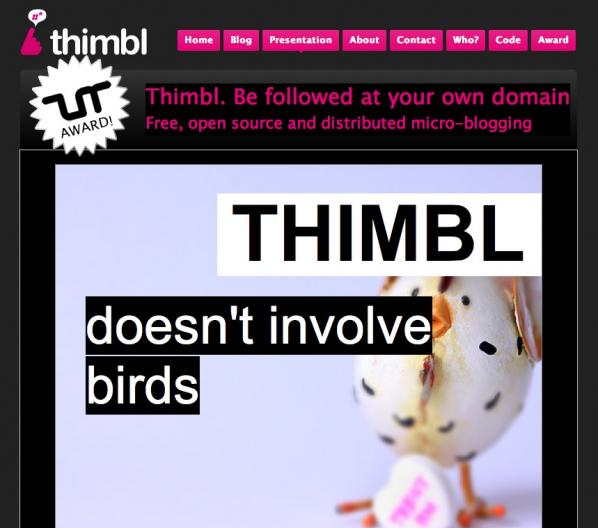
DK: First and foremost Thimbl is an artwork.
A central theme of Telekommunisten is that Capital will not fund free, distributed platforms, and instead funds centralized, privately owned platforms. Thimbl is in part a parody of supposedly innovative new technologies like twitter. By creating a twitter-like platform using Finger, Thimbl demonstrates that “status updates” where part of network culture back to the 1970s, and thus multimillion-dollar capital investment and massive central data centers are not required to enable such forms of communication, but rather are required to centrally control and profit from them.
MG: In a collaborative essay with Brian Wyrick, published on Mute Magazine ‘InfoEnclosure-2.0’, you both say “The mission of Web 2.0 is to destroy the P2P aspect of the Internet. To make you, your computer, and your Internet connection dependent on connecting to a centralised service that controls your ability to communicate. Web 2.0 is the ruin of free, peer-to-peer systems and the return of monolithic ‘online services’.”[2] Is Thimbl an example of the type of platform that will help to free-up things, in respect of domination by Web 2.0 corporations?
DK: Yes, Thimbl is not only a parody, it suggests a viable way forward, extending classic Internet platforms instead of engineering overly complex “full-stack” web applications. However, we also comment on why this road is not more commonly taken, because “The most significant challenge is not technical, it is political.” Our ability to sustain ourselves as developers requires us to serve our employers, who are more often than not funded by Capital and therefore are primarily interested in controlling user data and interaction, since delivering such control is a precondition of receiving capital in the first place.
If Thimbl is to become a viable platform, it will need to be adopted by a large community. Our small collective can only take the project so far. We are happy to advise any who are interested in how to join in. http://thimbl.tk is our own thimbl instance, it “knows” about most users I would imagine, since I personally follow all existing Thimbl users, as far as I know, thus you can see the state of the thimblsphere in the global timeline.
Even if the development of a platform like Thimbl is not terribly significant (with so much to accomplish so quickly), the value of a social platform is the of course derived from the size of it’s user base, thus organizations with more reach than Telekommunisten will need to adopt the platform and contribute to it for it to transcend being an artwork to being a platform.
Of course, as the website says “the idea of Thimbl is more important than Thimbl itself,” we would be equally happy if another free, open platform extending classic Internet protocols where to emerge, people have suggested employing smtp/nntp, xmmp or even http/WebDav instead of finger, and there are certain advantages and disadvantages to each approach. Our interest is the development of a free, open platform, however it works, and Thimbl is an artistic, technical and conceptual contribution to this undertaking.
MG: Another project is the Telekommunisten Facebook page, you have nearly 3000 fans on there. It highlights the complexity and contradictions many independents are faced with. It feels as though the Internet is now controlled by a series of main hubs; similar to a neighbourhood being dominated by massive superstores, whilst smaller independent shops and areas are pushed aside. With this in mind, how do you deal with these contradictions?
DK: I avoided using Facebook and similar for quite some time, sticking to email, usenet, and irc as I have since the 90s. When I co-authored InfoEnclosure 2.0, I was still not a user of these platforms. However it became more and more evident that not only where people adopting these platforms, but that they were developing a preference for receiving information on them, they would rather be contacted there than by way of email, for instance. Posting stuff of Facebook engaged them, while receiving email for many people has become a bother. The reasons for this are themselves interesting, and begin with the fact that millions where being spent by Capitalists to improve the usability of these platforms, while the classic Internet platforms were more or less left as they were in the 90s. Also, many people are using social media that never had been participants in the sorts of mailing lists, usenet groups, etc that I was accustomed to using to share information.
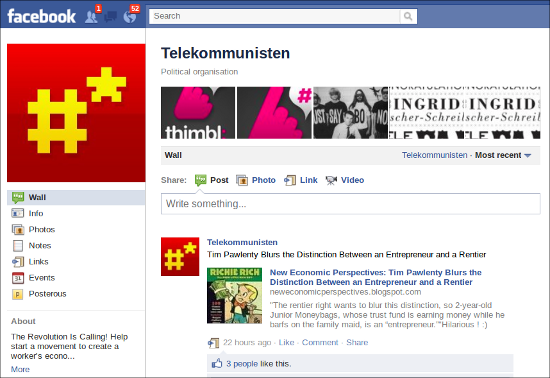
If I wanted to reach people and share information, I needed to do so on the technologies that others are using, which are not necessarily the ones I would prefer they use.
My criticism of Facebook and other sites is not they are not useful, it is rather that they are private, centralized, proprietary platforms. Also, simply abstaining from Facebook in the name of my own media purity is not something that I’m interested in, I don’t see capitalism as a consumer choice, I’m more interested in the condition of the masses, than my own consumer correctness. In the end it’s clear that criticizing platforms like Facebook today means using those platforms. Thus, I became a user and set up the Telekommunisten page. Unsurprisingly, it’s been quite successful for us, and reaches a lot more people than our other channels, such as our websites, mailing lists, etc. Hopefully it will also help us promote new decentralized channels as well, as they become viable.
MG: So, I downloaded deadSwap (http://deadSwap.net) which I intend to explore and use. On the site it says “The Internet is dead. In order to evade the flying monkeys of capitalist control, peer communication can only abandon the Internet for the dark alleys of covert operations. Peer-to-peer is now driven offline and can only survive in clandestine cells.” Could you explain the project? And are people using it as we speak?
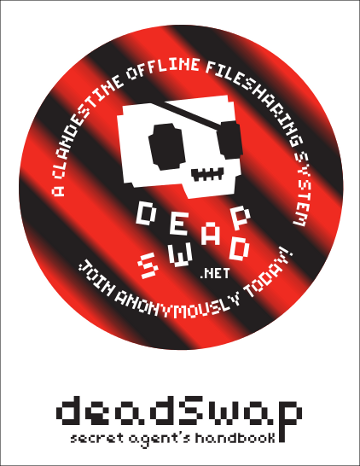
DK: I have no idea if people are using it, I am currently not running a network.
Like thimbl, deadSwap is an artwork. Unlike thimbl, which has the seeds of a viable platform within it, deadSwap is pure parody.
It was developed for the 2009 Sousveillance Conference, The Art of Inverse Surveillance, at Aarhus University. deadSwap is a distopian urban game where participants play secret agents sharing information on usb memory sticks by hiding them in secret locations or otherwise covertly exchanging them, communicating through an anonymizing SMS gateway. It is a parody of the “hacker elite” reaction to Internet enclosure, the promotion of the idea that new covert technologies will defeat attempts to censor the Internet, and we can simply outsmart and outmaneuver those who own and control our communications systems with clandestine technologies. This approach often rejects any class analysis out-of-hand, firmly believing in the power of us hackers to overcome state and corporate repressions. Though very simple in principal, deadSwap is actually very hard to use, as the handbook says “The success of the network depends on the competence and diligence of the participants” and “Becoming a super-spy isn’t easy.”
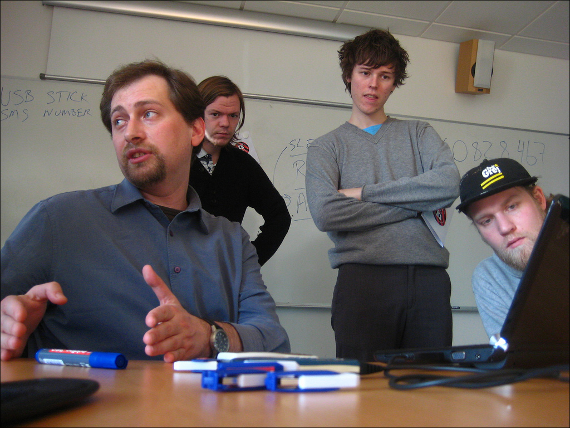
MG: What other services/platforms/projects does the Telekommunisten collective offer the explorative and imaginative, social hacker to join and collaborate with?
DK: We provide hosting services which are used by individuals and small organizations, especially by artists, http://trick.ca, electronic newsletter hosting (http://www.freshsent.info) and a long distance calling service (http://www.dialstation.com). We can often be found on IRC in#telnik in freenode. Thimbl will probably be a major focus for us, and anybody that wants to join the project is more than welcome, we have a community board to co-ordinate this which can be found here: http://www.thimbl.net/community.html
For those that want to follow my personal updates but don’t want don’t use any social media, most of my updates also go here: http://dmytri.info
Thank you for a fascintaing conversation Dmytri,
Thank you Marc 🙂
=============================<snip>
Top Quote: THE::CYBER.COM/MUNIST::MANIFESTO by Richard Barbrook. http://www.imaginaryfutures.net/2007/04/18/by-richard-barbrook/
The Foundation for P2P Alternatives proposes to be a meeting place for those who can broadly agree with the following propositions, which are also argued in the essay or book in progress, P2P and Human Evolution. http://blog.p2pfoundation.net
In the essay ‘Imagine there is no copyright and no cultural conglomerates too…” by Joost Smiers and Marieke van Schijndel, they say “Once a work has appeared or been played, then we should have the right to change it, in other words to respond, to remix, and not only so many years after the event that the copyright has expired. The democratic debate, including on the cutting edge of artistic forms of expression, should take place here and now and not once it has lost it relevance.”
Issue no. 4 Joost Smiers & Marieke van Schijndel, Imagine there are is no copyright and no cultural conglomorates too… Better for artists, diversity and the economy / an essay. colophon: Authors: Joost Smiers and Marieke van Schijndel, Translation from Dutch: Rosalind Buck, Design: Katja van Stiphout. Printer: ‘Print on Demand’. Publisher: Institute of Network Cultures, Amsterdam 2009. ISBN: 978-90-78146-09-4.
http://networkcultures.org/wpmu/theoryondemand/titles/no04-imagine-there-are-is-no-copyright-and-no-cultural-conglomorates-too/
“Festival of Ideas For A New City” organized by the New Museum, The Architectural League, The Bowery Poetry Club, C-Lab, Columbia University Center for Architecture, Cooper Union, The Drawing Center, NYU Wagner, PARC Foundation, Storefront for Art and Architecture, and the Swiss Institute blossomed like spring in New York City from May 4 – 8th, setting out to “harness the power of the creative community to imagine the future city and explore the ideas destined to shape it.”
Keynotes addressing the issues were architect Rem Koolhaas, virtual reality inventor Jaron Lanier, and former President of the National University of Columbia, and former Mayor of Bogota, Antanas Mockus. A StreetFest set up along the Bowery with over 100 local grassroots organizations and small businesses “presenting model practices and products in a unique environment.” Over 100 projects, events, performances and walking tours expanded on the Festival’s themes.
Rem Koolhaas with OMA and The New Museum showcased CRONOCAOS, an exhibit examining the growing “empire” of preservation and destruction and the consequences of how we build, rebuild and remember. What is the role of preservation on the art world? As larger and larger spaces are repurposed for art from industrial spaces they focus on the “apocalyptic sublime,” mimicking Hollywood and B movies. Oddly enough Koolhaas noted, this increase in preservation closely parallels the rise of Wall Street and tourism.

There were panels on “The Heterogeneous City,” “The Networked City,” “The Reconfigured City,” and “The Sustainable City.” At night curator Anna Muessig’s Flash:Light Nuit Blanche event included murals along the Bowery, art projections on Nolita and Lower East Side buildings, and music and performances including projects on the facade of the New Museum and St. Patrick’s Old Cathedral in Little Italy. There was also a 3D video installation Civilization reinterpreting Dante’s Diving comedy.
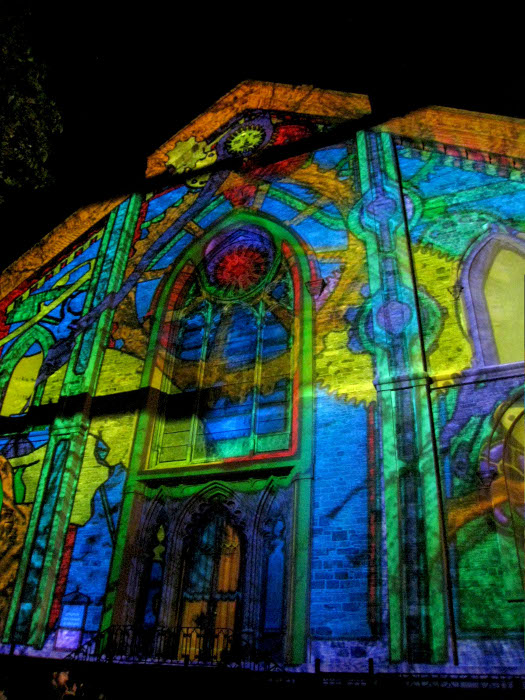

Jaron Lanier’s Keynote address on “The Networked City” at the Great Hall at Cooper Union reiterated many of the themes in his new book, “You Are Not A Gadget.” Not one to follow any set path, Lanier began his talk by playing a Laoitian “Ban Lao” (Ban Bang Sai Kai) bamboo wood pipe. He declared the simple reed flute was one of the first holders of digital information, even older than the abacus, because each reed object and note is turned on and off just like a series of digital 0’s and 1’s. The Ban Lao, traded across the Silk Route was noticed by the Greeks and Romans, and influenced the development of the pipe organ. The pipe organ was automated and turned into a player piano, a programmable loom, and finally became the origins of Charles Babbage’s computer.
Computers have gotten better Lanier explained, processing more and more bits, but humans still have more precise acuity at the level of quantum physics. They can respond to just one photon. He then veered off topic discussing the first computer scientist Alan Turing who used computers to crack codes during World War II. Persecuted for being gay, he was injected by authorities with female hormones which gave him breasts and made him suicidal. Just like Snow White, he killed himself by eating a poisoned apple.
He then veered back on track saying using computers as metaphors to the human condition is an irrelevant, outdated metaphor. The brain is not a CPU, and eyes and ears are not USBs. A better metaphor is thinking of the head as a spy submarine performing spy missions. You are constantly moving your head seeking out data, not passively seeing it. Your visual system is sensitive to minute differences. A musical instrument is an additional instrument to the sensory motor loop that makes perception possible. Can we build digital tools that are as sensitive as we are? This, he noted, was one of the key questions now facing computer scientists.
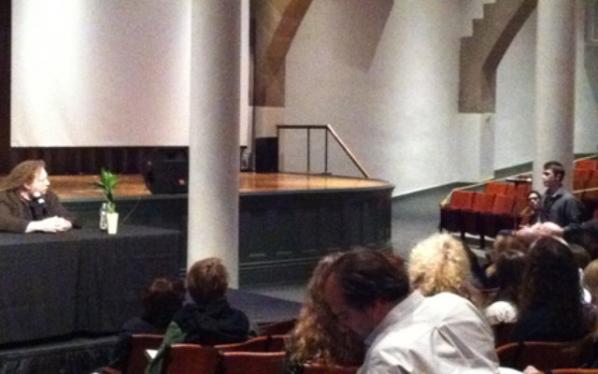
New technologies are usually developed to become weapons. But many important inventions were first developed for music. Musical bows existed before arrows, and guns developed from the casting of metal bells. Even Hewlett Packard’s first object was a musical synthesizer. Music is a driver with innovation taking place around making sounds.
In order to make his lecture relevant to the “Networked City” theme of the festival, Lanier discussed his favourite thing about New York City, that the same sense of acuity as applied to musical instruments also applies to personal interactions. More diversity means you have more chance of connecting with someone who will change your life. The fates of people in New York are guided by their activities. Its important that the fates concern an extra world of human to human contact.
In such a huge network context people are sensitive to subtle motions in each other, and can identify subconscious communication we don’t really know about. Contrast that to sound networking, where digital music does not give you the subtle minute accuracy of acoustic sound. People who only communicate virtually are spinning their wheels in place. When we connect to each other through digital representations we lose some form of expression.
Lanier proselytized for the necessity of the “head and the heart”, insisted technology needs to bring better jobs to society than the ones they are destroying. The basic social contract he said was turned back 11 years ago when advertising became the new way to get information. Sergey Brin, the co-founder of Google was the one who started it. Because digital technology is cheaper, cheaper just gives this stuff away for advertising. But, when you take the products of people’s hearts and minds, such as their music and literature, and give them away for free this becomes a problem. When you put effort into a promotion on line you get the illusion of benefits, but you actually lose relative advantage. This is because the true customers of a social networking site like Facebook is not you, you are actually the product of Facebook. You are sold and the customer pays to influence events. This is the difference between overt and covert information with Lanier stating, “The official business of computation is advertising.” At some point though, there is nothing to advertise. If cars can drive themselves, what happens to truck drivers? Or if 3D machines make fabrications they make manufacturing obsolete.
The Japanese are creating elder care robots. We are making ourselves unemployed. The fashion of making everything free leads us down a path from a city of dreams to a cry of despair. We have to figure out a way to change our relationship to information technology, instead of chasing after users and followers and making more money. Ending his lecture he declared, “We must humanize digital architecture – We must see beyond fads.” And then he played a little ditty on dual Gypsy flutes.
TO BOOK YOUR PLACE NOW please email ale[at]furtherfield[dot]org
Over the last decade the awareness of anthropogenic climate change has emerged in parallel with global digital communication networks. In the context of environmental and economic collapse people around the world are seeking alternative visions of prosperity and sustainable ways of living.
While the legacy of the carbon fuelled Industrial Revolution plays itself out, we find ourselves grappling with questions about the future implications of fast-evolving global digital infrastructure. By their very nature the new tools, networks and behaviours of productivity, exchange and cooperation between humans and machines grow and develop at an accelerated rate.
The ideas for this transdisciplinary panel have grown out of Furtherfield’s Media Art Ecologies programme and will explore the impact of digital culture on climate change, developing themes adopted in grass-roots, emerging and established practices in art, design and science. The discussion will inform a second event in September at ISEA 2011 where we will be joined by artists Tom Corby and Helen Varley Jamieson.
Chair: John Hartley
Speakers: –
Michel Bauwens – On how Peer to Peer thought and technology point towards alternative production methods and a sustainable future.
Catherine Bottrill – On working with producers and consumers to consider the environmental long-tail of digital culture.
Ruth Catlow – On ecological approaches to tools, networks and behaviours in a digital art community.
Who this is for: any interested members of the public, cross-disciplinary (science, art, technology) practitioners, academics, students, researchers with an interest in digital culture, technology, sustainability.
Where: CREAM (Centre for Research in Education Art and Media), University of Westminster
Building: 309 Regent Street Campus
Room: RS 152 Cayley Room
Date/ Time: Friday May 13, 2011 from 6:00pm to 8:00pm
Maximum Seats: 60
Catherine Bottrill – Associate Director, Research Julie’s Bicycle
Catherine’s PhD research at the University of Surrey is studying the response of the UK Music Industry to climate change. The research is examining the efforts of the industry to organise itself to collectively take action to reduce greenhouse gas emissions. The study is exploring the possible opportunities, limitations and contradictions for the industry to support a cultural shift towards sustainable energy lifestyles. The research investigates the perspectives of music businesses, artists and audience.
Michel Bauwens – Founder of The Foundation for Peer 2 Peer Alternatives
Michel works in collaboration with a global group of researchers in the exploration of peer production, governance, and property. He has been an analyst for the United States Information Agency, knowledge manager for British Petroleum (where he created one of the first virtual information centers), eBusiness Strategy Manager for Belgacom, as well as an internet entrepreneur in his home country of Belgium.
Ruth Catlow – Co-founder and Co-director of Furtherfield
Ruth is an artist, curator and educator. As co-founder and co-director of Furtherfield.org a grass roots media arts organisation and its gallery (formerly HTTP) in North London, she works at the intersection of art, technology and social change with artists, curators, musicians, programmers, writers, activists and thinkers from around the world. She is currently developing the artistic programme and organisational infrastructure with a focus on Media Art Ecologies, aspiring to engender shared visions and infrastructures for other possible worlds. Ruth is Course manager for digital art and design degrees at Writtle School of Design, where she is currently developing a new BA and MA in Fine Art and Environment.
John Hartley – Art and Ecology Strategist
In his recent role as Arts Council England’s Arts and Ecology Strategy Officer, John supported the development of practice and infrastructure in the face of changing contexts. Also on the Arts Council’s Arts and Ecology partnership with RSA, on the GLA steering group for Greening London’s Theatres and the DCMS Climate Change Project. John led on developing ACE’s self-assessment toolkit to help arts organizations implement effective energy management programs. Implementation of the program can reduce energy usage and carbon emissions, potentially reducing energy costs by up to 20%. He is now a free-lance consultant, also a practicing artist, directs a collaborative experimental music group and has co-written a book published by Transworld.
Re-rooting digital culture is part of Furtherfield’s Media Art Ecologies Programme. This unconference event is partnered by CREAM (Centre for Research in Education Art and Media)
The four day event at the Showroom collated a series of practitioners, artists, theorists and historians, to examine, test and explore ideas stemming from cybernetics and information theory and more specifically the idea of feedback.
Described as an ‘experimental cross-disciplinary research project’, Signal : Noise was a fusion of talks, lectures, performances, screenings and debates that made diverse contemporary evaluations of the legacy of cybernetics using an inter-disciplinary approach. It tackled subjects as seemingly diverse as economic theory; urbanism and the arrival of the motor car in London; game theory; linguistics; media-performance art from the 1970’s; and the problematic legacies of the recent UK arts funding system on artists – all viewed using the concepts and terminologies of cybernetics and systems.
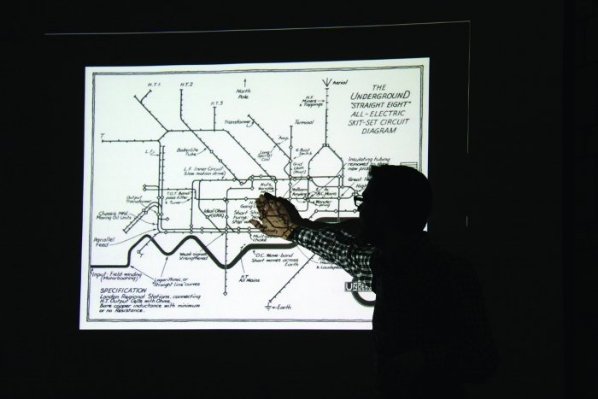
Signal : Noise, in part, played out like a small conference, mainly set in The Showroom Gallery space with one wall covered with a network diagram drawing by Stephen Willats, and fly posted theoretical systems diagrams from his recently re-published 1973 book, or maybe manual, ‘The Artist as Instigator of Changes in Social Cognition and Behaviour’.
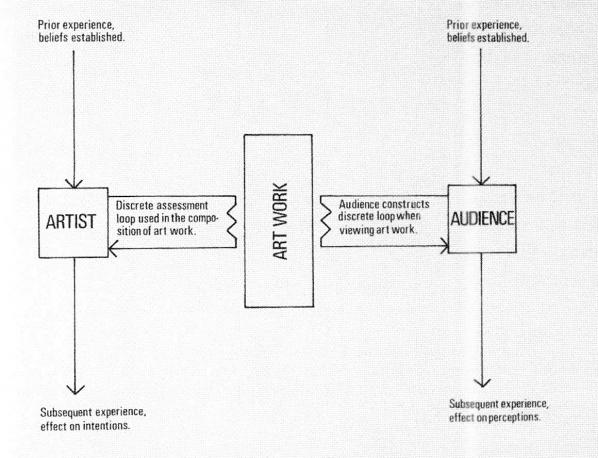
This visual reference served as a backdrop to the proceedings and served as an on going reminder that despite the deep theoretical and historical base being presented and discussed in its many forms, Signal : Noise was ultimately attempting to re ignite debates, and help reset the ideas of cybernetics and systems into a contemporary context of practical application. Willats’ book describes his process as an ‘investigation by the artist into the processes, procedures and models’ of the ‘Art Environment’ using ‘cybernetics as a research tool’.
The first night introductory presentations by Charlie Gere and Steve Rushton provided an overview of many ideas explored throughout the weekend. Artist and writer Steve Rushton on ‘How Media Masters Reality’ used an array of examples, from conceptual and media architecture group Ant Farm using pioneering ideas of investigating media feedback, through to the 500 millions votes (!) on US TV programme American Idol; the latter an example of how contemporary applications of media feedback loops are now often conceptually embedded into the core of television productions, and in turn, are now part of the audiences expectations and involvement.
Ant Farm’s 1975 work ‘The Eternal Frame’, screened later during the weekend, along with Gary Hill’s Why Do Things Always Get in a Muddle (Come on Petunia), based on Gregory Bateson’s Metalogues.
Ant Farm’s 1975 work ‘The Eternal Frame’, screened later during the weekend, was their carefully staged, somewhat trashy live ‘re enactment’ of the 8mm film footage of the Kennedy assassination, complete with a drag version of Jackie Kennedy and sunglass wearing suited security. This film sequence is familiar today, but in 1975 it had yet to reach the public domain. Working to a tightly choreographed moment derived from a bootleg of the 29 seconds of 8mm film, Ant Farm’s grotesque mimicry of the assassination was performed as an ongoing loop, complete with car driving around the block (interestingly, the random people watching in the street in 1975 took photographs like they were at a theme park).
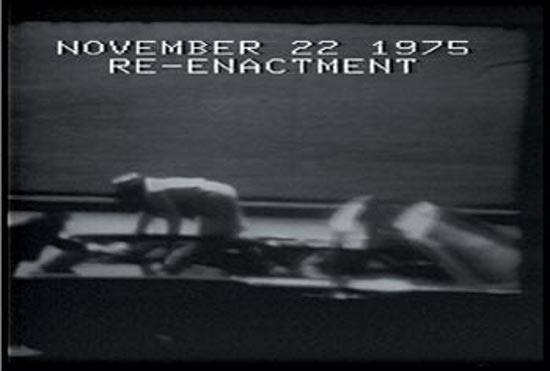

Despite being conceived in the mid ‘70s media environment of portable video and cassettes, the documentation of Ant Farm’s performance resonated with something surprisingly familiar and contemporary in our era of the internet, social media and rolling 24 hour news, and what Rushton termed our “society of self performance”.
Rushton’s historical threads from the origins of Cybernetics and to the Whole Earth Catalogue and the WELL served as a excellent base for the oncoming proceedings of the weekend, and showed that the arrival of the contemporary mass information network in the form of the internet, has habituated it’s millions of users into a kind of cybernetic practice based on input, observation, control, intervention, response, feedback, and adaptation but without necessarily using or being aware of its lexicon.
Nearby, in the Cockpit Theatre, was ‘Closed Circuit’ a performative work by Rod Dickinson (along with Rushton), which consisted of two actors staged and dressed, in a precise duplication of a set for political announcements; wooden lecterns, curtained background, complete with an array of flags – but all carefully neutralized by the removal of logos and national flags identities into plain white.
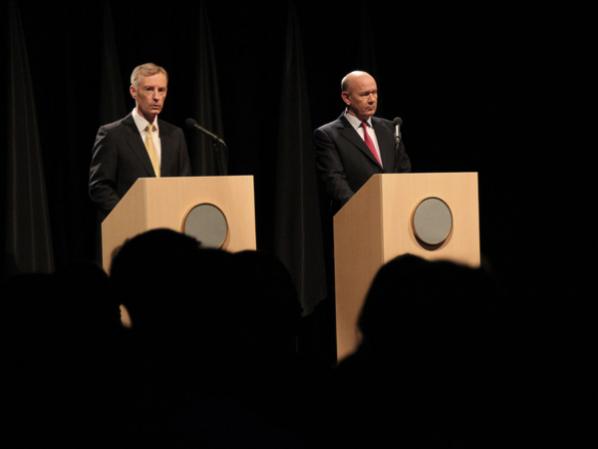
What followed was a series of political speeches utilizing the familiar language and tone of grandeur and crisis, delivered by the actors in the style of a world leader address. What they delivered, was a carefully sequenced remixed script derived from political speeches over the past 50 years; Margaret Thatcher; Richard Nixon; Ronald Reagan; Tony Blair; Yasser Arafat and others. All the details from each specific event they were referring to had been carefully edited out. The only way to differentiate one world leader, country or event from another, were the large projected auto cues for the actors, situated behind the audience at the rear of the theatre. Each one gave the full scrolling speech text and also the year and original context for each leaders’ delivery. Looking towards the stage, it sounded like a single coherent speech, but eluding any specific meaning, isolating the language of threat and authoritarian political control, leaving us just the husk of political presentation and the transparency of the format itself.
Ideas explored in Stephen Willats’ network drawing were expanded further during his talk in the final morning session of Signal : Noise, where he gave a refreshing clarion call to abandon ‘last century thinking’ during his prescient and timely discussion. His seminal works have persistently and methodically challenged the process, structure and meaning of art making and display. Willats made his earliest system diagrams in the late 1950’s, and was the first artist to make the artwork itself a map of communication. But maybe it is this century, rather than our last, that will connect with his provocations to the hierarchical, highly codified, object obsessed ‘Art Environment’, as he terms it, to see that ‘object based thinking is still a hangover from last century attitudes’.
Willats was an early reference for emerging net art and media art in the mid 90’s, with artists then clutching for any art historical roots that gave the field of networked and computer based practice some practical grounding.
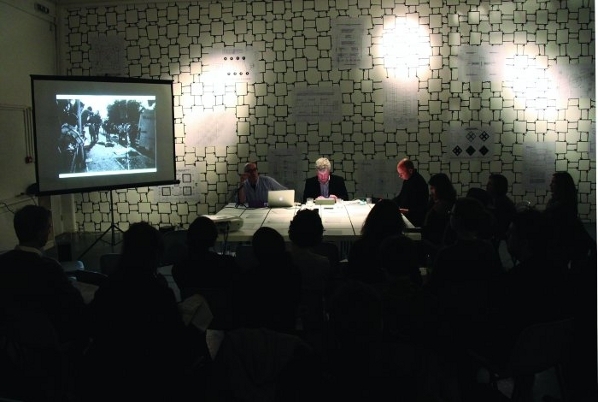
This in-conversation with Emily Pethick surveyed his own personal development and immersion in Cybernetics in its differing stages, a short history lesson, moving from Norbert Weiner to Gregory Bateson and Gordon Pask, but always resolutely en route to the practical issues in the present and what Willats defines as the artist as an ‘instigator of transformation’.
In parallel to Willats, was a presentation and discussion hosted by Emma Smith and Sophie Hope which began to interrogate the legacy of a the New Labour arts commissioning process. It discussed how the criteria for successful funding was intrinsically linked to a social agenda, audience and location set by government policy. Discussions followed about how the arts commissioning process may turn out to have skewed a generation of artists practice, as they slowly lost control of their own output, became tagged with being an ‘artist facilitator’, and began conceiving works to fit in with the criteria of funding bodies, with each funder slowly extending their own prospective reaches. All this supported by an immense drive to build ‘Cultural Industries’ into mechanisms for regeneration.
Seeing this placed against Willats, whose ongoing practice could initially seem in tune with the past decades cultural policies and its overtly prescribed socially engaged agenda, in fact served to show how contrasting, distinct and rich his rigourous thoughtful approach is by comparison.
All this made for a timely discussion. With the approaching withdrawal and decimation of arts funding in the UK, Signal : Noise could prove to be a prescient event. With presentations, workshops and panels by Stuart Bailey and David Reinfurt of Dexter Sinister, Charlie Gere, Matthew Fuller, Marina Vishmidt and others, the interdisciplinary approach of Signal : Noise worked well despite its fairly dense timetable.
Using the gallery as a discursive space, with theorists and writers set within context of practice, is a good base for the next event in this on going series. What it maybe didn’t allow for, which is easily rectified, is a more unpredictable agenda, and more intervention by the ‘audience’. The whole event could function more as a real feedback working system, an adaptable structure that potentially allows for input from its participants (both presenters and audience) letting things move in unexpected directions both on line and offline, leaving a physicalised network as a residue after the event. With the decision to include food and beer in the ticket price (great dumplings, fresh vegetables and miso soup), there is potential here to expand this type of event even further.
With the on coming cultural landscape in the UK moving into un-chartered territory, it is potentially events like Signal : Noise which might begin to unearth and test new ideas and ignite debate within a less rigid format than a ‘curated’ show. In the future this type of event may even re-claim the word ‘radicalise’ from its current narrow, negative media usage, and re-purpose it for artists who decide to reject art market values, in favour of a exploring new ways of working within the emerging (and significantly less funded) ‘Art Environment’.
Signal : Noise. The project was led by Steve Rushton, Dexter Sinister (David Reinfurt and Stuart Bailey), Marina Vishmidt, Rod Dickinson and Emily Pethick. http://www.theshowroom.org/research.html?id=161&mi=254
The Artist as an Instigator of Changes in Social Cognition and Behaviour. 1973. Stephen Willats. http://www.occasionalpapers.org/?page_id=825
Closed Circuit, Rod Dickinson in collaboration with Steve Rushton.
http://www.roddickinson.net/pages/closedcircuit/project-synopsis.php
Dr Charlie Gere. Reader in New Media Research. Department: Lancaster Institute for the Contemporary Arts. http://www.lancs.ac.uk/fass/faculty/profiles/charlie-gere
ANT FARM. ART/ARCHTECTURE/MEDIA [1968-1978]. http://artsites.ucsc.edu/faculty/lord/AntFarm.html
The Eternal Frame by T.R. Uthco and Ant Farm: Doug Hall, Chip Lord, Doug Michels, Jody Procter. 1975, 23:50 min, b&w and color, sound. http://arttorrents.blogspot.com/2008/02/ant-farm-eternal-frame-1976.html
Emma Smith. Social practice that is both research and production based and responds to site-specific issues. http://www.emma-smith.com/www.emma-smith.com/Homeindex.ext.html
Sophie Hope’s work inspects the uncertain relationships between art and society. http://www.welcomebb.org.uk/aboutSophie.html
Michel Bauwens is one of the foremost thinkers on the peer-to-peer phenomenon. Belgian-born and currently resident in Chiang-Mai, Thailand, he is founder of the Foundation for P2P Alternatives.
It’s a commonplace now that the peer-to-peer movement opens up new ways of creating relating to others. But you’ve explored the implications of P2P in depth, in particular its social and political dimensions. If I understand right, for you the phenomenon represents a new condition of capitalism, and I’m interested in how that new condition impacts on the development of culture – in art and also architecture and urban form.
As a bit of a background, I’d like to look at what you’ve identified as the simultaneous “immanence” and “transcendence” of P2P: it’s interdependent with capital, but also opposed to it through the basic notion of the Commons. Could you elaborate on this?
With immanence, I mean that peer production is currently co-existing within capitalism and is used and beneficial to capital. Contemporary capitalism could not exist without the input of free social cooperation, and creates a surplus of value that capital can monetize and use in its accumulation processes. This is very similar to coloni, early serfdom, being used by the slave-based Roman Empire and elite, and capitalism used by feudal forces to strengthen their own system.
BUT, equally important is that peer production also has within itself elements that are anti-, non- and post-capitalist. Peer production is based on the abundance logic of digital reproduction, and what is abundant lies outside the market mechanism. It is based on free contributions that lie outside of the labour-capital relationship. It creates a commons that is outside commodification and is based on sharing practices that contradict the neoliberal and neoclassical view of human anthropology. Peer production creates use value directly, which can only be partially monetized in its periphery, contradicting the basic mechanism of capitalism, which is production for exchange value.
So, just as serfdom and capitalism before it, it is a new hyperproductive modality of value creation that has the potential of breaking through the limits of capitalism, and can be the seed form of a new civilisational order.
In fact, it is my thesis that it is precisely because it is necessary for the survival of capitalism, that this new modality will be strengthened, giving it the opportunity to move from emergence to parity level, and eventually lead to a phase transition. So, the Commons can be part of a capitalist world order, but it can also be the core of a new political economy, to which market processes are subsumed.
And how do you see this condition – the relationship to capital – coming to a head?
I have a certain idea about the timing of the potential transition. Today, we are clearly at the point of emergence, but also coinciding with a systemic crisis of capitalism and the end of a Kondratieff wave.
There are two possible scenarios in my mind. The first is that capital successfully integrates the main innovations of peer production on its own terms, and makes it the basis of a new wave of growth, say of a green capitalist wave. This would require a successful transition away from neoliberalism, the existence of a strong social movement which can push a new social contract, and an enlightened leadership which can reconfigure capitalism on this new basis. This is what I call the high road. However, given the serious ecological and resource crises, this can at the most last 2-3 decades. At this stage, we will have both a new crisis of capitalism, but also a much stronger social structure oriented around peer production, which will have reached what I call parity level, and can hence be the basis of a potential phase transition.
The other scenario is that the systemic crisis points such as peak oil, resource depletion and climate change are simply too overwhelming, and we get stagnation and regression of the global system. In this scenario, peer-to-peer becomes the method of choice of sustainable local communities and regions, and we have a very long period of transition, akin to the transition at the end of the Roman Empire until the consolidation of feudalism during the first European revolution of 975. This is what I call the low road to peer to peer, because it is much more painful and combines both progress towards p2p modalities but also an accelerating collapse of existing social logics.
That’s a less optimistic scenario… what form of conflict would this involve?
The leading conflict is no longer just between capital and labour over the social surplus, but also between the relatively autonomous peer producing communities and the capital-driven entrepreneurial coalitions that monetize the commons. This has a micro-dimension, but also a macro-dimension in the political struggles between the state, the private sector and civil society.
I see different steps of political maturation of this new sphere of peer power. First, attempts to create networks of sympathetic politicians and policy-makers; then, new types of social and political movements that take up the Commons as their central political issue, and aim for reforms that favour the autonomy of civil society; finally, a transformation of the state towards what I call a Partner State which coincides with a fundamental re-orientation of the political economy and civilization. You will notice that this pretty much coincides with the presumed phases of emergence, parity and phase transition.
Most likely, acute conflict may arise around resource depletion and the protection of these resources through commons-related mechanisms. Survival issues will dictate the fight for the protection of existing commons and the creation of new ones.
You often cite Marx, who of course also wrote at a time of conflict and social change provoked by technological and economic development. Does this tension you’re describing fit in his notion of contradictory forces conflicting – thesis, antithesis, synthesis – in other words, is this a historical materialist process?
I don’t quite use the same language, because I use Marx along with many other sources. I never use Marx exclusively or ideologically, but as part of a panoply of thinkers that can enlighten our understanding. My method is not dialectical but integrative, i.e. I strive to integrate both individual-collective aspects and objective-subjective aspects, and to avoid any reductionist and deterministic interpretations. Though I grant much importance to technological affordances, I do not adhere to technological determinism, and I don’t find that I pay much attention to historical materialism, since I see a feedback loop between culture, human intentionality, and the material basis. Technology has to be imagined before it can be invented.
My optimism is grounded in the hyperproductivity of the new modes of value creation, and on the hope that social movements will emerge to defend and expand them. If that fails to happen, then the current unsustainable infinite growth system will wreak great havoc on the biosphere and humanity.
As you say classical or Marxist economics don’t really suffice to describe the current situation. Is one aspect of this problem that the classical distinction between use and exchange doesn’t fit with a situation in which many of the “uses” are ludic, and have an exchange system built into them? I’m thinking of on-line gaming specifically. But it has always been difficult to place art in this simple use/exchange polarity. Do you see any revisions to that polarity today?
I’m not sure the ludic aspect is crucial, as use value is agnostic to the specific kind of use, just as peer production is agnostic as to the motivation of the contributors. However, our exponential ability to create use value without intervention of the commodity form, with only a linear expansion of the monetization of peer platforms, does create a double crisis of value. On the one hand, capital is valuing the surplus of social value through financial mechanisms, and is not restituting that value to labour, just as proprietary platforms do not pay their value producers; on the other hand, peer producers are producing more and more that can’t be monetized. So we have financial crisis on the one hand, a crisis of accumulation and a crisis of precarity on the other side. This means that the current form of financial capitalism, because of the broken feedback loop between value creation and realization, is no longer an appropriate format.
Regarding your ‘integrative method’, this is a much more sophisticated take on economics that places it in relationship to other, cultural, dimensions of human life. And the imagination is central to it. Given that, do you see any special role for art in this transition?
Art is a precursor of the new form of capitalism, which you could say is based on the generalization of the ‘art form of production’. Artists have always been precarious, and have largely fallen outside of commodification, relying on other forms of funding, but peer production is a very similar form of creation that is now escaping art and becoming the general modality of value creation.
My take is that commodified art has become too narcissistic and self-referential and divorced from social life. I see a new form of participatory art emerging, in which artists engage with communities and their concerns, and explore issues with their added aesthetic concerns. Artists are ideal trans-disciplinary practitioners, who are, just as peer producers, largely concerned with their ‘object’, rather than predisposed to disciplinary limits. As more and more of us have to become ‘generally creative’, artists also have a crucial role as possible mentors in this process. I was recently invited to attend the Article Biennale in Stavanger, Norway, as well as the artist-led herbologies-foraging network in Finland and the Baltics, and this participatory emergence was very much in evidence, it was heartening to see.
We might see as opposed to that sort of grassroots participatory engagement, the entities you refer to as the “netarchies.” Their power lies in the ownership of the platform they exploit for harvesting user-originating information and activities. How hegemonic is this ownership? At what point does it become impossible to create a “counter-Google”?
The hegemony is relative, and is stronger in the sharing economy, where individuals do not connect through collectives and have weak links to each other. The hegemony is much weaker in the true commons-oriented modalities of production, where communities have access to their own collaborative platforms and for-benefit associations maintaining them.
The key terrain of conflict is around the relative autonomy of the community and commons vis a vis for-profit companies. I am in favour of a preferential choice towards entrepreneurial formats which integrate the value system of the commons, rather than profit-maximisation. I’m very inspired by what David de Ugarte calls phyles, i.e. the creation of businesses by the community, in order to make the commons and their attachment to it viable and sustainable over the long run. So, I hope to see a move from the current flock of community-oriented businesses, towards business-enhanced communities. We need corporate entities that are sustainable from the inside out, not just by external regulation from the state, but from their own internal statutes and linkages to commons-oriented value systems.
Counter-googles are always possible, as platforms are always co-dependent on the user communities. If they violate the social contract in a too extreme way, users can either choose different platforms, or find a commons-oriented group that develops an independent alternative, which in turn maintains the pressure on the corporate platforms. I expect Google to be smart enough to avoid this scenario though.
As you’ve said elsewhere, many of these issues are about a new form of governance. Do you see any of this as particularly urban in character — I mean, about organization at the smaller scale, regionally focused, as opposed to at the level of the nation state. Does propinquity matter at all to this — the importance of living together? This seems to relate to a — not a contradiction or tension exactly, but a complication of the P2P notion — that relationships are dispersed, yet a number of the parallels you draw with historical models (for example the Commons) connect with social situations in which people lived very close together. A fairly strong notion in urbanistic thinking is that propinquity is a good thing. In the past that was part of many artistic relationships also: cities as milieux of artistic production/creativity, artists’ colonies; working cheek by jowl with other creative people and breathing the same air. Is this notion in any sense undermined by dispersed networks?
I think we are seeing the endgame of neoliberal material globalization based on cheap energy, and hence a necessary relocalization of production, but at the same time, we have new possibilities for online affinity-based socialization which is coupled with resulting physical interactions and community building. We have a number of trends which weaken the older forms of socialization. The imagined community of the nation-state is weakening both because of the globalized market; the new possibilities for relocalization that the internet offers, which includes a new lease of life to mostly reactionary and more primary ethnic, regional and religious identities; but also because of this important third factor, i.e. socialization through transnational affinity based networks.
What I see are more local value-creation communities, but who are globally linked. And out of that, may come new forms of business organization, which are substantially more community-oriented. I see no contradiction between global open design collaboration, and local production, both will occur simultaneously, so the relocalized reterritorialisation will be accompanied by global tribes organized in ‘phyles.’ I think the various commons based on shared knowledge, code and design, will be part of these new global knowledge networks, but closely linked to relocalized implementations.
One interesting question is what forms of urbanism come out of p2p thinking. The movement is in the process of thinking this through, in fact a definition of p2p urbanism was just published by the “Peer-to-peer Urbanism Task Force” (http://p2pfoundation.net/Peer-to-Peer_Urbanism).
This promotes, in general terms, bottom-up rather than centrally planned cities; small-scale development that involves local inhabitants and crafts; and a merging of technology with practical experience. All resonant in various ways with p2p approaches. But this statement also provokes a few questions: It calls for an urbanism based on science and function; in fact it explicitly promotes a biological paradigm for design. At the risk of over-categorizing, isn’t this a modernist understanding of design — or if not, how is it different? This document also refers to specific schools of urban design: Christopher Alexander, and also New Urbanism. On the side of socio-economics though, New Urbanism has been criticized (for example in David Harvey’s Spaces of Hope); some see it as nostalgic and in the end directed at a narrow segment of the population. Christopher Alexander’s work on urban form has also been criticized as, being based on consensus, restrictive in its own ways. In fact, might not p2p principals call for creation of spaces that allow dissent and even shearing-off from the mainstream? Might there be a contradiction built into trying to accommodate the desires for consensus and for freedom? Contradiction can be a source of vitality, certainly in art; but it can raise some tensions when you get to built form and a shared public realm.
I cannot speak for the bio- or p2p urbanism movement, which is itself a pluralistic movement, but here’s what I know about this ‘friendly’ movement. I would call p2p urbanism not a modernist but a transmodernist movement. It is a critique of both modernist and postmodern approaches in architecture and urbanism; takes critical stock of the relative successes and failings of the New Urbanist school; and then takes a trans-historical approach, i.e. it critically re-integrates the premodern, which it no longer blankly rejects as modernists would do. I don’t think that makes it a nostalgic movement, but rather it simply recognizes that thousands of years of human culture do have something to teach us, and that even as we ‘progressed’, we also lost valuable knowledge. Finally, I think there is a natural affinity between the prematerial and post-material forms of civilization. The accusation of elitism is I think also unwarranted, given what I know of the work of bio-urbanists amongst slumdwelling communities. However, I take your critique of consensus very seriously, without knowing how they answer that. You are right, that is a big danger to guard for, and one needs to strive for a correct balance between agreed-upon frameworks, that are community and consensus-driven, and the need for individual creativity and dissent. Nevertheless, compared to the modernist prescriptions of functional urbanism, I don’t think that danger should be exaggerated.
Following on this track, I’d like to pose another question that relates to living together. The P2P concept depends on the difficulty of controlling the activity of peers on a network: i.e. it’s impossible to lock down the internet. Doesn’t this degree of freedom also eliminate those social controls that might be considered “healthy” – for example, controls over criminal activity. David Harvey (to bring him in again), in his paper “Social Justice, Postmodernism and the City”, lists social controls among several elements of postmodern social justice. When the grand narratives have been replaced by small narratives, there remains a need to limit some freedoms. How does p2p thinking deal with this?
I think we can summarize the evolution of social control in three great historical movements. In premodern times, people lived mostly in holistic local communities, where everyone could see one another, and social control was very strong. At the same time, vis a vis more far-away institutions, such as for example the monarchy, or the feudal lord, or say in more impersonal communities such as large cities, compliance was often a function of fear of punishment. With modernity, we have a loss of the social control through the local community, but a heightened sense of self through guilt, combined with the fine-grained social control obtained through mass institutions, described for example by Michel Foucault. The civility obtained through the socialization of the imagined community that was the nation state, and the educational and media at its disposal, also contributed to social control and training for civil behaviour.
My feeling about peer-to-peer networks is that they bring a new form of very real socialization through value affinity, and hence, a new form of denser social control in those specific online communities which also usually have face-to-face socialities associated with them. But this depends on whether the community has a real value affinity and a common project, in which case I think social control is ‘high’, because of the contributory meritocracy that determines social standing. On the contrary, in the looser form of sharing communities, say YouTube comments for example, we get the type of social behaviour that comes from anonymity and not really being seen.
So the key challenge is to create real communities and real socialization. Peer to peer infrastructures are often holoptical, i.e. there is a rather complete record of behaviour and contributions over time, and hence, a record of one’s personality and behaviour. This gives a bonus to ‘good ethical behaviour’ and attaches a higher price to ‘evil’. On the other hand, in the looser communities, subject to more indiscriminate swarming dynamics, negative social behaviour is more likely to occur.
A key difference between contemporary commons and those of the past is that the new ones are immaterial and global. The model for P2P exchange seems to be of autonomous agents relating and forming new communities not based on membership in an originary cultural group. Given a global distribution, how do local, cultural factors play into the model of globalized distributed networks? How does P2P accommodate cultural specificity, especially specificity with deep historical roots; and how does that accommodate the development of new culture, art?
In my view, the digital commons reconfigure both the local and the global. I think we can see at least three levels, i.e. a local level, where local commons are created to sustain local communities, see for example the flowering of neighbourhood sharing systems; then there are global discourse communities, but they are constrained by language; so rather than national divisions, which still exist but erode somewhat as a limitation for discourse exchange, there is a new para-global level around shared language. At each level though, cultural difference has to be negotiated and taking into account. If there is no specific effort at diversity and inclusion, then affinity-based communities reproduce existing hierarchies. For example, the free software world is still dominated by white males. Without specific efforts to make a dominant culture, which has exclusionary effects, adaptive to inclusion, deeper participation is effectively discouraged. Of course, as the dominant culture may not be sufficiently sensitive, it is still incumbent on minoritarian cultures to make their voice and annoyances heard. Obviously, each culture will have to go through an effort to make their culture ‘available’ through the networks, but I think the specific role of artists, now operating more collectively and collaboratively than before, is to experiment with new aesthetic languages, so that non-conceptual truths can be communicated.
The innovation I see as most important though is in terms of the globa-local, i.e. a relocalization of production, but within the context of global open design and knowledge communities, probably based on language. I also see a distinct possibility for a new form of global organization, i.e. the phyle I mentioned earlier, as fictionalized in Neal Stephenson’s The Diamond Age and operationalized by lasindias.net. These are transnational value communities that created enterprises to sustain their livelihoods.
I see the key challenge, not just to develop ‘relationality’ between individuals, as social networks are doing very well, but to develop new types of community, such as the phyle, which are not just loose networks, but answer the key question of sustainability and solidarity.
In terms of culture, what I see developing is a new transnational culture, based on value and discourse communities, based on language, that are neither local, nor national, nor fully cosmopolitan, but ‘trans-national’.
And the creative relationships between artists can in some sense be a model for this?
Artists have been precarious in almost all periods of history, and their social condition reflects what is now very common for ‘free culture’ producers today, so studying sustainability and livelihood practices of artist communities seems to me to be a very interesting lead in terms of linking with previous historical experience. I understand that artists now have increasingly collaborative practices and forms of awareness. Unfortunately, my own knowledge of this is quite limited so this is really also an open appeal for qualified researchers to link art historical forms of livelihood, with current peer production. In some ways, we are all now becoming precarious artists under neoliberal cognitive capitalism!
In 2002, when Monochrom was invited to act as the representative of Austria at the Sao Paulo Biennial, instead of going as yourselves, you sent Georg Paul Thomann, one of the country’s most prominent avant guard artists, and also a complete fabrication.
Yes, we were asked to represent the Republic of Austria at the Sao Paulo Art Biennial, Sao Paulo (Brazil) in 2002. However, the political climate in Austria (at that time, the center-right People’s Party had recently formed a coalition with Jorg Haider’s radical-right Austrian Freedom Party) gave us concerns about acting as wholehearted representatives of our bloody nation. We dealt with the conundrum by creating the persona of Georg P. Thomann, an irascible, controversial (and completely fictitious) artist of longstanding fame and renown. Through the implementation of this ironic mechanism – even the catalogue included the biography of the non-existent artist – we tried to solve with pure fiction the philosophical and bureaucratic dilemma attached to the system of representation.
It gave me something of a hearty guffaw to hear about how you and your fellows, manning the Austria country booth as the artist’s technical support staff – the lowliest of low in the art world hierarchy – went about revealing the fictitious nature of the artist.
Yes, we turned the tables. When members of the administration, journalists, or curators asked about the whereabouts of Thomann, our irritated answer was that he hadn’t cared to show up so far, and that he hadn’t helped with anything, because he was supposedly watching porn in his hotel room all day, while we – the members of his technical crew – didn’t care about that bullshit at all. But we informed other technical support teams about the basic idea of the project. They were also given detailed information about Thomann’s non-existence but we did not give them any hierarchic directives about what to do with their knowledge but left it up to them if they wanted to reveal the fake or keep spinning the story. Most people enjoyed doing the latter and they also kept telling different versions of the heard information until finally a bubbling geyser kept erupting in various ways and constantly led to new outbreaks of tittle-tattle.
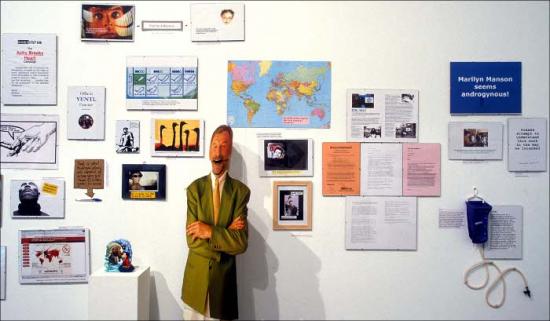
What happened next, as I heard you describe it, was that “bubbles and bubbles of rumors” began to form around the expansive floor of the biennial. I found this moment in the arc of the project to be particularly interesting and was hoping you could perhaps share some of your thoughts and recollections.
Let’s give you a brief summary of the background. The basic principles of an art-super-structure like a Biennial is simple: lots of little white boxes in which art was set up – and little artists, spreading business cards like prayers. There is a nice German term: “die Warenformigkeit des Kunstlers” (“the commodity value of the artist”). We hardly had any contact with other artists… and that was bad. They came from more than 80 different countries, but they were hiding in their white boxes. Everyone was busy building his or her own little world. Then, during the final setup phase we found out about an incident, which took place in our neighborhood through a copied note.
One year before the Biennial, Chien-Chi Chang had been invited to be the official representative of Taiwan at the Biennial. But then, three days before the opening, his caption – adhesive letters – had been removed from his cube virtually over night. ‘Taiwan’ was replaced with ‘Museum of Fine Arts Taipeh.’ But to Chien-Chi Chang the status as an official representative of Taiwan was very important, because his photography artwork dealt directly with the inhumane psychiatric system in Taiwan.

Chien-Chi was trying to get in contact with the Biennial administration and the chief curator (the German Alfons Hug), but didn’t succeed. Communication was refused. After that he decided to write an open letter, but the creative inhabitants of all the little white art-combs didn’t seem too interested in the artist’s chagrin, who by now wanted to leave the Biennial out of protest.
We were interested in the situation and did some research. We found out that the Chinese delegation had threatened to withdraw their contribution and to cause massive diplomatic problems. To them, Taiwan was clearly not an independent country (c/f ‘One China Policy’) and they put pressure on the Biennial management to get that message out. The management did not make this international scandal public and it was quite obvious why.
monochrom decided to show solidarity with Chien-Chi. We wanted to set an example and show that artists do not necessarily have to internalize the fragmentation and isolation that is being imposed upon them by the structure of the art market, the exhibition business, as well as the economy containing them. For us, though, this is not about taking a stand for either the westernized-economical imperialism represented by Taiwan or for China’s old-school Stalinist imperialism. This is about integrity and solidarity, values that we chose to express through a collaborative act. Together with other artists from various countries we launched a solidarity campaign: we took off some adhesive letters of each collaborating country’s signature and donated them to Chien-Chi Chang. monochrom sponsored the ‘t’ of Austria, while the Canadians donated one of their three as. The other participating artists were from Croatia, Singapore, Puerto Rico and Panama. A lot of artists and curators from other countries refused to support the campaign for fear of – as they would call it – “negative consequences.” WTF? But at least some of the artists were pulled out of their self-referential and insular national representation cubes which, in themselves, so rigorously symbolized the artists’ work and his or her persona as commodities.

After some time we managed to attach a trashy, yet legible ‘Taiwan’ to the outside wall of Chien-Chi Chan’s cube. Numerous journalists took notice of the campaign and Chien-Chi opened his exhibition in front of a cheering audience. Some days later, we found out that Chinese and Taiwanese newspapers massively covered the campaign. One Taiwanese paper used the headline “Austrian artist Georg Paul Thomann saves ‘Taiwan’.” In other words, a non-existing artist saved a country pressed into non-visibility. Who said that postmodernism can’t be radical?
What was it like – even from a kind of phenomenological sense – to be in the midst of this bubbling, to experience the formation of a scandal from its very embryonic moments? Is there something in the interiority of situations like this that you see as essential to the creation of new kinds of solidarity?
First we would have to define what “new kinds of solidarity” mean. What would be the ‘new’ part of it? Does it go beyond old and traditional forms of solidarity? And why should it? I think that classic forms of solidarity were carried out by political groups or other collective entities. They tried to express their (let’s label it as) “old-school solidarity” by pointing their collective fingers at someone who they thought were mistreated: “Look, look this human being is being oppressed!” And they always did it “in the name of something”. Old-school solidarity was one more frickin’ medium that people used to get a message across. Thus it was always part of the realm of representation. Your act of solidarity represents the one you show solidarity with, but your act is also advertisement for yourself, your cause and the (political) identity you wish to construct. Politics is always drama. Best example for this would be the “supporters of Palestine”. There are tons of ethnic groups on this rusty little planet who have to suffer under worse conditions. But nobody seems to be interested in showing solidarity with them. Where are Henning Mankell and Noam Chomsky when you really need them? Involved in some stupid fast-food anti-imperialism. We have to understand that the “object of solidarity” is something you pick for a reason… and most of the time it’s to feel good as a group and to impress your peers. But that has nothing to do with factual, non-reductionist political analysis. Collective entities define themselves through acts of representation and this representation is comparable to the construction of national pride or patriarchal family structures and values. Solidarity can be read as an act of defining identities. And that can be very dangerous, because old school solidarity always wants to be “right”. You are always “the good one” supporting the poor bastards. Smash dichotomies!
What we experienced at the Biennial of Sao Paulo back in the spring of 2002 was a very non-collective act. We were no real group, no leaflets, we had no common agenda, we were a psycho-geographic swarm. There was no basis for acting or speaking as a collective and there was no need to bundle our powers or form an identity. Yes, we tried to recruit other artists to join in our little act of solidarity. But it was no protest, we didn’t protest a certain political agenda because we didn’t want to end up in the old black and white world that, for example, all the apeshit Pro-Tibet supporters live in. Bah! Their ugly flags! Their patriarchal projections! Richard Gere! Yuck! So it was a kind of “free flowing solidarity”, not to be abused to form a political movement or statement. The only form of identity that was formed was the simple idea that even bourgeois artists can decide whether they want to be part of the Biennial and its stupid rules or whether they want to be part of action and fun.
To make it short: we are interested in micro-political solidarity, temporary solidarity that can’t fossilize. Solidarity is important if it can evolve and vanish within a short span of time and all that’s left is rumors and vague commemorations. Let’s call it a process of counteracting – that might be well-known in the field of the urban guerrilla but that so rarely pops up at art shows.
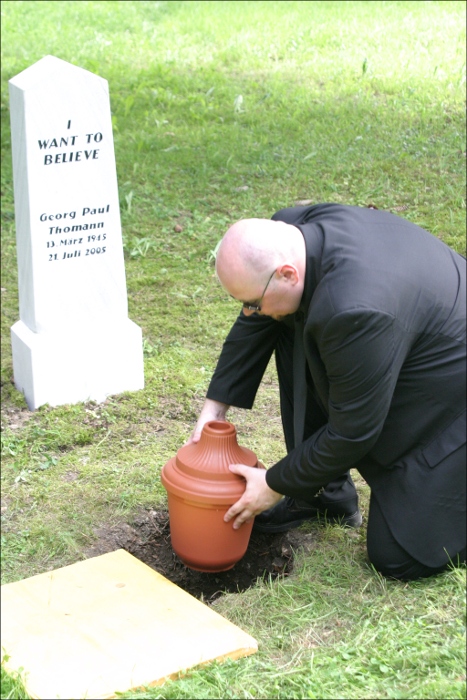
Read Part 1 of the Interview
http://www.furtherfield.org/interviews/interview-johannes-grenzfurthner-monochrom-part-1
Read Part 3 of the Interview
http://www.furtherfield.org/features/interviews/interview-johannes-grenzfurthner-monochrom-part-3
Above image taken by Scott Beale, Laughing Squid.
Marc Da Costa interviews the ever dynamic Johannes Grenzfurthner, founder of monochrom. This is the first of three interviews, where he talks about the project ‘Soviet Unterzoegersdorf’; the fake history of the “last existing appanage republic of the USSR”. Created to discuss topics such as the theoretical problems of historiography, the concept of the “socialist utopia” and the political struggles of postwar Europe. In March 2009 Monochrom presented ‘Soviet Unterzoegersdorf: Sector II’. The game features special guest appearances of Cory Doctorow, Bruce Sterling, Jello Biafra, Jason Scott, Bre Pettis and MC Frontalot.
Since 1993, the Monochrom members have devoted themselves to the grey zones where systems intersect: the art (market), politics, economics, pop, gaiety, vanity, good clean fanaticism, crisis, language, culture, self-content, identity, utopia, mania and despair. The technique underlying Monochrom’s work is that of being and working in the fields of Pop/avant-garde, theory/reflection, interventionism/politics, gaiety/lust/tragedy, (self-)configuration/mystification. The project Monochrom pushes into and beyond these fields is, ‘networking’ events, people, possibilities, material, impetus and identities.” (Zdenka Badovinac, Moderna Galerija Ljubljana)
Grenzfurthner has collaborated with groups such as ubermorgen, Billboard Liberation Front, Esel and Mego (label). Grenzfurthner writes for various online/print magazines and radio stations (e.g. ORF, Telepolis, Boing Boing). Grenzfurthner has served on a number of art juries (e.g. Steirischer Herbst, Graz). He holds a professorship for art theory and art practice at the University of Applied Sciences, Graz, Austria and is a lecturer at University of Arts and Industrial Design in Linz, Austria.
Recurring topics in Johannes Grenzfurthner’s artistic and textual work are: contemporary art, activism, performance, humour, philosophy, sex, communism, postmodernism, media theory, cultural studies, popular culture studies, science fiction, and the debate about copyright.
The ‘Soviet Unterzoegersdorf’, a game created by monochrom, is described as being at once the “last existing appendage republic of the USSR” and located inside the Republic of Austria. Could you speak a bit about the project and its background?
From a conceptual background we have to state that we have been occupied with the construction, analysis and reflection of alternative worlds for quite a long time. A lot of our projects are treating this field partly as a discussion with concepts deriving from popular culture, science and philosophy, and partly as a direct reference to science fiction and fantasy fan culture. We first created the fake history of the “last existing appendage republic of the USSR” in 2001 — ten years after the ‘mighty Soviet Union’ went into this nation-state-splitting-up-process and new countries emerged like Firefox pop-ups that you can’t manage to click away.
We wanted to discuss topics such as the problems of historiography, the concept of “utopia” and “socialist utopia” and the political struggles of postwar Europe in a playful, grotesque way. You have to bear in mind that the real village of Unterzoegersdorf was part of the Post WWII Soviet zone from 1945 until the foundation of the ‘neutral’ Republic of Austria in 1955. Reactionary Austrians talk about 1955 as the ‘real liberation’… and I have to mention that that’s rather typical: cheering when Hitler arrives and being proud members of the Third Reich, afterwards proclaiming that Austria was the first victim of Nazi Germany and complaining about the allied occupation forces — especially the Soviet.
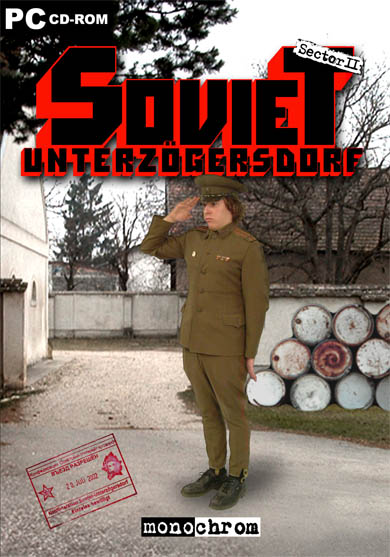
We transformed the theoretical concept into an improvisational theatre/performance/live action role-playing game that lasted two days. That means we really organized bus tours to Unterzoegersdorf — a small village that really exists — and acted the setting; beginning with the harsh EU Schengen border control. Later, in 2004, we started to think about a possible sequel to the performance. We thought that the cultural format of the “adventure game” provided the perfect media platform to communicate and improve the idea.
We started to work in February 2004 and presented ‘Sector 1’ — the first part of the trilogy — in the form of an exhibition in Graz/Austria in August 2005. We released ‘Sector 2’ in 2009, featuring guest stars as Cory Doctorow, Jello Biafra or Bruce Sterling. As the game series uses a 3rd person perspective with photo backgrounds and pictures of real actors as sprites, it took us quite a while to digitize and image process all of the material. This technique was actually first used by Sierra On-Line during the early and mid-1990s — but we are quite proud that we managed to get the feeling of discovering an old computer game that never existed on your old 500 MB hard drive. One aspect of the game is playing with memories and the future of the past. The future is a kind of carrot, the sort tied just in front of the cartoon donkey’s nose so it goes to work, goes off to war, learns Javascript and knows which bits to laugh at in Woody Allen’s Sleeper. You can imagine.
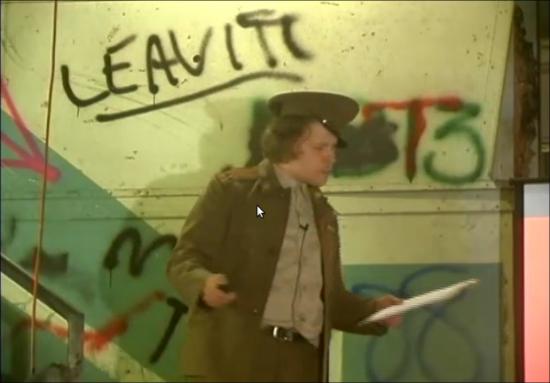
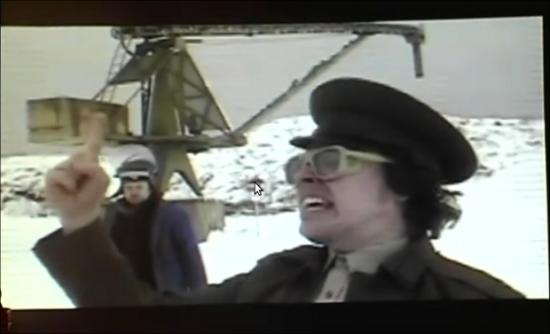
At a HOPE conference a few years back I was interested to hear you talk about the framing of the project as somehow deeply connected with a certain understanding of historiography that you and the other members of monochrom share. Could you elaborate on this a bit?
Debates triggered by postmodern culture have directed our attention towards questions of representation and the relevance of “history” and stories — i.e. The challenging proclamation of a post-histoire, the realization of the impossibility of a meta-narrative of history; the clash between reality and sign systems, the difference between fact and fiction, the impossibility of neutral contemplation or witnessing as well as the positioning of subjective awareness within such representations, etc. All these forms of representation have been playing a central part in the development of national, ethnic and tribal identities since WWII. And (as a by-product of military technology) computer game development is hardly aware of these discourses.
We wanted to combine (retro)gaming and (retro)politics and (crypto)humor to delve into this ongoing discourse. We wanted to harvest the wonderful aesthetic and historic qualities of adventure gaming. It is a commemoration and resurrection, and one more reminder that contemporary gaming (in its radical business-driven state-of-the-artness) should not dare to forget the (un)dead media of the past — or they will haunt them.
If you compare the status of the adventure game in the context of the economic growth of the computer game industry you could state that it is gone. Less than 1% of all computer games written are adventure games. Adventure games are nearly extinct… but only nearly. If media and media applications make it past their Golden Vaporware stage, they usually expand like giant fungi and then shrink back to some protective niche. They just all jostle around seeking a more perfect app.
For many people in the Soviet Unterzoegersdorf team, adventure games are part of their media socialization. For the computer industry it is one of the most successful gaming formats of the past. And for the feminist movement it is proof that a woman — I’m talking about Sierra On-Line’s Roberta Williams — was able to shape the form of a whole industry totally dominated by men.
Computer games are embedded in the cultural framework of technological developments. In the study of technological development and creativity, focusing attention on the failure, the error, the breakdown, the malfunction means opening the black box of technology. Studies have convincingly demonstrated that the widespread inability to understand technological artifacts as fabricated entities, as social and cultural phenomena, derives from the fact that in retrospect only those technologies that prove functional for a culture and can be integrated into everyday life are “left over.” However, the perception of what is functional, successful and useful is itself the product of social and cultural–and last but not least–political and economic processes. Selection processes and abandoned products and product forms are usually not discussed. According to Langdon Winner, there is a sense in which all technical activity contains an inherent tendency toward forgetfulness. Quote: “Is it not the point of all invention, technique, apparatus, and organization to have something and have it over with? (…) Technology, then allows us to ignore our own works. It is license to forget.”
Could you also perhaps talk about the choice of selecting the genre of an adventure game as the incarnation of this downtrodden republic. At the risk of being literal minded, is there any sense in which the existence of ‘Soviet Unterzoegersdorf’ as a kind of place that comes alive through players’ interactions with a program downloaded from the internet has anything to say to how you imagine being able to engage/critique/disrupt the idea of the nation-state?
We are postmodern leftists. A little bit melancholic… but you can count on us. We love to play with layers of consciousness and layers of layers of consciousness. On first view our project could be interpreted as a mock-up of the Soviet Union and the communist state structures that really existed. But, why on Earth do we need so many references to 1980s and 1990s metal music? Or Marvin Minsky? Or Negri? Or Austrian post-WWII history? Or geek adumbrations? Mocking the Soviet State would be much easier. In fact it’s about the wonderful clash between reality and sign systems, the impossibility of neutral contemplation or witnessing as well as the positioning of subjective awareness within such representations. The traditional humanists tend to see the whole philosophic aesthetic postmodern line of thought — from Judith Butler to Lyotard and Derrida — from the wrong angle. Okay, you can’t explain Sun Ra to a Green Day fan now, when he’s laying in the corner, piss-drunk and crooning “Anarchy”. But we think that the (radical) nature of postmodernism is often simply not grasped because people just copy it down into the conservative pattern of thinking which has been indoctrinated into us since the Enlightenment. Of course, on the other hand, it functions as a virus, and there’s nothing wrong with that.
Contemporary art — the field we are usually working in because there’s money — is mostly concerned with systems or systematic concepts. In the context of their work, artists adapt models of individual art-specific or economic or political systems like in a laboratory, to reveal the true nature of these systems by deconstructing them. So would it be fair to say that by their chameleon-like adaptation they are attempting to generate a similar system? Well… the corporate change in the art market has aged somewhat in the meantime and looks almost as old as the ‘New Economy’. Now even the last snotty brat has realized that all the hogwash about the creative industries, sponsoring, fund-raising, the whole load of bullshit about the beautiful new art enterprises, was not much more than the awful veneer on the stupid, crass fanfare of neo-liberal liberation teleology. What is the truth behind the shifting spheres of activity between computer graphics, web design and the rest of all those frequency-orientated nerd pursuits? A lonely business with other lonely people at their terminals. And in the meantime the other part of the corporate identity has incidentally wasted whole countries like Argentina or Iceland. That’s the real truth of the matter.
Read Part 2 of this Interview
http://www.furtherfield.org/features/interviews/interview-johannes-grenzfurthner-monochrom-part-2
Read Part 3 of this Interview
http://www.furtherfield.org/features/interviews/interview-johannes-grenzfurthner-monochrom-part-3
HTTP Gallery is pleased to host LAB4 by Hedva Eltanani, an exploration of communication between two places using streaming media and web applications. It is another step in a series of LABs that explore digital technology and audience interaction. It is part of Heltanani’s research on digital performance and the way it affects audience experience.
LAB4 is a game that challenges the audience to bend the boundaries of space, interaction and intimacy. The two locations, HTTP Gallery in London and The Poly Centre in Falmouth, are linked via live-feed technology, using webcams and web applications. Eltanani will lead a series of activities, such as ‘truth or dare’, which challenges elements of group dynamics and technology – the aim is to engage the two audiences and help participants bond within each group.
How intimate will it go? The participants are invited to deepen the connection by keeping their community active using web applications.
BE PART OF THE EVENT IN LONDON
Doors open at 8:30pm
More info and documentation :
http://arthubfalmouth.blogspot.com/
http://vs4rslab.wordpress.com/
Featured image: People watching and being watched across virtual space
Helen Varley Jamieson’s account of working collaboratively in Madrid at the Eclectic Tech Carnival. On a ‘sprint’, with five women coming together for a week to rebuild the group’s website, physically & remotely.
In the last week of June I went to Madrid for the Eclectic Tech Carnival (/ETC) website workweek – the collective effort of five women coming together for a week to rebuild the group’s website. This is sprint methodology, a concept that I first met in Agile software development, but one that is being increasingly applied as a successful creative collaboration methodology. During the workweek I blogged about the process and this article is an assemblage of the blog posts.
Thinking about the concept of the sprint, I realised that over the years, I’ve participated in a number of theatrical “sprints” although we didn’t call them that. In fact it could be argued that the normal development process for theatre productions in New Zealand is the sprint – a three or four week turnaround of devising/rehearsing/presenting. Except that it doesn’t usually continue the Agile process after the first sprint – evaluation, refinement then the next sprint and iteration – and as a result, the work is often undercooked. But theatre projects that better fit the sprint analogy are some of the workshop-performance processes that I’ve participated in at theatre festivals, where a small group comes together for a few days to create a performance, then some time later meets again in another situation, perhaps a slightly different configuration of people, for another sprint. Each sprint generates a stand-alone performance or work-in-process showing, as well as contributes to a larger evolving body of work that forms the whole collaborative project. Two such projects that I’ve been part of are Water[war]s and Women With Big Eyes (with the Magdalena Project).

Recently I participated remotely in a Floss Manuals sprint, developing a manual for CiviCRM (which is something that I use with the Magdalena Aoteroa site). In this sprint, a group of about 15 people met somewhere in the USA to create a manual for CiviCRM. A few more of us were online, doing things like copy-editing the content. Most of the time there were people active in the IRC channel, chatting about the project and other things going on around them, so I got a sense of their environment, time zone and the camaraderie generated by the intense process.
Sprinting seems like a very logical and effective way to work in many situations: in software development, where each sprint focuses on specific feature development, and allows for a lot of flexibility and adaptation as the project progresses; in theatre, where limited resources make it a practical way to work, and the time pressure forces us to be resourceful and imaginative and also with networks, such as the Eclectic Tech Carnival, whose organisers don’t get to meet physically very often. It also makes sense in the context of our hectic lives, to block out a week or a few days when we agree to put everything else on hold and commit to intense, focused work instead of trying to juggle and multitask, with deadlines pushing out and out.
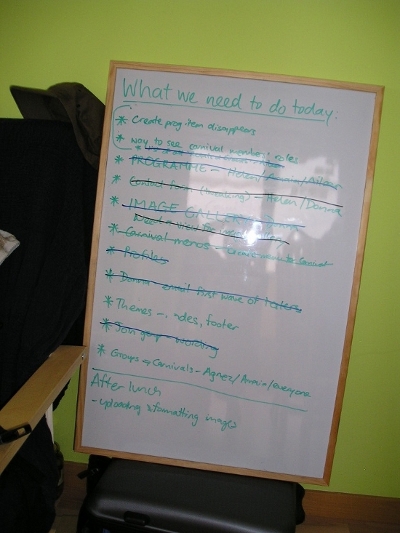
By halfway through the second day of the workweek, the wiki we used to plan and manage the project was filling up with tech specs, user requirements, design ideas, etc. We were getting encouraging emails from others in the network, and chatting to each other across the table and in the IRC. After lunch we did the new Drupal install and things seemed to be moving forward quickly in an organised and collaborative way.
Wednesday afternoon and the heat was oppressive; I put a little rack under my laptop because she was so hot, and my hands were too sweaty to use the trackpad. It wasn’t just Madrid’s weather that was making me sweat – we’d all been working hard on the new site since our late start in the morning (following on from a late night …). Agnes was busy developing the theme for the site, Aileen was working on profiles and user roles while Donna and Amaia were trying to configure mailing list integration and I was using the command line to drush download modules – much easier and quicker than the process of downloading, unpacking, ftp-ing and installing! And very exciting for me to use the command line, which I generally only get to do when hanging out with the /ETC crowd.

We were in that murky middle phase of the process: we’d done a lot of groundwork in terms of defining users, content types, general structure and the functionality required, but everything was still very bitsy and amorphous. But the installation of the test site had happened very easily yesterday, using drush, so that meant we now had something tangible to work with.
Working with Drupal can be pretty frustrating; it seems that every step of the way, another module is required to do what we want – then that module requires other modules, and then every little thing has to be finely configured to work just right with every other piece of the puzzle. From my previous experience with the Magdalena Aotearoa site, I knew we are doing a lot better this time in terms of defining what we need first, but some things we just can’t define until we know what’s possible, which we don’t really know for sure until we actually try it. We *think* we’re going to be able to do everything we want, but getting there isn’t simple. Also, the naming of different components and modules is sometimes ambiguous or confusing – the documentation ranges from really clear and detailed to non-existent. And some things just didn’t seem intuitive to me.
But, with five brains and our different complementary experiences and skills, I was still confident that we would have a new site by the end of Friday; maybe not a completely finished one, but a web site is never finished, is it?
On Friday morning the heat broke with a thunder storm and cooling welcome rain, but it didn’t last long. For some reason I woke up at 7.30am, ridiculously early as we hadn’t gone to bed until 2am. But I was wide awake so I enjoyed a couple of hours of quiet before everyone else awoke, drinking coffee and answering emails. The day before, Agnez and I had got up early to do yoga on the terrace, but the intense rain prevented that on Friday.
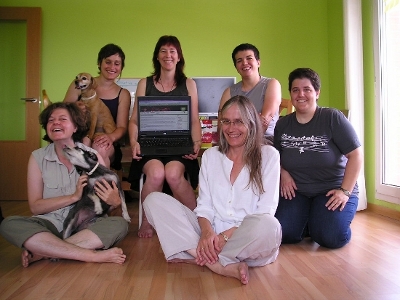
The test site was up and some of the others not present in Madrid were looking at it and trying things out. We’d solved a lot of problems but there were still a number of things not working. I had learned heaps about Drupal in the previous four days, particularly about organic groups, roles, permissions, and views. Altogether it is potentially incredibly flexible and powerful, however it takes time to work out how things need to be done and sometimes it is a confusing and circular process. Changing a setting in one place can stop something in a completely different place from working. However the combination of skills and experience between the five of us meant that usually one of us had at least an idea about how to do things and a couple of times we drew on external expertise via IRC or email.
On the last day, Agnez worked on finishing the theme while Aileen and I tried to work out why our groups are no longer displaying in the og_my view, and how to make the roles of group members visible. Donna had found that mailhandler and listhandler didn’t seem to be a practical way to integrate our mailman lists with Drupal after all – for the time being we’ll stick to the old system – and Amaia had been working on a way to create a programme for each event. The idea is that each /ETC event can be created as an organic group with the organisers having control over content and members within that group, but not being able to edit the rest of the site content. By Friday, we had this working pretty much how we wanted it.
We had planned a barbecue to celebrate the end of the workweek, but the rain prevented that. Instead, we ate inside then took turns to suffer humiliation and defeat with Wii Fitness (Amaia had clearly been practising!). In fact it wasn’t really the end of the sprint – rain again on Saturday morning meant that we decided to keep working longer and only went into the city in the afternoon, for a wander around and then the Gay Pride parade. On Sunday as we began to scatter back to our different parts of the globe, the site was still not live, as we were waiting for more feedback from testers and the finishing of the design themes. However, the site is essentially functional and should be live very soon.
The sprint process enabled us to achieve a considerable amount in a short space of time, sharing our knowledge and developing our skills. We also had great conversations over meals, explored Madrid and Colmenar Viejo, learned how to make Spanish tortilla, attempted a bit of Spanish, went swimming and did yoga. I even fitted in a performance on the first night, with Agnez, and dinner with friends another night. It’s amazing what you can do when you put the rest of your life on hold for a week; the only downside is the catching up afterwards.
Alejo Duque, Kathrin Guenter, Graham Harwood, Martin Howse, Petr Kazil, Jonathan Kemp, Martin Kuentz, Tom McCarthy, Christian Nold, Nick Papadimitriou (tbc), John Rogers (tbc), Karen Russo, Gordan Savicic, Suzanne Treister, Danja Vasiliev, Ryan Jordan
In episode five of the popular Israeli sitcom, Arab Labor, Amjad and his family are invited for Passover to the home of a reform family whose son goes to kindergarten with Amjad’s daughter. Amjad is enthusiastic about the Seder ceremony and decides to adopt the concept of the Haggadah into Eid al-Adha (The Festival of Sacrifice). In this way Amjad attempts to balance his life as an Israeli Arab by using some food, a bit of ceremony, and a lot of comedy!
Eating together is a central theme in many religions, going back to ancient Greece. The basic diet in Greece consisted mostly of grains. Meat was only eaten collectively after sacrifices to the gods, which anyone who can get through the first book of the Iliad without drooling will tell you.
It is hard not to bond with people when you eat together. Sometimes the act of eating together can be a tool of influence: business lunches, awards dinners, naked brunches, etc. Even a breakfast might be an opportunity to bond, as Thomas Macauly once said: “Dinner parties are mere formalities; but you invite a man to breakfast because you want to see him.” But can take-away meals be a way to disseminate culture and spread knowledge?
A new take-out restaurant that only serves cuisine from countries that the United States is in conflict with has open in Pittsburgh, PA. It is called Conflict Kitchen. This eatery is similar in concept to Michael Rakowitz’s 2004 project called Enemy Kitchen. The purpose of Enemy Kitchen was to use food to “open up a new route through which Iraq can be discussed. In this case, through that most familiar of cultural staples: nourishment.”
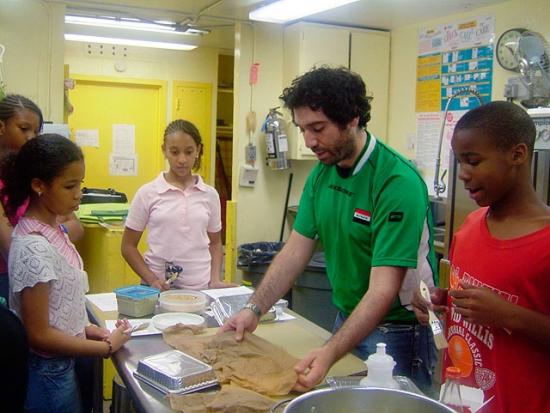
Enemy Kitchen, an ongoing project where Rakowitz collaborates with his Iraqi-Jewish mother. Compiling Baghdadi recipes, teaching the dishes to different public audiences. The project functioned as a social sculpture: while cooking and eating, the students engaged each other on the topic of the war and drew parallels with their own lives, at times making comparisons with bullies in relation to how they perceive the conflict.
Conflict Kitchen is a more commoditized version of Rakowitz’s project, using Iranian cuisine as a vehicle to market “rogue” state culture. Conflict Kitchen will have rotating menus, the next being Afganistan and then North Korea. In an interview with We Make Money Not Art, the creators of the project said that most Pittsburghers don’t know what the restaurant is all about, despite its having made international headlines. Besides creating a more commercially marketable Iran, the food counter brings people from all walks of life together to discuss everything from politics to religion while they wait for their food to be prepared. The creators use this opportunity to chat with the customers and “the conversation naturally goes to Iranian culture–perceptions and misperceptions–and often back to the customer’s own cultural heritage.”
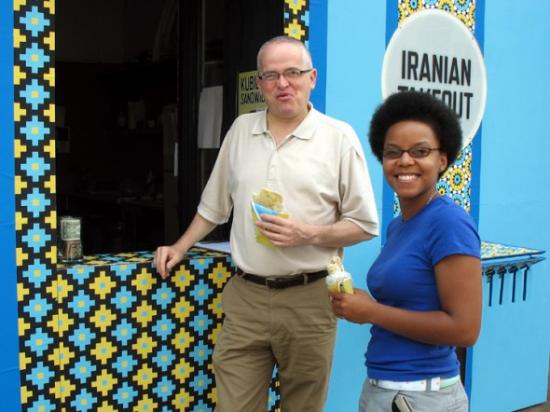
I like the idea of promoting cultural awareness through cuisine, I guess it is the next best thing to having a study abroad experience. Maybe now people can go out, eat and get informed first hand instead of being force fed fear-mongering news by the American media. The main US propaganda machine, Disney, has a long history of using food to influence public opinion. 0ne of their most successful brain-washing campaigns, known as The Magic Kingdom, convinced millions of children and their families that all Mexicans shoot Churros from their fingertips on command, that all Germans walk around in lederhosen serving bratwurst all the live-long day, and that all Chinese children wear rice-picking hats and ride around on one-speed bikes and selling chop-sticks. What sort of chance does Conflict Kitchen stand against such Pavlovian methods of coercian? None whatsvever, but at least you get to eat somewhere that is officially more famous than the Carnegie Deli.
.re_potemkin is a crowdsourced re-make of the film “Battleship Potemkin”. It is a “.f.reeP_” project by .-_-., part of a series of projects that embrace the ideology and means of production of contemporary media and technoculture in order to make art.
From December 2006 to January 2007 .-_-. worked with 15 groups of students from Yildiz Technical University to reproduce Battleship Potemkin on a shot-by-shot basis. Not all shots were reproduced, there are empty black sections in the new film. The students and the setting of the university and its surrounds are very different from the locations and actors of Battleship Potemkin. The domesticity, institutional backdrops and modern street furniture would be very different from the 1920s Soviet backdrops of the original even if they weren’t in colour.
Soviet film-maker Sergei Eisenstein’s “Battleship Potemkin” (1925) is a classic of early 20th century cinema, a piece of obvious propaganda that both fulfils and transcends its instrumental purpose with its exceptional aesthetics. Its most famous images have become cultural icons and cliches. If you haven’t seen it then ironically enough it’s on YouTube so you can watch it there and go “oh, that’s where that came from…” before we continue. Or you can watch it in the side-by-side comparison with .re_potmkin on the project’s homepage.
The Soviet dream became (or always was) a nightmare, an ideology that sacrificed many millions of lives in order to maintain its fictions. Our contemporary liberal democratic society regards itself as unquestionably morally superior to communism for this and many other reasons. The (self-)defining difference between Soviet communism and liberal free-market capitalism is economic ideology. Free markets benefit individuals by reducing inefficiencies.

As free market capitalism has triumphed its means of production have evolved. Corporations emerged as a leading way of organizing labour, leading to utopian social projects in the West in the same era as Eisenstein was working in the East and later to a burgeoning middle class in the post-war era. But since then corporations have become increasingly unapologetic exploitative economic projects.
In order to cut costs and become more economically efficient, corporations can become virtual. They shed jobs to reduce payroll and other costs associated with actually employing people. They then source cheaper labour and production from outside, paying other companies to make the branded goods that the corporation sells. This is known as outsourcing.
A logical next step in corporate cost reduction is to source labour from individuals without paying for it at all. This is known as crowdsourcing. Although individuals who donate their labour to a corporation through crowdsourcing might not be compensated monetarily, they can still be compensated in other ways.
With crowdsourced intangible goods the best way of rewarding people who donate their labour to produce those goods is simply to give the resulting product to them under a licence that allows them to use it freely. Non-profit projects such as GNU and Wikipedia do this very successfully, but corporations are always tempted to try and privilege their “ownership” of other people’s work. Where crowdsourced labour is exploited without fair compensation this called sharecropping.

.re_potemkin is a non-profit project rather than a corporation, and as such it has adopted a GNU or Wikipedia-style copyleft licence. Or at least it claims to have. In a creative solution to the fact that there is more than one copyleft licence suitable for cultural works, .re_potemkin’s licence is a kind of meta-copyleft. Checking the licence page reveals that .re_potemkin’s licence is more a licence offer than a licence.
This avoids the politics of imposing a choice between competing copyleft licences on the producers and consumers of the work. The only problem with this approach is that adaptations of the project, works that build upon it, may end up unable to be combined and built on further because they have been placed under incompatible licences. This is unlikely to happen, but it can be very frustrating when it does.
.re_potemkin is crowdsourced equitably, then. And even in its technical form, .re_potemkin is a free and open resource. it is distributed not in a patent-encumbered, proprietary format such as Flash or MP4 but in the Free Software Ogg Vorbis format. Too few artistic projects follow the logic of their principles in this way, instead sacrificing principle to the at best temporary convenience of the proprietary YouTube or QuickTime distribution channels.
The politics of the production of an artwork are only of aesthetic (rather than art historical) interest if they intrude into the finished artwork. A crowdsourced artwork such as the Sheep Exchange is about crowdsourcing as well as being made by it. The aesthetic of that work (many differently styled drawings of sheep) raises the question of how and why it was produced and this feeds back into the aesthetic experience.
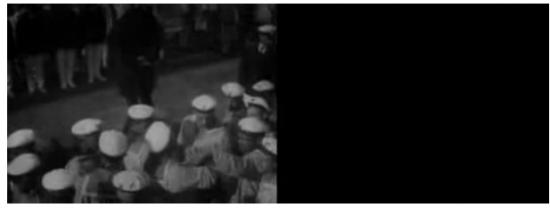
.re_potemkin does not follow the classic crowdsourcing model of an open call for volunteer labour on the internet. It was produced by many groups, but in a closed community. It functions more as an allegory of crowdsourcing than as a literal example of it, but this adds to the project artistically, creating a layer of depiction. The means of production are aestheticized in a way that presents them for the viewer’s consideration in way that can be understood and contemplated more easily than an amorphous internet project.
The “commons based peer production” of free software and free culture is not, to use Jaron Lanier’s phrase, “Digital Maoism”. But the comparison is a useful one even if it is not correct. Utopianism was exploited by the Soviets as it is exploited by the vectorialist media barons of Web 2.0 . re_potemkin gives us side-by-side examples of communism and crowdsourcing to consider this comparison for ourselves.
Within the work the similarities and differences between the original film and its recreation vary from the comical to the poignant. Students in a play park acting out shots of soldiers on a warship, hands placing spoons on a table cloth, crowds gathering around notice boards. This isn’t a parody, it’s an interrogation of meaning. And it is a strong example of why political, critical and artistic freedom is at stake in the ability of individuals and groups other than the chosen few of the old mass media to organize in order to refer to and reproduce (or recreate) existing media.
The text of this review is licenced under the Creative Commons BY-SA 3.0 Licence.
Image: SMartCAMP logo, all images courtesy of SMartCAMP
Part of New York’s Art Week, SMartCAMP, or social media art camp, took place on March 5th and 6th, at the Roger Smith Hotel in New York, a slightly unusual kind of place in that it’s a hotel with its own production company. That company’s artistic director, Matt Semler, who is also the director of The LAB Gallery, became interested in the ways Roger Smith marketers Adam Wallace and Brian Simpson were using platforms like Facebook and Twitter to build an online community. According to Semler, his curiosity “ultimately led to more questions than answers and we found ourselves wanting to bring the leaders in the social media (SM) art world together to talk about their process, goals and best practices. Once we came up with the name SMartCAMP we were pretty much off and running.” Conference organizer Julia Kaganskiy of New York’s Arts, Culture, and Technology Meet Up curated SMartCAMP’s program and a former actor, Danika Druttman, handled communications for the event.
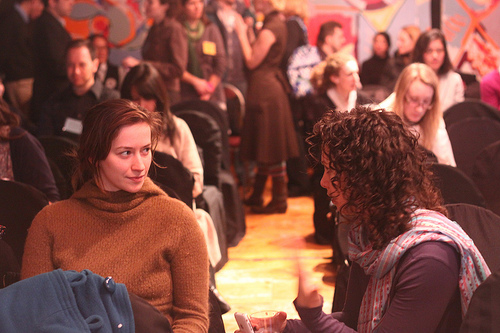
In other words, from the beginning SMartCAMP was about people, people who post, blog, tag, add, and tweet, but above all, people who meet and link up through quirky, often unpredictable, circumstances to pursue a shared idea. According to the speakers in SMartCAMP’s program, this is the kind of easy serendipity that gives social networks their authenticity and value. While these qualities can’t quite be summoned, they can be encouraged and directed. For artists and administrators, the question is how to sustain these connections to build audience and patron loyalty. Whether you like the idea of artists taking on their own distribution, or whether you find it somehow uncomfortable, social media is influential and growing. As more than one person pointed out, social networking has surpassed pornography as the number one activity on the web.
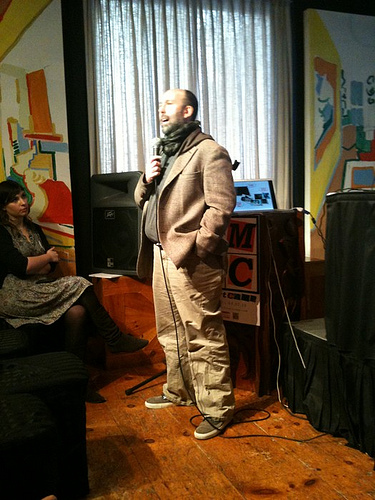
Mark Schiller’s keynote opened the Saturday session. Well-known in the New York arts community, Schiller is the founder of The Wooster Collective, a public arts site that documents street art from around the world. Like many successful online projects, Wooster Collective began accidentally. Out walking his dog in his downtown neighborhood, Schiller began photographing street art, which he then posted online, forwarding the link to friends, and asking for their reactions. Soon his web page was managing hundreds of photos, receiving thousands of hits per day, and turning artists into online celebrities. Two Wooster Collective discoveries that have gone viral are Josh Harris, famous for his subway grate inflatable dog, and Jan Vorman, an artist who uses Lego bricks to patch crumbling city walls. Today, after eight years of posts, The Wooster Collective is the online authority on street art. Schiller receives a self-sustaining five hundred emails a day from artists who have done work, or have seen work, and would like to contribute. Wooster Collective also has a YouTube channel and a Twitter feed.
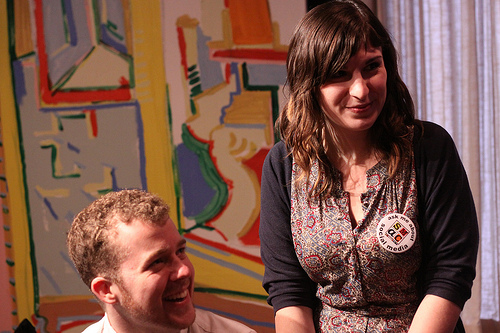
In many ways Wooster’s success seems unpredictable and non-reproducible, a fad, some kind of dumb luck. Yet, in retrospect, Schiller is able to point out specific qualities that made the site popular. First, there was page rank. Since no one was writing about street art in any other media, Wooster Collective’s art tags quickly went to the top of the search engine indexes. This kind of self-reinforcing rank allowed Schiller’s blog to get more traffic and, consequently, to pull more traffic from user searches. Second, ninety percent of the content on The Wooster Collective was original, making Schiller’s blog a feeder for other arts pages, increasing its incoming links and, again, boosting its reputation and its rank. Third, there are no ads at all on the Wooster site per se, mostly, Schiller says, because ads would be distracting both for him and his followers. Free from ads, Wooster Collective has no traffic stats to maintain, meaning Schiller is free to indulge himself in what his readers like best, Wooster’s own weird personality. On most days the site wavers slightly between media outlet and community bulletin board.
However, as important as his community may be, Schiller explained that Wooster readers are actually heavily restricted. The community is largely passive. Readers can email, but they can’t comment, upload, or see who else is online. Although some of site is user generated content, sites built on user content are notoriously second-hand and boring, so reader contributions are very heavily curated. The result is a blog that remains personal and interesting to all. Schiller also says audience building on the Wooster site has always been secondary to his main mission of sharing a passion for street art. According to Schiller, that passion is what works online and the effort to express it means a willingness to try anything. After all, Schiller reasons, “if you don’t like it, you can always stop. If a projects takes more than ten minutes to finish, stop. If it’s not fun, stop. If it’s not inspiring, stop.” Finding podcasts “not fun”, The Wooster Collective recently quit making them. They quit making mobile apps too. Schiller suspects that it is the resulting cheerfulness, lack of strain, exuberance, or even silliness, that connects an audience to a blog, a pursuit, or to an artist.
For Etsy, an online site where artists sell their work directly, community came first, web presence second. Anda Corrie, manager of Etsy’s Twitter feed, explains that Etsy was started at a time when the DIY arts culture was strong and growing, but artists still had few outlets for what they made. Etsy was one of the first sites to give them that outlet and, for a small commission, the site benefited greatly from its fortunate timing. Still, there is a balance between artist and audience that sustains Etsy and makes it work. In addition to responding to community needs, Corrie notes that the governance of sites like Etsy should be as transparent as possible. She reminds media managers rushing to reach out to remember to build a way for their readers and followers to reach in. Etsy uses a community council model. Councils change monthly, giving suggestions for improvements to the site and its forums. This is a time consuming model to attempt but, like Schiller, Corrie feels media planners who go through the motions without really getting involved are unlikely to succeed.
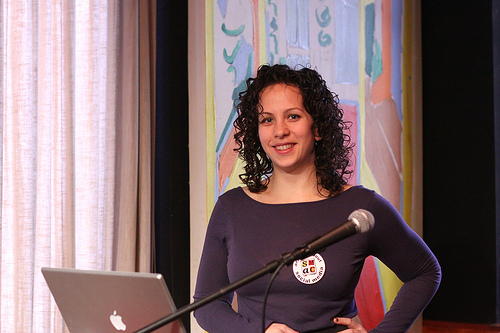
Michelle Shildkret, who represented Cake Group would say that you can’t fake what you are online, just as you can’t hire someone to “make you go viral”. She advises artists to slow down, figure out who to reach out to, where they are online, what they do when they’re online, and how someone might get their attention. When you can answer those questions, you’re ready to approach a social media plan. Shildkret also believes that a small, engaged community may be better than thousands and thousands of disinterested friends. Choose to introduce yourself and your work to places you like, make a difference there first, then advance slowly. John Birdsong of Panman Productions says artists often need to open up in exchange for popular attention. Birdsong endorses the strategy of a behind the scenes look at a studio or art process by posting “making of” videos to UStream or YouTube. These sentiments were echoed by others. Natasha Wescoat, a writer for EBSQ, the self-represented artist’s blog, became obsessed with eBay auctions as a community college student. Wescoat noticed that what honestly attracted her to an artist’s online profile was not necessarily the work. As an audience member, she also wanted personality, a connection, and some sense that there was a real person behind the presentation. Where Schiller describes a community that grows out of a shared passion, Wescoat sees community as a group centered on personality. Like Schiller, she encourages artists to try all ideas, continue with what feels right, and allow a web identity to evolve over time. For example, Wescoat describes her own online identity as an arc with three phases: experimentation, where she tried different approaches to making and selling work; narcissism, where she spent a good deal of time showing how the work was made; and establishment, where the size of her online audience is large enough to attract commissions from corporations and collectors.
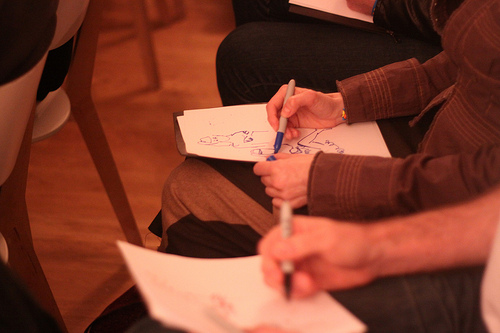
Sharpie sketch queen and self-described “art school drop out” Molly Crabapple credits her web personality as fundamental to a full-time practice that draws commissions from the New York Times and Marvel Comics. Founder of Dr. Sketchy’s Anti-Art School, Crabapple introduced her online persona by compulsively posting to LiveJournal. Today, her favorite platform is Twitter and her media tool of choice is the one hundred and forty character tweet. Crabapple likes Twitter’s immediacy and tweets to get illustration suggestions from her followers, to find emergency crash spaces, and to “manifest” anything. She advises underrepresented artists to do whatever it takes to build a following online: friend friends of friends, promise to perform humiliating stunts for your followers, tweet about everything you do, reward your one hundredth or one thousandth follower with some kind of gift, a sketch or drawing, for instance. When the earthquake struck Haiti, Crabapple tweeted for drawing suggestions, drew those suggestions live online, then auctioned those drawings off in a benefit for Doctors without Borders. Yancey Strickler who co-founded the microfunding platform Kickstarter goes a step further. Kickstarter allows artists to post projects online and request small funding pledges from their followers. These pledges remain virtual until the project pledges reach full funding. At that point, sponsors pay up, the project is funded, and Kickstarter receives five percent of the amount raised. But pledge money is not always a reflection of your project pitch, Strickler points out, saying that what succeeds online is a good narrative and a connection with the audience that feels authentic. According to Strickler, people on Kickstarter are only somewhat concerned with the quality or originality of the work in front of them. More often, their decision to contribute to an artist’s goal proceeds along the lines of questions like “Do I like this person?” or “Could I be friends with this person?”.
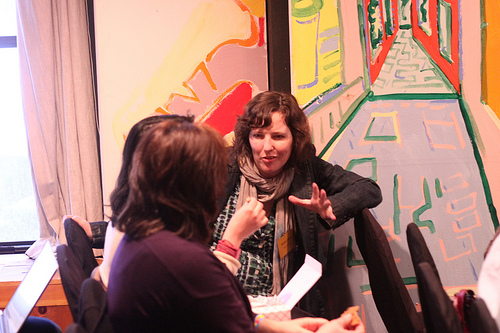
If all this sounds a bit disingenuous or self-serving, remember that social media connects artists and audiences directly and that this connection now has its own considerations. There are some dangers in its manipulation, but the benefits need to be recognized. Adam Smith of Dance Theater Workshop’s and the New York branch of the Neo-Futurists uses blogging and community choreography as forms of outreach. While there are no hard numbers for increases in audience through the blog, DTW’s paid audience has gone from sixty to eighty percent of the house. Working on getting the tools right isn’t necessarily a negative and will probably take some work. Dancer Lisa Niedermeyer says: “You can’t just be clever, you have to be smart, and that none of this has been around long enough for any of us to be wise (yet). That any one experiment can be clever, and with speed and easy access can go live, but it takes being smart for it to be sustainable.”
Niedermeyer works on Virtual Pillow, the tech initiative of Jacob’s Pillow Dance. In some ways Niedermeyer considers the company’s online presence a fourth stage: “A global, interactive space serving a virtual community that might not ever be able to physically visit us in the Berkshires of Massachusetts, but highly value our archives, performances, professional school, creative development residency programs, etc.”
A second part of Virtual Pillow’s mission is to bring the work of the company, including its history, to a wider audience via social media, streaming sites, or any other online platform. Niedermeyer attended SMartCAMP for the chance to hear other institutions and artists discuss what worked and what did not. She says the conference gave her more perspective on the strategies available to Virtual Pillow: “I felt that the conference speakers and participants were really talking about the big picture, big ideas. Gravity Rail, for example, with their passion to explode open and transform eCommerce models for artists.”
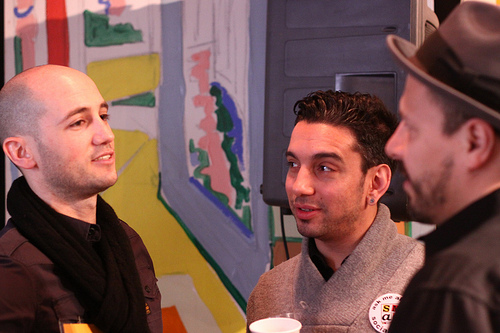
Performers are not alone in the need to link up. According to Nancy Proctor, the museum is a distributed network whether curators accept that idea or not, and agile use of social media is essential to responsive curation. Proctor heads New Media at the Smithsonian American Art Museum, a museum which now gets more visitors online than in person. Are those online visitors any less real? Should their visit be any less satisfying? Should their use of the museum be any less respected? Noting that desktop activities are increasingly moving to the mobile web, Proctor urges curators to meet visitors where they are through sms, tweets, and mobile applications.
Examples of another kind of user centered curation came from Titus Bicknell, founder of pinkink, who believes audiences and their questions now lie at the center of any program strategy. Bicknell’s examples of user centered curation included a podcast that asks visitors to enter a space, look at the art, and record any questions they might have. In this curation model, socially aware programmers ask audiences what they would like to know, rather than telling audiences what it is believed they should know. Allegra Burnette, Creative Director of Digital Media at MoMA, pointed out excellence in web presence like the Indianapolis Museum of Art’s fine arts blog ArtBabble, but added that MoMA uses Twitter feeds specifically to talk about current exhibitions at home and elsewhere. MOMA also offers podcasts on iTunesU where, Burnette says, downloads have increased about ten times this year. More and more, curation extends beyond the exhibit to the conversation about that exhibition, a conversation that defines your institution on the social web through bookmarking, favoriting, collecting, sharing, recommending, and searching. Like the Wooster Collective’s Schiller, Burnett advises media managers to avoid blatant marketing and to discuss events of interest to readers whether those events are part of a home exhibition or are occurring elsewhere.

Even in competition with Arts Week, SMartCAMP sold out. In addition to a long list of good speakers, there was a great deal of conversation and connection going on across the seats, in the halls, throughout the lobby and meeting rooms, and at the bar. Absolutely no one was asked to turn off a cell phone. Executive producer Matt Semler says: “We trended on Twitter both days and ended up with 120,000 individual views on UStream. The audience was very nicely mixed. While we don’t have any specific data on demographics my impression was that the room was evenly split between art executives and artists.”
In April, Semler and Roger Smith Arts will present a cello performance by Peter Gregson from within a Morgan O’Hara installation inside The LAB gallery space in New York. As Gregson plays, O’Hara will perform one of her “Live Transmissions” of Peter’s performance. The event will be streamed live over UStream and, as with all LAB performances, will be viewable from the street as well.
Featured image: An interview with Chris Dooks, a ‘Polymath’ exploring various creative avenues, making his art using different media.
One of the many interesting and rewarding elements of being deeply involved in what, I’ll loosely term as ‘media arts’ practice, is the breadth of imaginative people you meet along the way. We first met Chris Dooks in 2005-6, when he worked with us on a project by Furtherfield called 5+5=5. We commissioned 5 short movies about 5 UK-based networked art projects exploring critical approaches to social engagement. These pieces offered alternative interfaces to the artworks and the every-day artistic practices of their producers. Including the motivations and social contexts of artists and artists’ groups working with DIY approaches to digital technology and its culture, where medium and distribution channels merge. Chris produced a film-work for the project called Polyfaith. A Psycho-Geographical Web Project introducing the beliefs and philosophies of his (invented) friend Erica Tetralix.
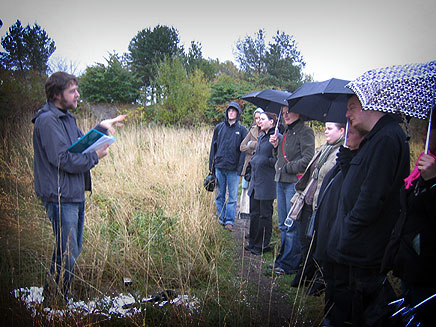
“My friend Erica Tetralix died. She gave me the task of fulfilling her dream which was that people would enjoy the parts of Edinburgh that were so dear to her in her life. She also loved tourists and sympathised with people on a budget, so she devised, with my posthumous help, this free way to enjoy the city. It’s a beautiful gift for both transients and residents. It’s popular with backpackers, parents and children, cultural groups and well, basically anyone.”
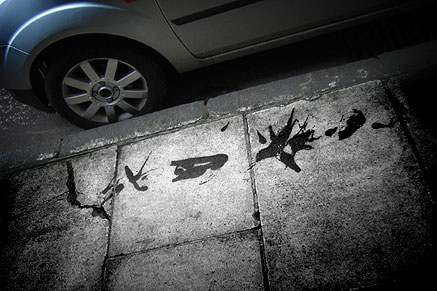
Later on we discovered that the name Erica Tetralix, is actually a name of a plant. Often called a cross-leaved heath, a species of heather found in Atlantic areas of Europe, from southern Portugal to central Norway, as well as a number of boggy regions further from the coast in Central Europe.
To view Polyfaith visit link below:
http://furtherfield.org/5+5=5/polyfaith.mov
The value of an interview is that it can serve as a useful documentation, a process allowing a kind of unfolding of time, All layed out in front of you. The reader can experience not necessarily a retrospective, but a dynamic and creative life and a personal history openly shared, on their own terms.
This interview reveals various levels and approaches by Chris Dooks. An inquistive and playful mind is at work here, engaged in exploring across different forms of personal agency, as well as redefining his practice in relation to the world he exists in, and the people he comes across in connection to various projects. His art is not a singular activity. Meaning, he does not rest in one particular art genre or movement. Instead, we are asked to acknowledge a personal enquiry formed from different engagements and choice of mediums, which happen to meet his creative intentions and questions at the time. We are all relational beings and Chris Dooks is a clear example of how this can work in an artistic context.
The Interview:
Marc Garrett: Many out there will already know you as a professional film maker, directing arts-based TV documentaries such as The South Bank Show in your twenties. Since then, you have developed other skills involving design, composing and making music, audio visual installations, explorative psychogeographical projects, as well as continuing making films, and you’ve even got a record deal. You have as far as I can gather four different music projects curently on the go, your electronica group BovineLife, an architecture music project known as As Ruby’s Comet, Feible for laptronica and also the Audiostreet project featured at The Leith Festival.
Chris Dooks: It’s amazing how many people still know me from Bovine Life which was a moniker I used for an internet audio project way before broadband in 1999. It’s the tenth anniversary of my bip-hop album SOCIAL ELECTRICS and I would like to make all my albums available for free for furtherfield readers. Don’t let itunes rob me of any money! The transition to musician was down in part to the South Bank Show when working with Scanner. I was really frustrated at making work about musicians. And the technology was making it easier for folks like me without a classical training. Here are three for you for free – check links below for free tunes at the bottom of the interview.
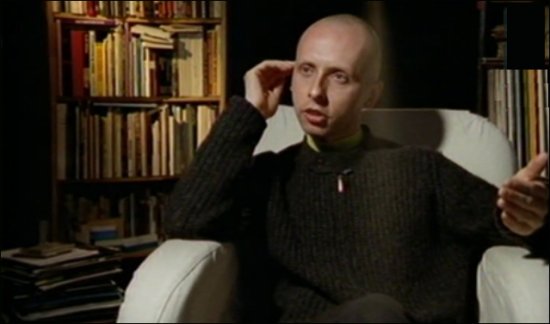
South Bank Show UK television documentary directed by Chris Dooks, featuring Robin Rimbaud speaking about his practice and ideas. 1997. Click here to watch video.
MG: In The Glasgow Herald, in Scotland a journalist called you a Polymath. Even though you were delighted to receive such a compliment in the local press, you decided to re-edit the term, reclaim it so to make it less seemingly mathmatical. Prefering Polymash because it sounds “friendlier, resourceful and potentially charming.” Sticking with this notion of you being a Polymath or rather a Polymash. Your diverse approach in creating art works in a non-singular approach, is a core element of your practice. I was wondering whether this is a deliberate decision or a natural and overall state of being?
CD: It’s weird though, I learned more in my background as a wedding videographer aged 14-19 (35 weddings at weekends!!!) than on any other course. Doing weddings gives you various skills as a digital artist. Fuck a film degree! As a wedding videographer, you need to be able to mike the vows in difficult audio environments (i.e. reverby spaces), film it about fifty feet away, liaise with highly emotional temperaments, be like a war photographer – it’s only gonna happen once, miss it at your peril – and stay sober. Not to mention edit it at a time when non-linear editing was non-existent, (I remember the heady days of “crash editing” between two panasonic VHS machines) white balancing everything on manual heavy equipment and creating all the graphic design and labelling of tapes. I was like a teenage record label!
So in 2009 when I made www.studio1824.com – making a record (netlabel) for an icehouse in Sutherland (remote Scottish Highlands) I got a kind of deja vu experience. Only with an education and life experience in the mix now.
When I was 8 years old, I had two epiphanies. One was that death is really gonna happen, and two, that cinema is wonderful, emotional and that it offers us a naive form of immortality. Cinema was the only artform that even at that age, I felt could make me feel…spiritual, for want of a better term. I became quite religious.
I was obsessed with super 8 cameras and video. And now I am trying to get all my pre-teen works tracked down! But even at this stage there was always a healthy distraction in other areas. I wouldn’t get involved with narrative and this has never been my strong point, even though I was reasonably good with words. My uncle played a lot of classical music and my dad took me all over the UK in his lorry, and at this time I won a scholarship to play the cello at school with the posh kids, being the other three. (It was a working class music “initiative”) But alas, I didn’t realise how lucky this was for me. So I went back to making videos, this “poly” approach was probably set quite early. I remember doing a kind of pre-Blair Witch thing when I was 14 and I would get sidetracked into filming the shapes of the leaves and the sound of the wind. Then I realised that the material didn’t make sense in the conventional sense. So I became an aesthete of kinds at an early age. And in every way, from Granny’s trifles and an early lust for Kate Bush, I was concerned with the sensual world. But until 22 I was monogamous to film projects and would work as a corporate director in the art school holidays to fund my college life, with the odd wedding video thrown in. By the time I did my film degree at Edinburgh College of Art, I was much more interested in people like video artists Bill Viola, Gary Hill and Daniel Reeves – (I met all three) via the “team-building” world of film shoots. Bill Viola’s THE PASSING changed my life.
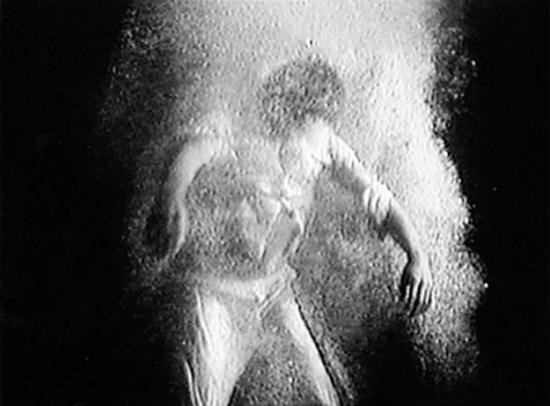
The Passing, 1991. In memory of Wynne Lee Viola. Videotape, black-and-white, mono sound; 54 minutes.
Pre-degree, in those days (1989-91) you had to REALLY know your kit and be a good all rounder. I trained on huge Umatic machines and did a BTEC before a degree. I was from a part of a culture where there was no film degree, and I was a couple of years behind my peers. But by the time I hit ECA, I could mix radio programmes, edit timecode, black and white balance studio cameras and location kit and I spent most of the time buggering off to the hills to film Scottish waterfalls. I might have been techinically proficient and this was behind the poly approach to an extent, but I had bugger all conceptual skills. These have only really solidified in my thirties…
MG: Lets talk about the Surreal Steyning psychogeographic audio tour, part of the The Steyning Festival in 2009. On the web page for the project is written “This tour is simply a different way to skin the proverbial cat. In this case, the cat is Steyning. In fact, if you think of Steyning as a cat, you are already a psychogeographer. Well done. You’ve engaged your psyche with geography. You’ve mapped the town conceptually. The High Street becomes the cat’s spine with the head chasing Mouse Lane. Now you are in the same company as such artist groups as the Situationists, the Dadaist Movement and other high fallutin ripples in art tourism, and even The Ramblers.” Did those who took part manage to understand and appreciate where you were coming from? Also, how did it work?
CD: There was a tiny degree of spin with the site’s headline Traditional English Town Embraces Conceptual Art Walk but by and large folk did embrace it and it would have been patronising not to drop a little sand in the vaseline, not to deliberately challenge, because the Steyning Festival, was, I felt, in danger of being a little like a tasteful village fete. A good fete I might point out, so this year, there was something brave about them putting a conceptual artist at the heart of a residency in the village. English villages like Steyning were not and are not, all tasteful. Whenever I encounter these tasteful expectations in the arts, I think of that Stereolab song, Motoroller Scalatron with it’s chorus “What’s society built on? It’s built on blood. (some say the lyric is “bluff” not blood but either way it works)” So I saw my role not as a socialist historian, because I wouldn’t have a clue, but as someone who encourages an enquiry per se into unusual histories, paganism, aesthetics and philosophies of very local travel. I mean, I don’t think there’s anything angry or unloving in the tours. In fact, I try to make them about folk being nicer to each other. These activities have a small socialist agenda but as a performer, I am not exactly Stelarc, slashing my wrists in the street. I’m not about shock! However, this tour had a couple of “jaw droppers” (See The Steyning Star on the tour). The main outrages came from people who wanted a straight history tour and were not given one, depsite my first words on the tour saying “this is NOT a history tour!”
Example taken from section 4 of the The Steyning Star on the tour:

“This is Brotherhood Hall, built in the fifteenth century and now part of Steyning Grammar School. Look closely at the symbols which adorn the gables. They may look like simple decoration to us, but these markings are rather unusual. They have been the subject of no fewer than three PhDs, and for a century the world’s leading symbologists have engaged in hot debate over how to read the meaning of them. One of the most important questions is what shape we are dealing with. While some people see predominantly circles, others see squares and diamonds, rather like those tiles that everyone had in their bathrooms in the 1970s.”
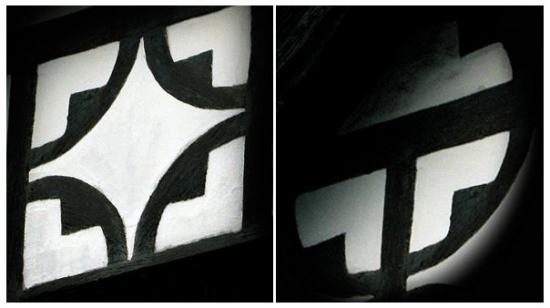
“Was this a pop premonition? For some time it seemed so, and this remains a strong theory. But in the mid 90s the school took part in a German exchange programme, and visiting German students proposed yet another alternative. When they looked at the patterns on the gables they saw a cross drawn within the circles, or a gammadia, to be more precise. A gammadia is a cross voided through, or a cross formed with four of the Greek letter Gamma. It looks a bit like an ‘L’ to us. The swastika is the most famous example of a gammadion. The German students believed that this was not a pop premonition at all, but a foretelling of the success of German heavy metal band Gamma Ray. This theory also gained popularity among members of the school’s very active astronomy club.”

The festival had hired a PR person to market aspects of the festival and commission an artist, and so I was brought there with a little Arts Council of England fund, so felt obliged to make work with the tools I’ve been developing – or my “brand.”
Nothing was watered down simply because it was a village (it’s actually a town but it feels like a village) because it would have meant compromising the ideals or enquiry, of looking deeply and into the areas of my interests of paradolia (faces in chaos) and simulacra formations (things that appear to be other things).
Most of them got it! I mean, it was nearly two hours long and they stayed till the end, although it did split the audience, but not badly. 2-3 out of 20, left. We had to do it again the next day due to popular demand! The ones who stayed had smiles on their faces by and large, which made me very happy. The weird thing was, not once had it been stated that it was a “straight history tour”, and it should have been obvious within the first thirty seconds that I make some of the stories and hypotheses so outrageous that surely this is tongue in cheek? However, I had written some slightly anti daily mail sentiment in it and two or three people angrily walked out of the tour. I got that wrong. It’s a Tory (conservative) heartland, and I don’t think you can be an artist and right-wing, you are just too aware of the world, but I should have considered this aspect more.. My landlady was one of the people present in the audience and she walked out, that upset me a wee bit.
But there’s something about my personality that makes people trust me in my tours, folk are quite sweet and gentle perhaps. The message behind the tours is one of re-imagining everything you hold to be true. The motivation behind these tours is to see travel as something that can be done anywhere. People go to the other side of the world to enrich their lives, many don’t even journey over to the other side of the street, or drive through a different part of town! I find that hilarious. So for me, psychogeography is about the chicken crossing the road..
If we can’t even do that, what hope is there for atheists like me (who find Buddhist philosophy and its practice the only religion without the conceit of the other big hitters) who are forced to approach the world from multiple angles, because we can’t accept the idea of monotheism and monotheistic thinking. This single mindedness of approach, when challenged (not just in religious people, but people stuck in their ways) is bound to create a bit of friction even on a playful level like in Steyning.
I became invloved in Surreal Steyning based on another project, in Brighton, where I made several songs about a building on Brighton sea front. This was a song cycle, based on a very specific bit of geography.
There is this idea that psychogeography is only urban – but I prefer to bring this intense work to the home counties! After all, the whole point of being an artist is to see through the privets, the darkness of the forests. So while I was in Steyning I was reading about Alistair Crowley and witchcraft and when Steyning used to be a port – it’s now land, ten miles inland! In the middle ages everything was different. I think a lot about how many contemporary English folk in these wee villages don’t realise their own foundations. I found Steyning a really charged place and not just a twee place to get (admittedly excellent) cream teas and real ale (a bit flat for my northern British palette).
This was, without a doubt though, the most successful public psychogeography tour I had done, even more than Polyfaith. There have only really been three tours – Polyfaith, Select Avocados and Surreal Steyning. And Surreal Steyning learned from the other two – so I had my schtick by then. I think it’s the best executed one so far. Let me be clear, I care about the audience. I adapted to their demographic, their language and their refinery in this tour, but I really care about people, but what I hate is bigotry and there was a little bit of friction about some of the left-wing ideas in the work and some of my own goals. But they needen’t be upset by a Middle East reading of a thatched cottage, the similarities of Tudor graphics and the 1990s version of the Take That logo, and the roof of some flats that might look like an arrow.
MG: This critical approach of consciously making room within yourself to understand or at least appreciate the sensibilities of others, surely it must be a difficult task to accomplish? What I find fascinating about your engagement with the public is the measure of respect for them, mixed with a healthy level of detournement.
Thanks! I actually think it’s a big complement to have the public stay on a tour for up to two hours, or buy one of my records. So I’ve really tried to attack attention-deficit tendencies whenever possible. It’s also my grammar. I don’t really do critical theory, although to apply for money you need to know where your bit of culture fits in with others. I really dig a good bit of popular culture. I think the best stories in our culture in the UK can all be seen on Jimmy McGovan’s The Street. He is a master of audience respect. Also, I feel confused by a lot of art, so I like to call a spade a spade, unless I am in a surreal mood and I’ll call it a Sad Ape (Sad Ape is an anagram of A Spade).
I had a slightly uncomfortable childhood and adolescence That “public” thing comes from Teesside. I also particularly like North of England humour – and actually I really like it when “clever shits” (to quote my Granny RIP) get usurped by that kind of spit-and-sawdust philosophy. There’s something survival-like and super-clever about grass roots humour because it comes out of neccessity. So I think my own personality is a bit of art school but with angry chips on both shoulders. It’s why working in Scotland is great, because the Scots hate bullshitters – especially the Nathan Barley set. I always found that very attractive. I remember seeing and being heavily inspired by Vic Reeves and Bob Mortimer’s first series and thinking, this is a dangerous combination! Northern swagger and charm! Dada! but with more academic kudos than might appear at first glance. And it was bloody funny! It was both alienating and accessible at the same time.
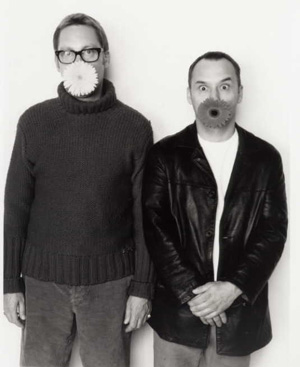
I grew up in Teesside and North Yorkshire and school never encouraged me really. I never had a bohemian upbringing, but I believed in the soul and went to Sunday School (my own choice – I was very religious for a kid). But I probably owe my interest in orchestral and “difficult” music to my uncle, and this was partly my first exposure to other worlds – I was particularly inspired by Bach’s Toccata and Fugue in D Minor. And I liked that piece because it had something I could relate to (the church organ), it felt something otherworldly – both the sustained drones and mechanical math-like, transcendental nature about it. And no words. I remember talking to my music teacher about it. She got all excited and presumed I could play it so she got me the sheet music to learn it. But I could never do it, I had no discipline. Anyway, that piece was amazing, spiritual to me. When you thought it couldn’t end, it changed scale and key and ascended to even more articulate heights, clever and gorgeously aesthetic at the same time.
I failed art. I grew up around lorry drivers, grandma’s trifle and Christmas at working men’s clubs. A lot of nice memories but I’ve always been looking for ways to sweeten the sour ones. And then, a huge affliction came. Around twelve, I started to have these really strong life changing shocks, like my psyche being ripped to shreds – just by thinking, enquiring, looking deeper. I would call them “dark epiphanies” later. They are still with me. Adulthood has not softened them. I’m always on the lookout for liberation! Like Russel Crowe in A Beautiful Mind he learns to live with his Demons and accept they are there! I’ll never get over these mortal messengers, but it’s what underpins all the puns and humour in the work. Tears of a Clown maybe? At the time, (aged 12-15) there were pennies dropping about mortality – real hopelessness of mortality. I’m still dealing with it. The problem is, because these visceral thoughts will never go away, I have started trying to make them my teachers. And all I want to do across all of my works is reduce anxiety – mainly my own – and look at multiple universes – and I think we forget that your street is part of the universe. That’s where the work begins, in your block, your local Lidl – these places should teach you as much about our ridiculous situation as anywhere else. It’s like that idea that “the environment” is outside somewhere, when really it’s in the most mundane places. The mundane is “supramundane” at the same time. It’s no wonder I became a Buddhist in my early thirties. I need to get back into it. I’m getting somewhere maybe.
MG: Perhaps, it is not just about re-inventing a selection of different mythologies, histories in relation to localities, whilst exploiting contemporary mediums; which includes elements of satire, a certain level of hyper-reality.
CD: I think it’s about a hatred of authority, not because we don’t need order, I think we do, but authority takes all the colour out of our history and culture. I watch X-factor, like Peter Kay (underrated surrealist like most comedians – despite the professional Northerner get up). I never liked punk and thought anarchy was really stupid! Civil disobedience maybe. I hate it when I see musos on the telly talking about punk, getting all nostalgic. Maybe the Clash. Maybe it’s the patronage of culture by high fallutin’ types I don’t like. Because patronage kills proper culture doesn’t it? And because of that, I never got passionate about history at school. It was a bit grey. So what do I do without the arsenal of the passionate historian? I make bits up and flirt with it. These projects mean I have to know bits of history now. And this bit is really telling – the bizarre thing about the hyper-reality aspects of my tours and other works – is that the bits I make up and flirt with – those bits are often scarily close to the truth. Also you say I’m really respectful to the public, but I like to push it a lot. In Edinburgh, on the Polyfaith tour, folk were swallowing my wildest tales about the city when they’d lived there all their lives! I came in under the radar I suppose. I like usurping the pompous stuff with a passion though, I really do, I feel it’s my duty!
MG: There seems to be a kind of niggling question in this work. I get a sense that this question does not only relate to asking those who take part, but also yourself. It touches upon something quite raw, authentic and complicated, and untouchable at the same time. I am not referring to the sublime here, it relates to all of our collective histories, on this earth. A Genealogical form of re-assembling, re-knowing and perhaps not knowing. Are you trying to make contact, or reconnect some how to a type of authenticity; if so, what does this look like in respect of your intentions?
CD: I want to find spiritual relief. That’s a terrible word – maybe the sublime is better. Fuck it, I want it back from the New-Agers. Even though I am a total Dawkins fan, and am partly liberated by looking deeply, I just want a bit of peace really. And the tours train me to think outside the box, that’s it. I suppose it’s like doing my own philosophy degree “in the field.” But there’s a bigger box I am being prepared for (see what I did there!). There’s not much relief. I am a highly charged person – some would say high maintenence! I’ve just seen the Andromeda galaxy from the back garden. I want more of that. This is a really hard life. I want to be less fat. I’m sick of having M.E. My wife is pregnant. Christ, I am going to be a father. Maybe that will help my afterlife woes. Men aren’t supposed to moan. I’m being genuine here though. I forgot to mention Derren Brown. I’d love to do a project with him. I am sorry these answers are not very articulate. It’s in the tours! Do them!? Seriously, do the tours.
MG: What qualities and values do you think or feel this form, process and working offers yourself, the world, art and culture on the whole?
CD: I look at my place in the digital arts as a priest being sent to a remote parish – so hopefully we’ll clean up here in Ayr, our new home! ha ha! A lack of funding might make that difficult but it hasn’t stopped me before. My current thoughts are… Paradolia and Simulacratic Forms as narrative agents for psychogeographical tours. The benefits of the sustained drone in music. “Dayglow” hues and man made fibres in landscape photography. High hills. The idea, place and value of the troubador in the present age and the potential of “singing the news” as a deterrent for media-saturation. My next project may be about folk-music and psychogeography, using local folk clubs to make popular songs based on themes by bloggers. Some of the things I think of, I sometimes see being made around the time. A bit of Zeitgeist, collective unconsciousness awareness maybe! I am also still digging around popular atheism and the atheistic roots of Buddhism. Folk-Art and the search for genuine Scottish culture as opposed to the much-touted facsimile. These are my daily concerns. A project that I should mention is Ayrtime. A series of eclectic cultural events presented in the heart of Ayr, Scotland. Gigs, Theatre, Literature, Astronomy & more – on this site you can find archives of the events with beautifully crafted podcasts!
My work offers me the stuff I was told at school really. No different to building or plumbing on one level. Just a sense of achievement and pride I suppose. Quite traditional aims. I remember a conversation with my dad in the last few years (we row a lot) in The Ship Inn in Marske. I asked him why he never wants to know about all these fantastic projects I’d done! And he said “Well that’s your work isn’t it? If you were a plumber we wouldn’t be sat here discussing U-bends” and at first, I felt slighted, I’m not a plumber I’m an ARTIST goddammit!! It made me think of The Cohen’s Barton Fink, human and pretentious character “The life of the mind, there’s no roadmap for that territory” but on reflection it’s quite good to be making this mad work in working class areas, to take my artist ego down a peg or two. Lord knows I need it sometimes because I have two fights generally – the first is the fight to get work funded and made and promoted and so on and it be stimulating work. The second is the fight with M.E. which I feel like I am totally on my own with a lot of the time. I get really unpleasant symptoms, often with no break for weeks on end. Sometimes I can only do 30 minutes of work in a day. Sometimes, even that is a pipe dream. I’ve had twelve years of this shit. I was directing arts documentaries for telly when I was well. The upside of the M.E. is that it is humbling. I’d probably be that Nathan Barley wanker by now, and I wouldn’t have touched the Buddhism, the philosophy, proper art and gotten arts council funding without the lessons I have learned.
Social Electrics 10 year Anniversay edition 1999 – bip-hop.
You Know, You Love Something Little – Lost Vessel 2002.
The Aesthetic Animals Album 2008 – benbecula records.
www.eleanorthom.com
www.karencampbell.co.uk
www.alanbissett.com
http://www.louisewelsh.com